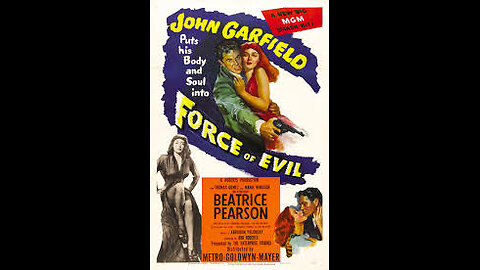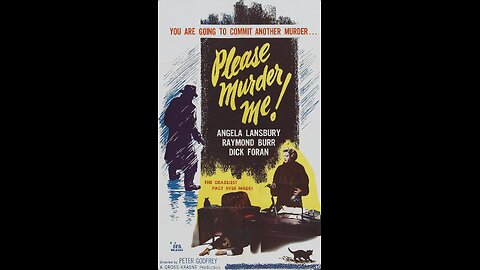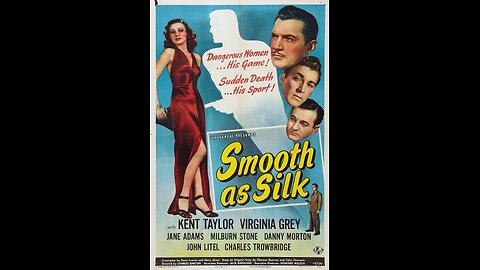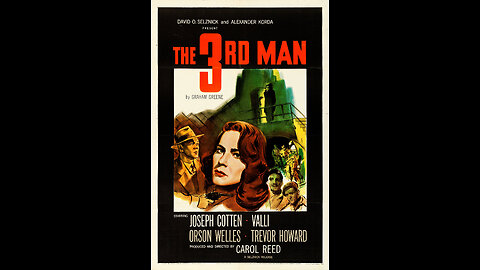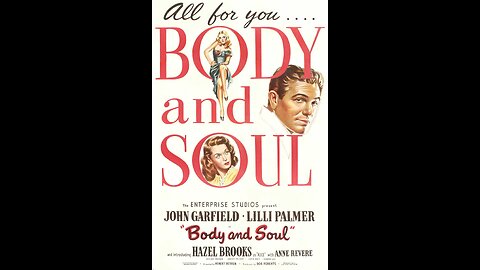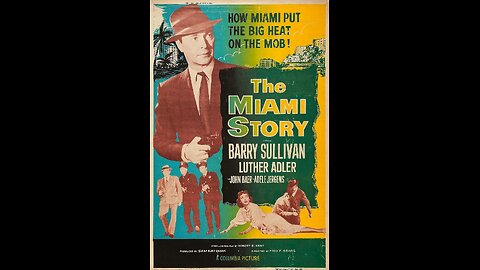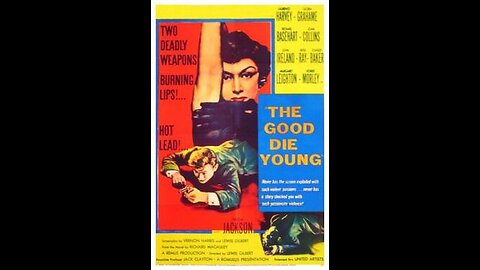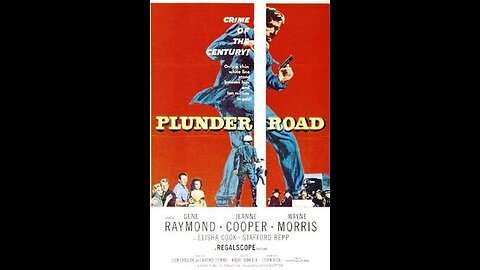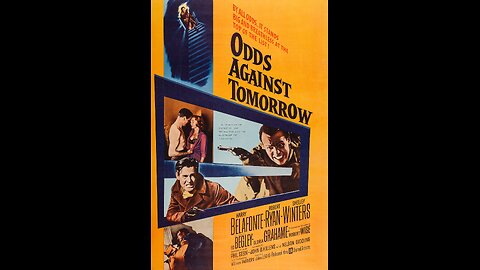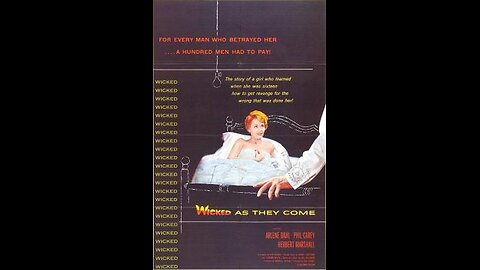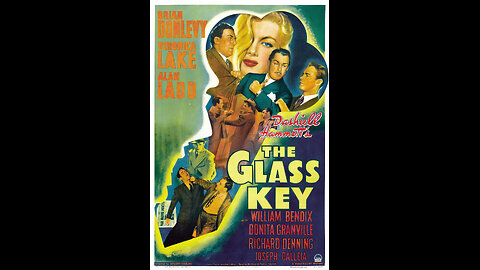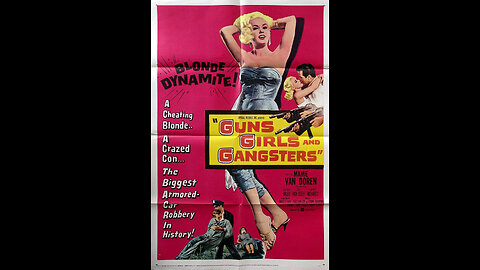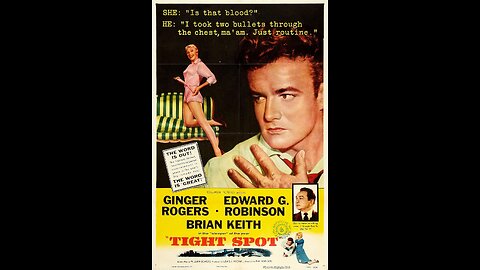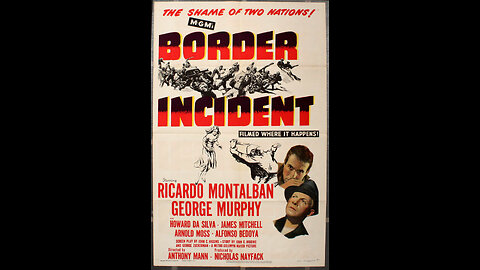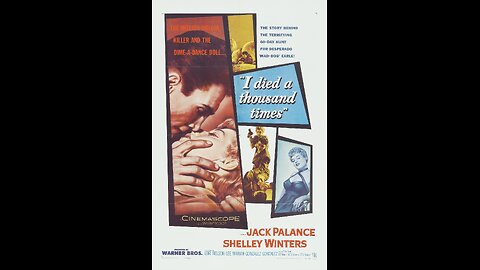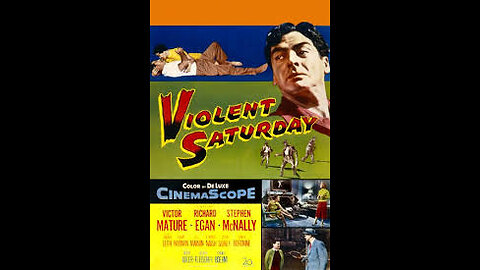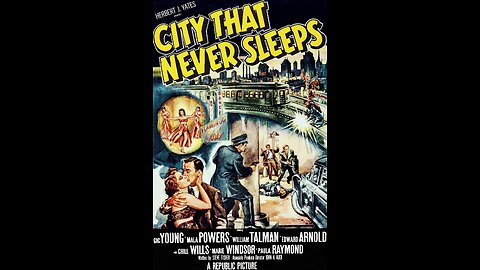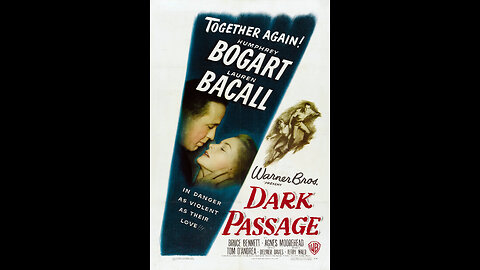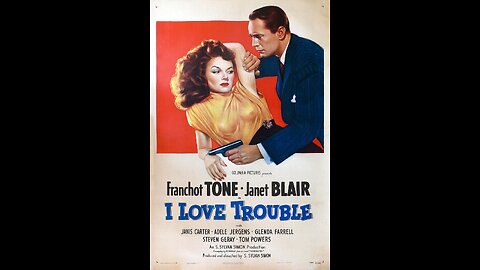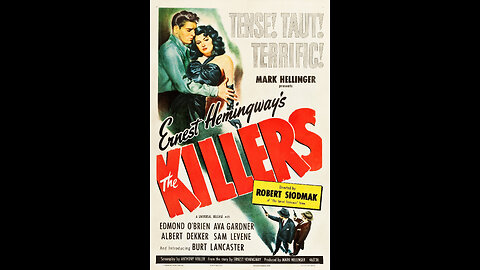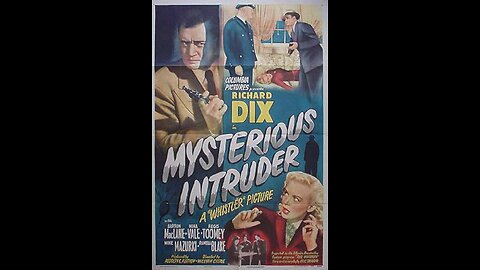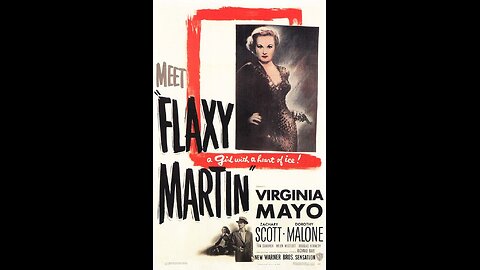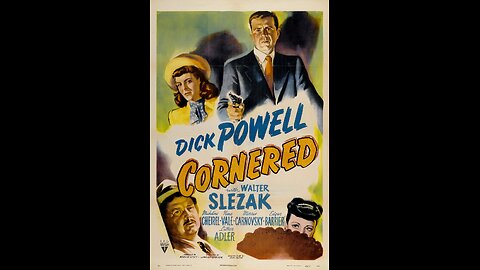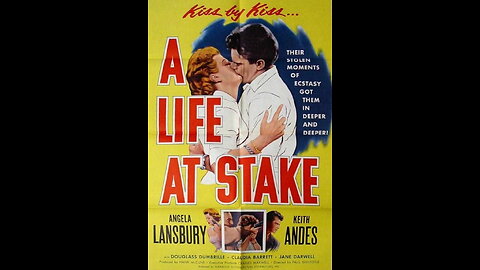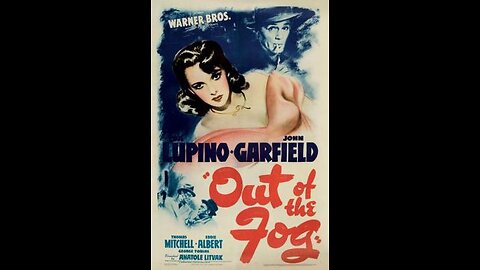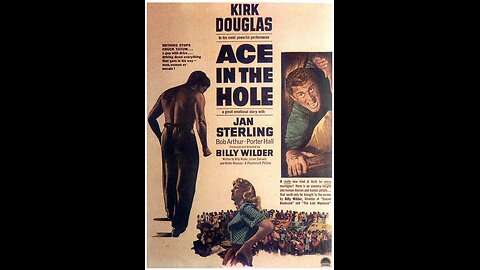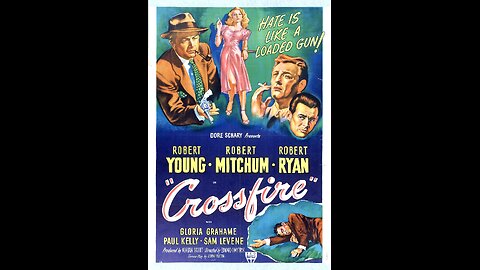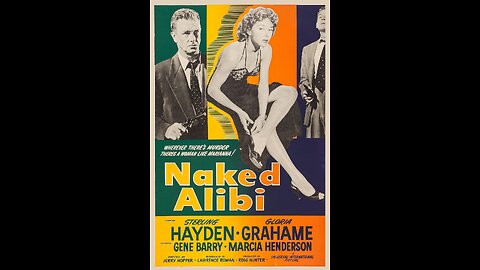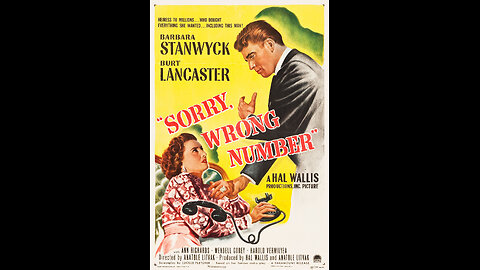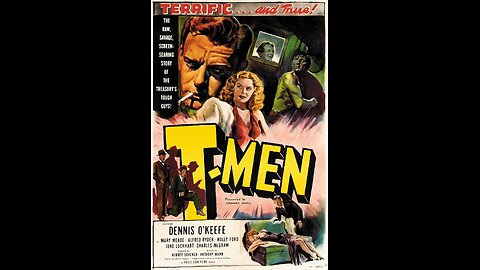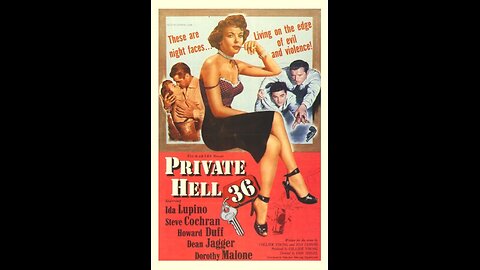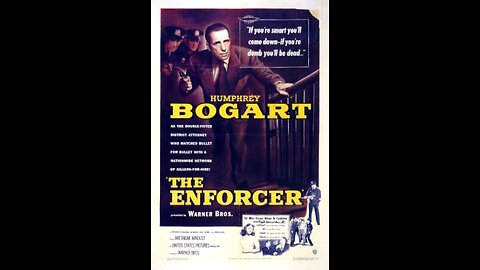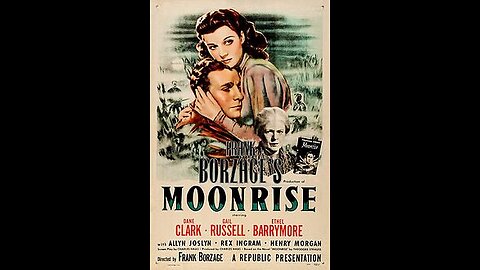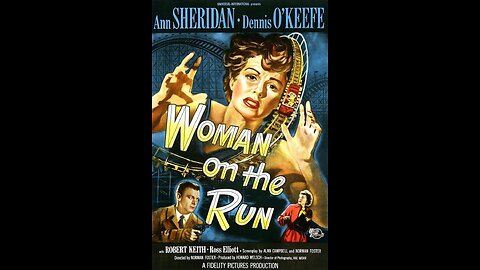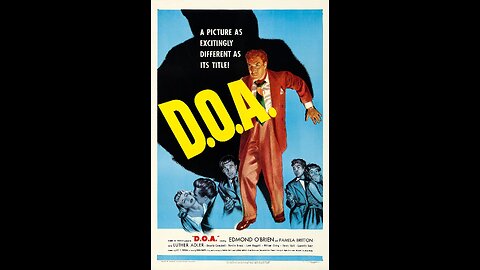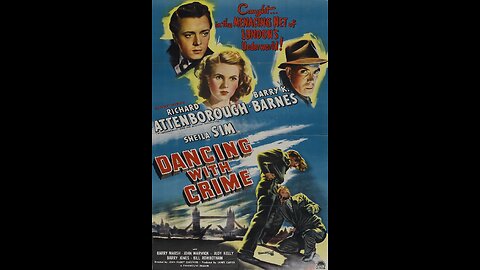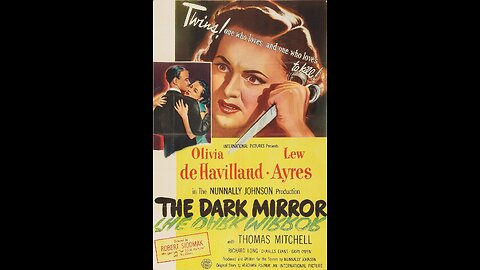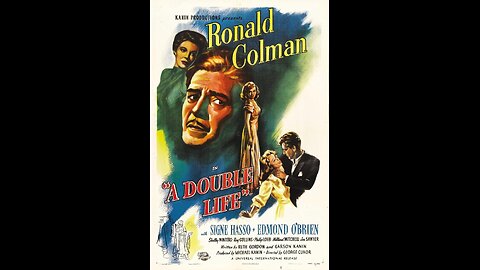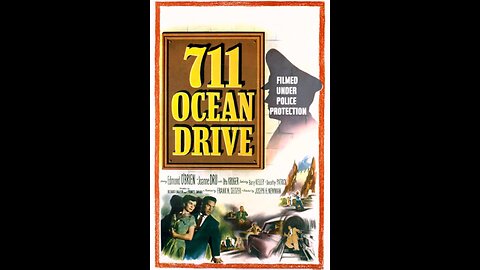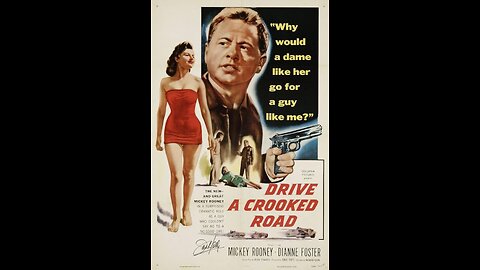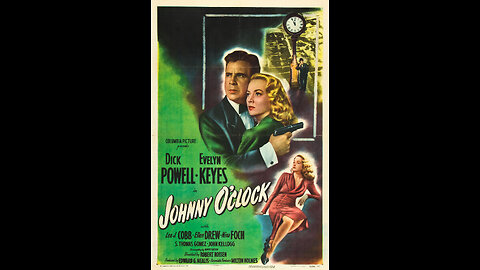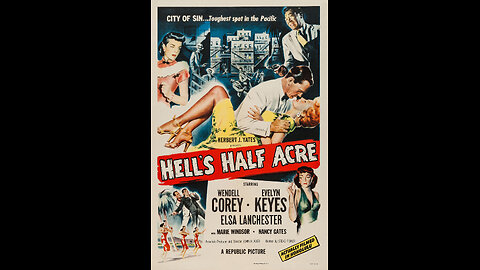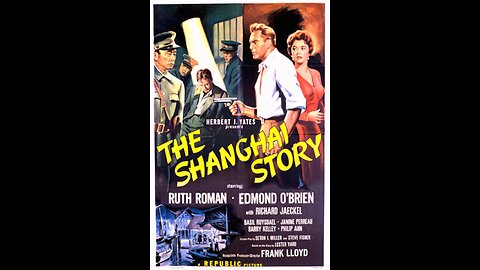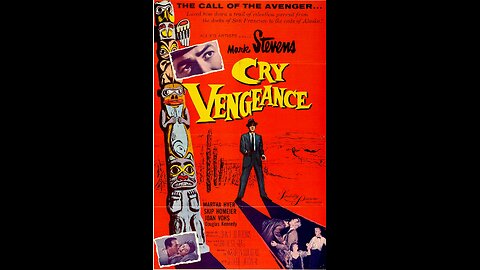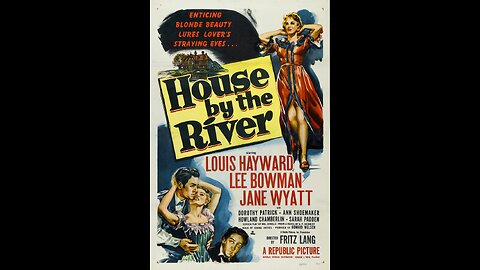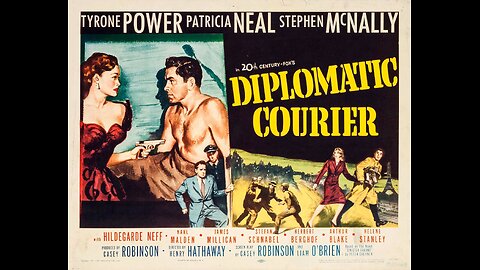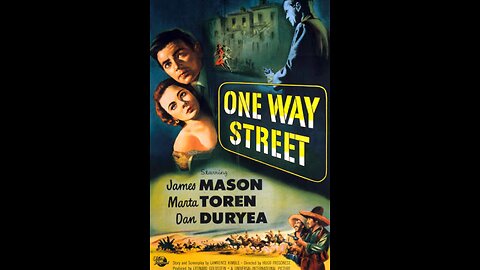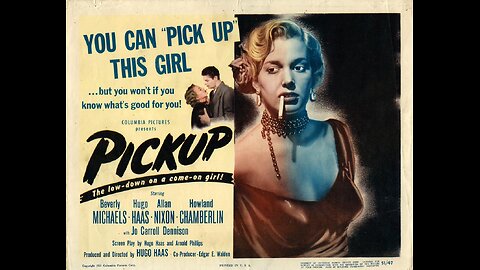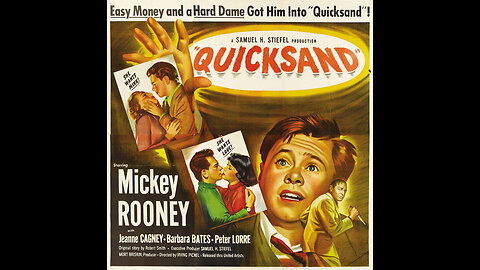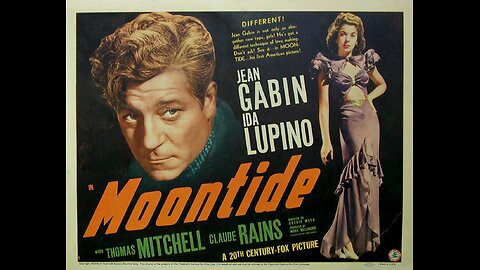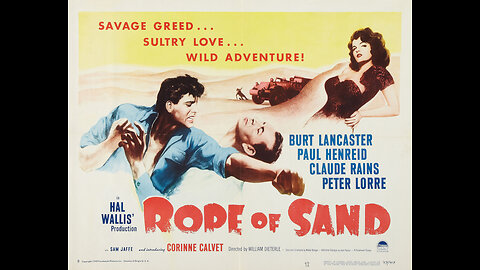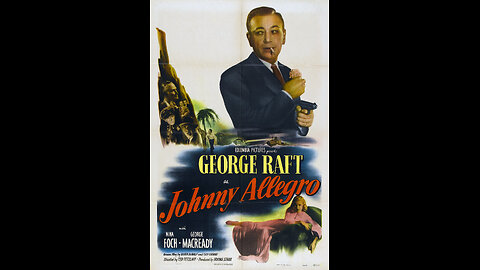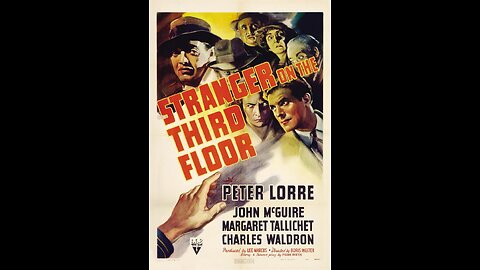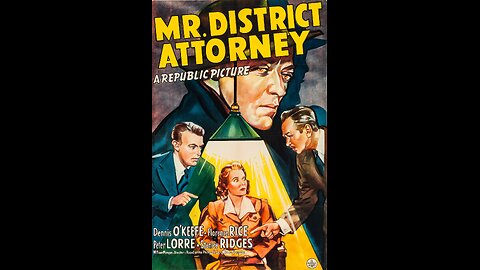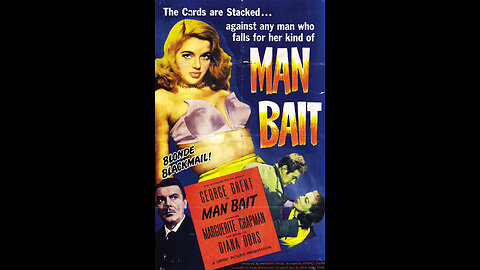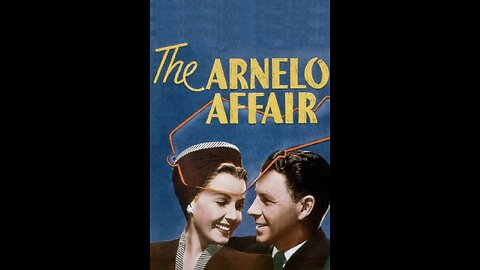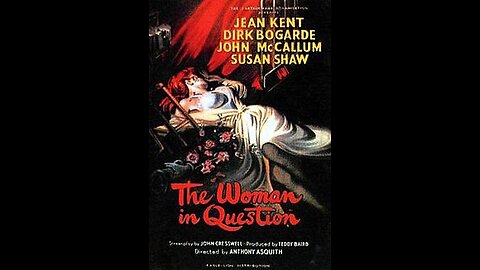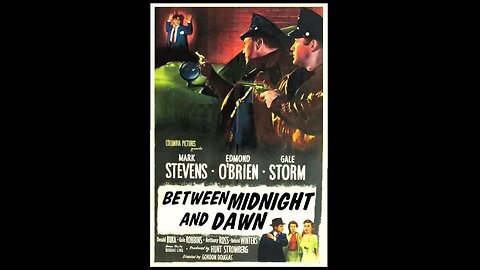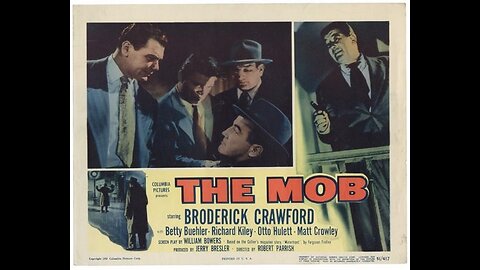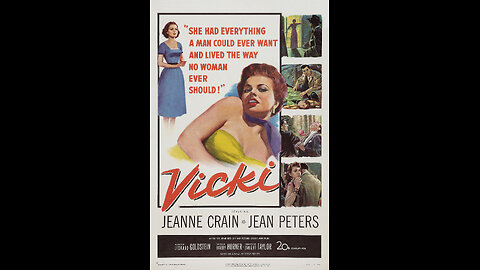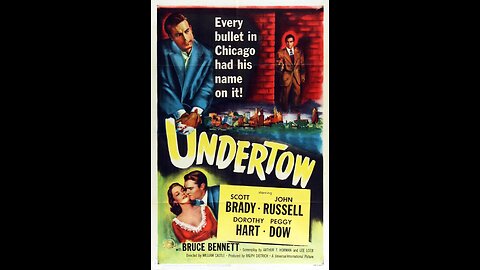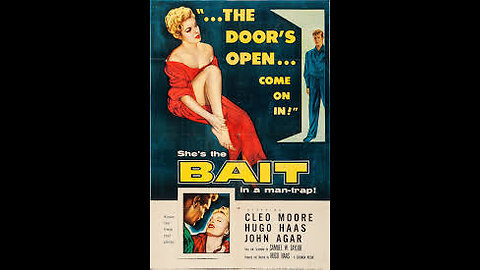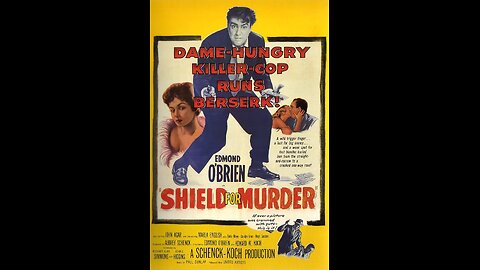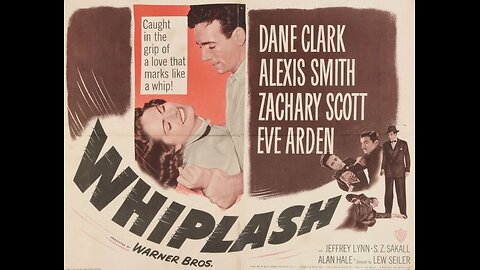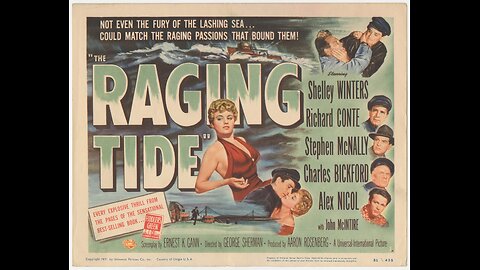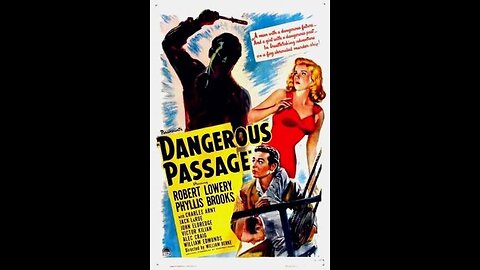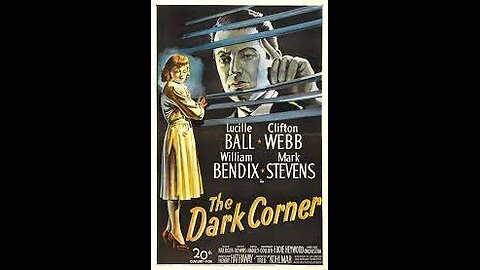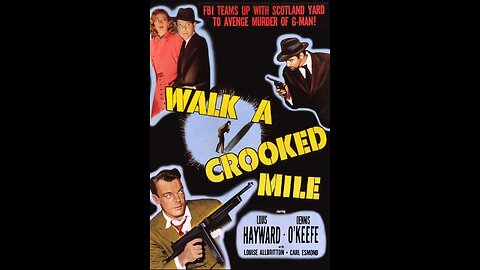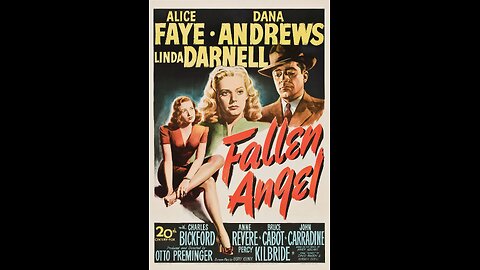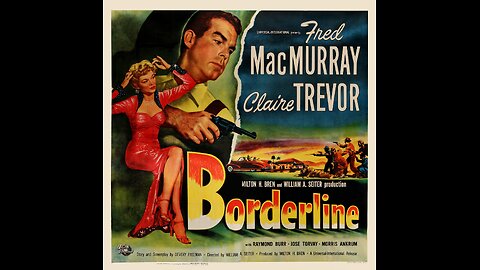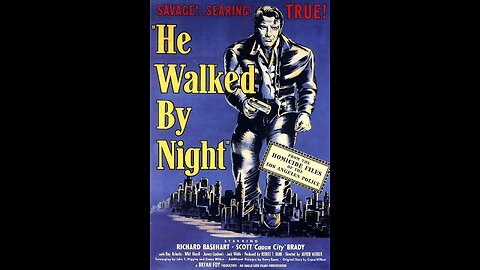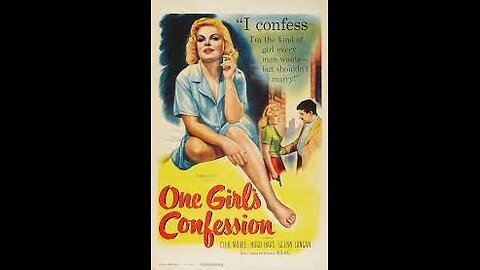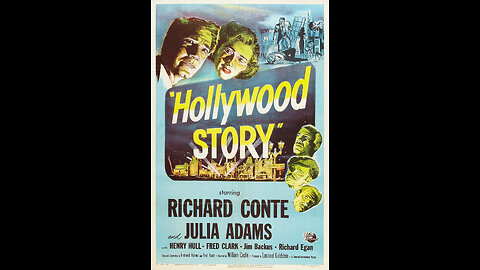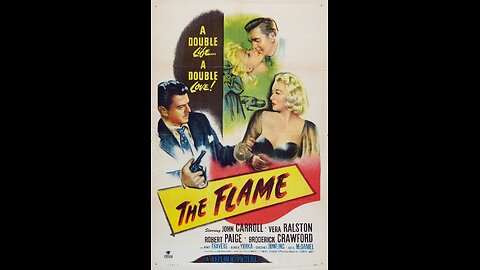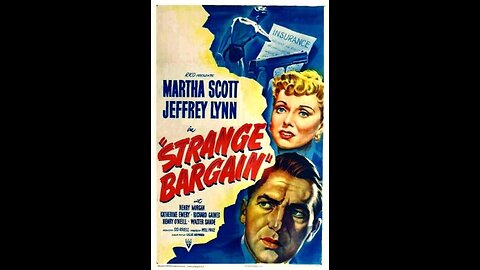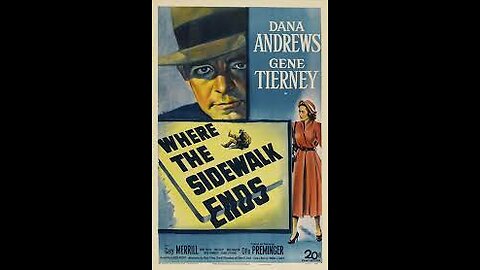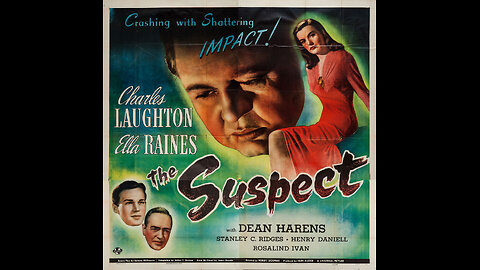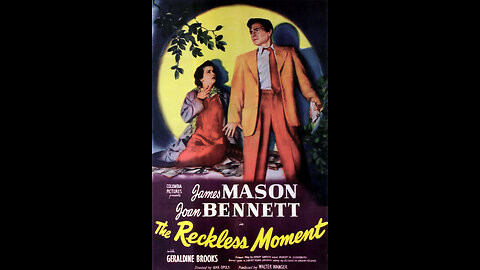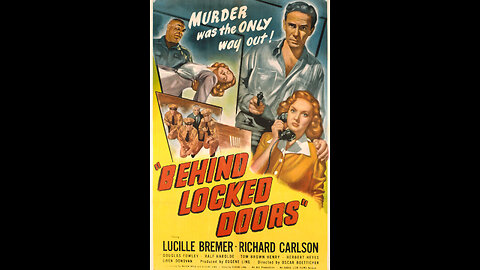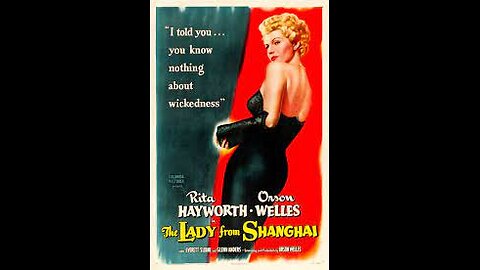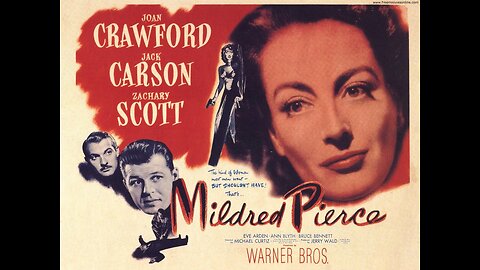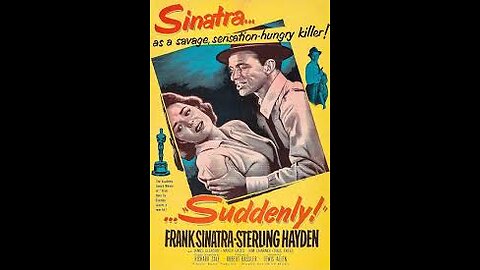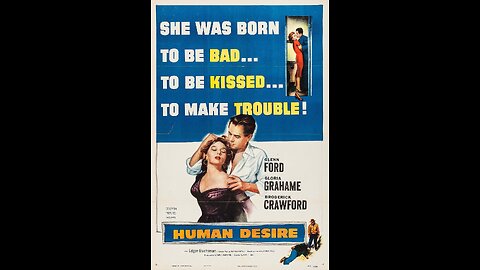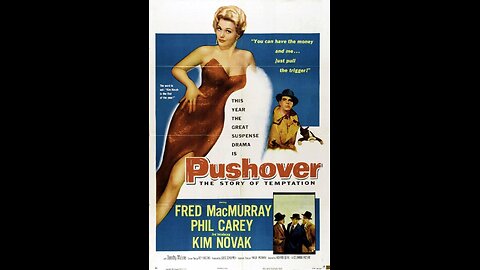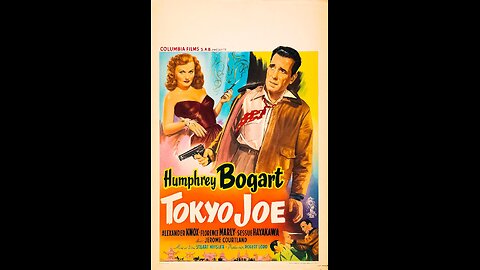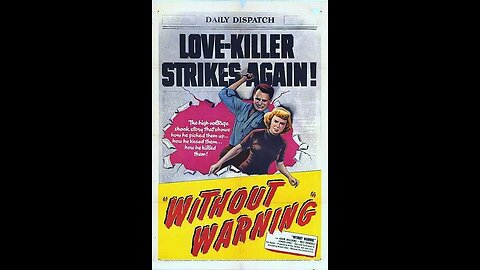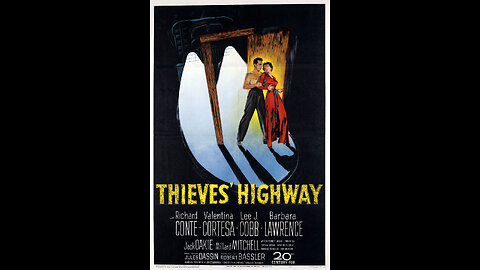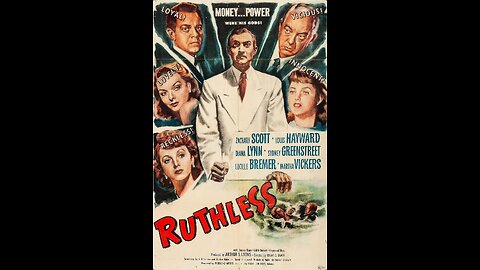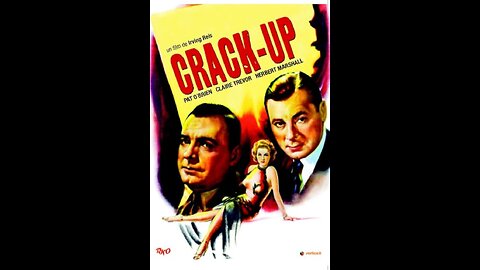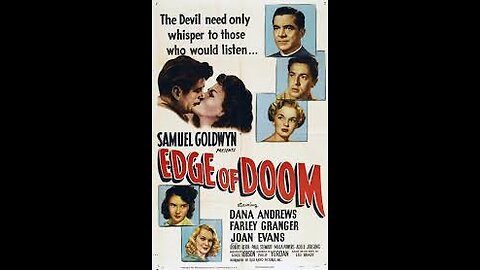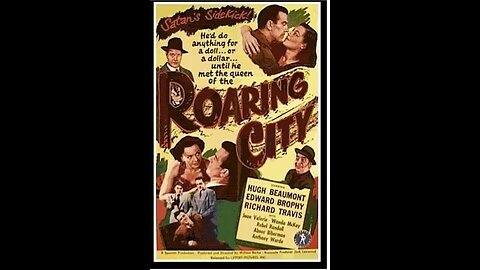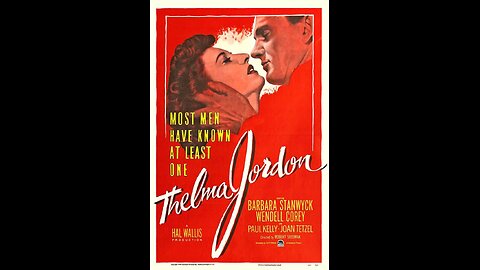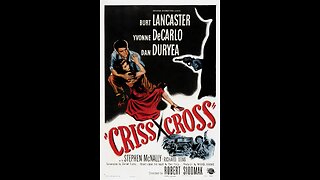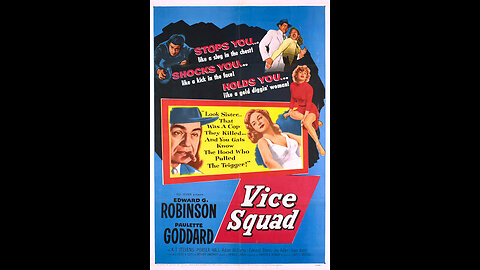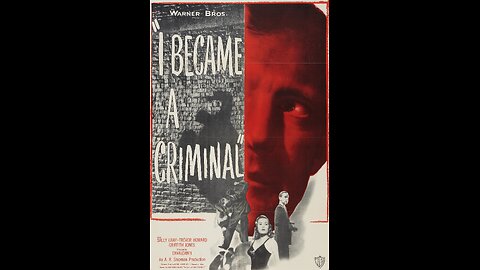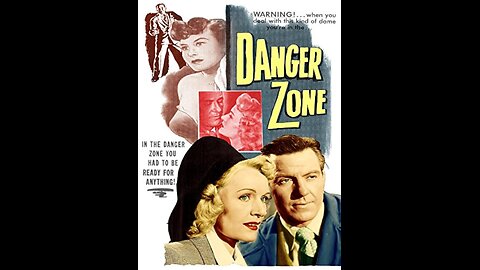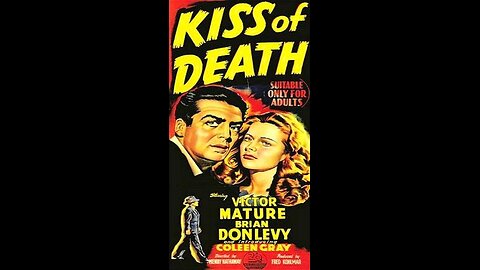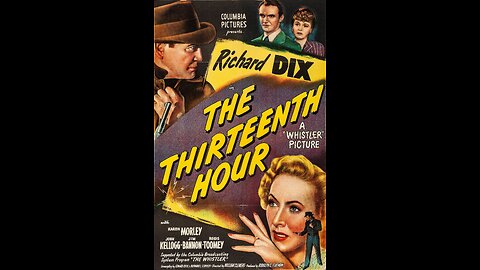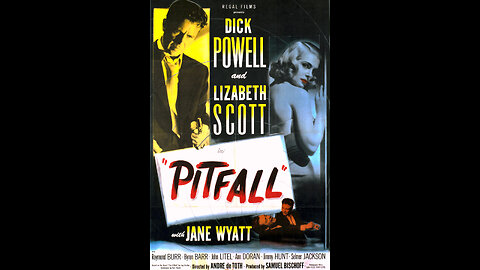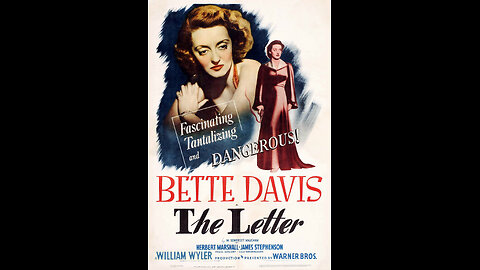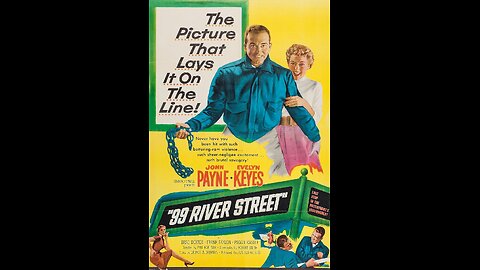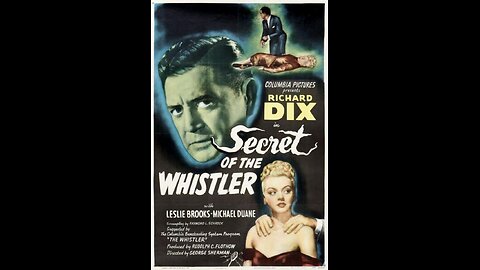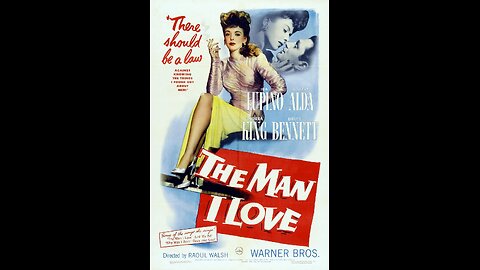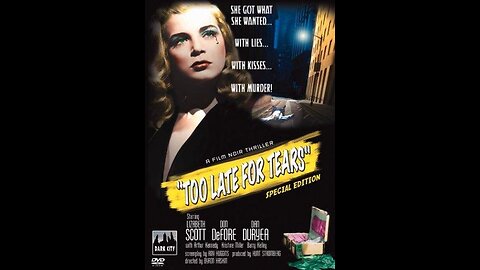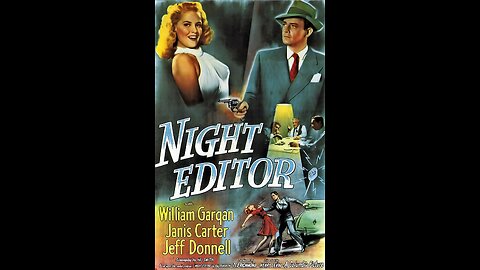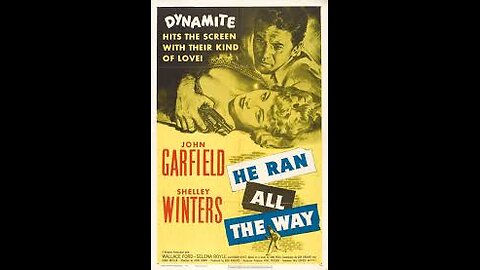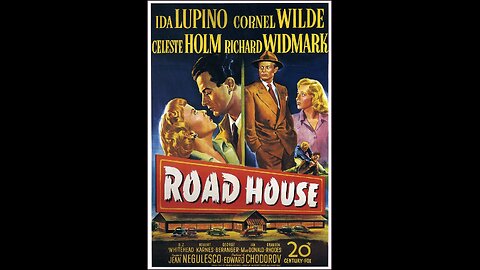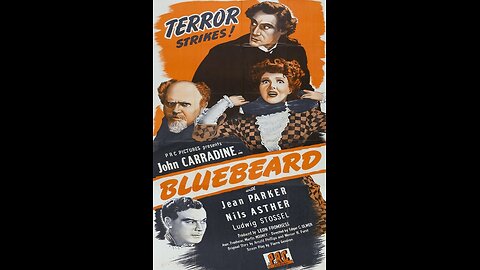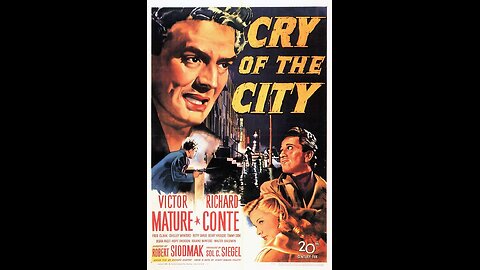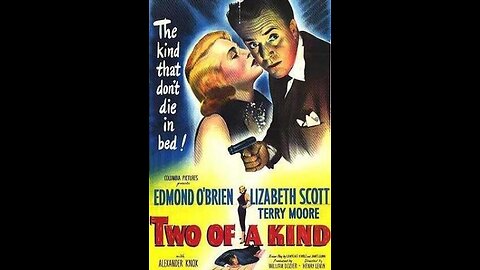Premium Only Content
This video is only available to Rumble Premium subscribers. Subscribe to
enjoy exclusive content and ad-free viewing.
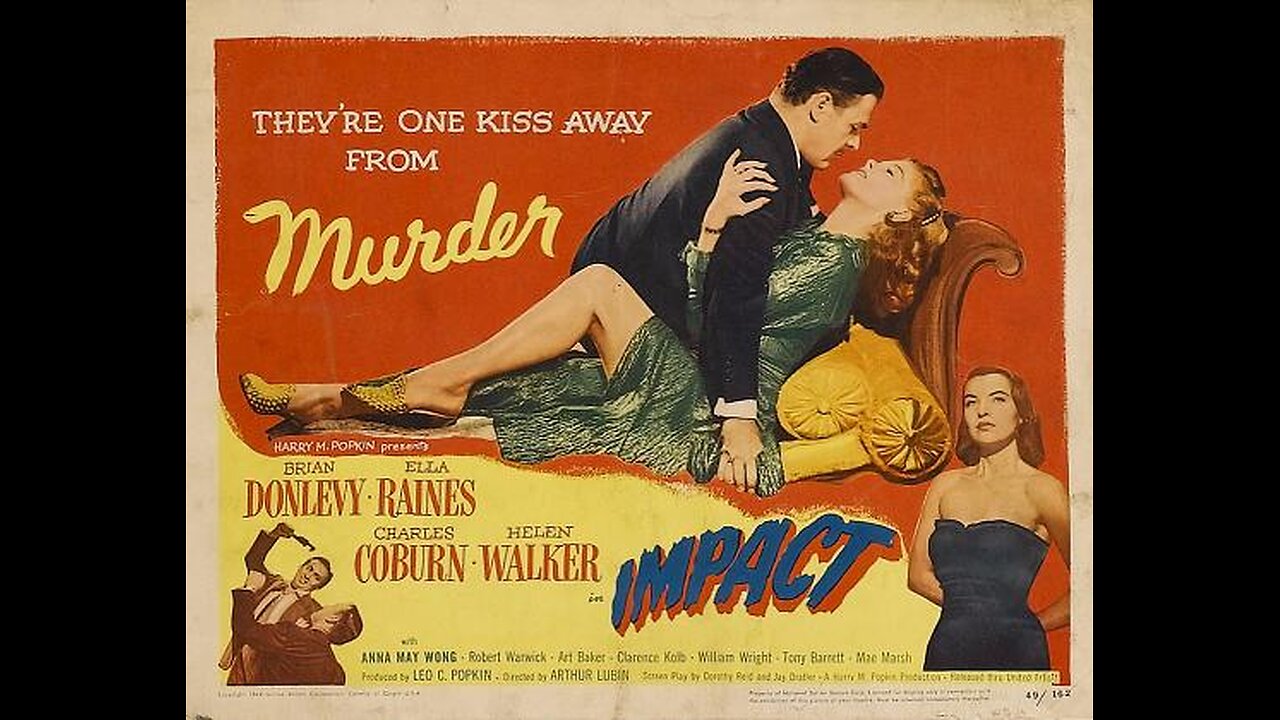
Film Noir Collection
Cinema2000
- 84 / 168
1
Force of Evil (1948) | Directed by Abraham Polonsky
Classic Films & Movies Archive
A stark, hard-edged crime drama about a lawyer who becomes entangled in the illegal numbers racket he is supposed to legitimize. As he sinks deeper into corruption, he confronts the moral wreckage of his choices, the devastation inflicted on small-time operators, and the collapse of his own family ties. The film charts his struggle toward redemption in a world shaped by greed and violence.
Genre: Film Noir / Crime Drama
Director: Abraham Polonsky
Abraham Polonsky was an American screenwriter, novelist, and director renowned for his sharp political sensibilities and distinctive narrative style. Before entering film, he worked as a teacher and writer, later bringing his disciplined intellect and interest in social justice to Hollywood. His career was abruptly disrupted when he was blacklisted during the early 1950s, shortly after the release of Force of Evil. Despite the political obstacles, his influence endured, and his 1948 debut as a director became a foundational work of film noir.
Star Cast:
John Garfield as Joe Morse
Thomas Gomez as Leo Morse
Beatrice Pearson as Doris Lowry
Marie Windsor as Edna Tucker
Howland Chamberlain as Wally
Roy Roberts as Freddie Bauer
Although admired by several critics upon release, the film struggled commercially due to its dark themes and the political controversy surrounding its creators. Over time, Force of Evil has been reappraised and is now regarded as one of the most intelligent and stylistically bold films of the noir era. Viewers and scholars praise its poetic dialogue, moral complexity, and striking urban imagery.
Fun Facts:
The film was adapted from Polonsky’s novel The Big Howe.
John Garfield, a frequent collaborator with politically engaged filmmakers, delivered one of his most lauded performances.
The depiction of Wall Street corruption tied to the numbers racket was seen as unusually daring for the period.
The film’s stark visual style, influenced by European realism, contributed to its later recognition as a noir classic.
* This Rumble Movie Channel is comprehensively indexed on https://kinoquick.com - find you favourite movies fast & free!
* Follow this channel to be notified of daily movie updates.
2
Please Murder Me (1956) | Directed by Peter Godfrey
Classic Films & Movies Archive
The story follows attorney Craig Carlson, whose life unravels when love, loyalty, and betrayal collide. Craig is secretly in love with Myra, the wife of his closest friend, Joe Leeds. When Joe is murdered, Myra is accused of the crime, and Craig, believing in her innocence and blinded by his feelings, defends her in court and wins an acquittal. After the trial he discovers that Myra has manipulated him and was involved with another man, Carl Holt. Realising he has been used and that justice has not been served, Craig constructs an intricate plan to reveal the truth, setting in motion a dark and fatal sequence of events.
Genre: Crime drama / Film noir
Director: Peter Godfrey
Peter Godfrey was a British-born stage actor and director who transitioned to Hollywood during the 1940s. With a background in theatre and a reputation for disciplined, character-driven storytelling, he directed a wide range of dramas, thrillers, and noirs. His Hollywood work often displayed a clean visual style and a focus on performance, and he collaborated with major studio talent as well as independent producers. By the mid-1950s he was an established craftsman whose films contributed to the closing years of the classic noir period.
Star Cast:
Raymond Burr as Craig Carlson
Angela Lansbury as Myra Leeds
Dick Foran as Joe Leeds
Lamont Johnson as Carl Holt
John Dehner as Detective Lt. Rocky Wall
Denver Pyle as Lou Kazarian
Audiences responded well to the taut storytelling and complex moral tensions, especially the emotionally charged triangle between Craig, Myra, and Joe. Critics highlighted Raymond Burr’s intense performance as a man torn between love and conscience, while Angela Lansbury earned notice for her cool and calculated portrayal of a woman capable of manipulating those closest to her. Although the film was not a major studio release, it became a recognised example of late-period noir and later gained wider visibility through public-domain circulation.
Fun Facts:
The film gained enduring popularity after entering the public domain, resulting in many restored and reissued prints.
Raymond Burr filmed this just before becoming widely known for his role as Perry Mason.
Angela Lansbury’s performance is frequently cited as one of her more notable early ventures into the femme fatale archetype.
The central love triangle and Craig’s elaborate plan for truth and justice distinguish the story from many straightforward courtroom dramas of the era.
* This Rumble Movie Channel is comprehensively indexed on https://kinoquick.com - find you favourite movies fast & free!
* Follow this channel to be notified of daily movie updates.
3
Smooth as Silk (1946) | Directed by Charles Barton
Classic Films & Movies Archive
Smooth as Silk is a crime drama film revolving around a slick and ambitious lawyer who becomes entangled in a web of deception, greed, and murder. When he helps a young woman secure a role in a play by manipulating her uncle, the situation spirals out of control, leading to betrayal and deadly consequences. The story unfolds as a dark examination of ambition and moral corruption.
Genre: Crime, Drama, Film Noir
Director: Charles Barton
Charles Barton (1902–1981) was an American film director and actor whose career spanned over four decades. Starting as a silent film actor in the 1920s, he transitioned to directing in the 1930s and became known for his work on comedies, thrillers, and adventure films. He directed several Abbott and Costello comedies and also worked extensively in television later in his career, including on popular series such as "Amos 'n' Andy" and "Dennis the Menace." Barton’s directorial style was characterized by brisk pacing and clear storytelling, often within tight budgets.
Star Cast:
Kent Taylor as Mark Fenton
Virginia Grey as Paula Marlowe
Milburn Stone as Steve Marlowe
John Litel as Stephen Elliott
Jane Adams as Peggy
Charles Trowbridge as Judge Ballantine
The film was received as a competent and fast-paced entry in the crime drama genre, typical of Universal’s mid-1940s output. Critics praised the performances of Kent Taylor and Virginia Grey, noting their convincing portrayal of morally ambiguous characters. While not a major box office success, it was appreciated by fans of noir-style mysteries for its concise storytelling and moody atmosphere.
Fun Facts:
The film was produced by Universal Pictures during the height of the studio’s B-movie crime cycle.
Virginia Grey was a frequent face in 1940s Hollywood thrillers and had previously starred in several Universal productions.
The story was adapted from a play titled "A Slight Case of Murder," although significant changes were made for the screen.
The film’s compact runtime of about an hour reflects Universal’s efficient approach to mid-budget features at the time.
Director Charles Barton shot the film in under three weeks, a common practice for noir B-movies of the period.
* This Rumble Movie Channel is comprehensively indexed on https://kinoquick.com - find you favourite movies fast & free!
* Follow this channel to be notified of daily movie updates.
4
The Third Man (1949) | Directed by Carol Reed
Classic Films & Movies Archive
The Third Man is a British film noir set in postwar Vienna, a city divided among Allied powers and rife with corruption. American pulp novelist Holly Martins arrives to meet his old friend Harry Lime, only to learn that Lime has been killed in a mysterious accident. As Martins investigates, he becomes entangled in a web of deceit, espionage, and moral ambiguity—culminating in the revelation that Lime is not only alive but deeply involved in the black-market trade of diluted penicillin. The film’s haunting atmosphere, striking visuals, and unforgettable zither score make it one of cinema’s great masterpieces.
Genre: Film Noir, Mystery, Thriller
Director: Carol Reed
Carol Reed (1906–1976) was one of Britain’s most distinguished filmmakers, known for his mastery of atmosphere, tension, and character-driven storytelling. Starting in the 1930s, Reed developed a reputation for intelligent, visually inventive films that explored moral complexity. His best-known works include The Fallen Idol, The Third Man, and Oliver!, the latter earning him an Academy Award for Best Director. Reed’s collaboration with novelist Graham Greene on The Third Man produced one of the most acclaimed British films ever made, renowned for its noir aesthetic and moral depth.
Star Cast:
Joseph Cotten as Holly Martins
Alida Valli as Anna Schmidt
Orson Welles as Harry Lime
Trevor Howard as Major Calloway
Bernard Lee as Sergeant Paine
Paul Hörbiger as Porter
Ernst Deutsch as Baron Kurtz
Siegfried Breuer as Popescu
Wilfrid Hyde-White as Crabbin
The Third Man was an international critical and commercial success upon release. Audiences were captivated by its intrigue, shadow-drenched cinematography, and the morally ambiguous world it portrayed. Critics hailed Orson Welles’s performance as Harry Lime, though he appeared only briefly, and the film quickly became a cultural landmark of postwar cinema. It won the Grand Prix at the 1949 Cannes Film Festival and the Academy Award for Best Cinematography (Black-and-White). Over time, it has been consistently ranked among the greatest films ever made, celebrated for its artistry, haunting score, and unforgettable final scene.
Fun Facts:
The screenplay was written by Graham Greene, who first drafted the story as a novella to develop the plot before adapting it for the screen.
Orson Welles’s famous line, “In Italy for thirty years under the Borgias…” was improvised and is now one of cinema’s most quoted speeches.
The film’s distinctive zither score, composed and performed by Anton Karas, became a worldwide hit and sold millions of records.
Much of the film was shot on location in the bombed-out ruins of Vienna, lending it authentic postwar realism.
The unforgettable “cuckoo clock” speech was not in Greene’s script but added by Welles during filming.
Welles reportedly disliked working in Vienna’s sewers and used body doubles for some of the underground chase scenes.
The film’s ending, featuring Anna silently walking past Holly, was insisted upon by director Carol Reed against producer David O. Selznick’s wishes—and is now regarded as one of the greatest closing scenes in cinema history.
In 1999, the British Film Institute voted The Third Man the greatest British film of the 20th century.
* This Rumble Movie Channel is comprehensively indexed on https://kinoquick.com - find you favourite movies fast & free!
* Follow this channel to be notified of daily movie updates.
1
comment
5
Body and Soul (1947) | Directed by Robert Rossen
Classic Films & Movies Archive
Body and Soul is a landmark boxing drama that tells the story of Charlie Davis, a young man from the slums who rises to fame as a prizefighter. Along the way, he grapples with corruption in the sport, personal ambition, betrayal, and the toll his choices take on his relationships. The film combines thrilling boxing sequences with a hard-hitting critique of greed and exploitation in professional sports.
Genre: Drama, Sports, Film Noir
Director: Robert Rossen
Robert Rossen was an American screenwriter, director, and producer known for socially conscious films that explored ambition, corruption, and moral conflict. After working as a screenwriter in the 1930s, he transitioned into directing in the 1940s. His films include All the King’s Men (1949), which won the Academy Award for Best Picture, and The Hustler (1961), considered one of his masterpieces. Rossen’s work is marked by its intensity, realism, and moral complexity.
Star Cast:
John Garfield as Charlie Davis
Lilli Palmer as Peg Born
Hazel Brooks as Alice
Anne Revere as Anna Davis
William Conrad as Quinn
Lloyd Gough as Roberts
Joseph Pevney as Shorty Polaski
Canada Lee as Ben Chaplin
Body and Soul was both a critical and commercial success, widely praised for its realistic fight sequences and its uncompromising view of corruption in boxing. John Garfield’s powerful performance was highly acclaimed, and the film became one of the defining sports dramas of its era. It won an Academy Award for Best Film Editing and received nominations for Best Actor (Garfield) and Best Original Screenplay (Abraham Polonsky).
Fun Facts:
The screenplay was written by Abraham Polonsky, who infused the story with strong social commentary; Polonsky was later blacklisted during the McCarthy era.
The fight scenes were revolutionary for their time, using dynamic camerawork to put audiences inside the ring.
Canada Lee, who played Charlie’s loyal trainer Ben Chaplin, was a former real-life professional boxer before turning to acting.
John Garfield trained extensively with professional boxers to prepare for the role, adding authenticity to his performance.
The film is often cited as one of the most influential boxing movies, inspiring later classics such as Raging Bull (1980).
* This Rumble Movie Channel is comprehensively indexed on https://kinoquick.com - find you favourite movies fast & free!
* Follow this channel to be notified of daily movie updates.
6
The Miami Story (1954) | Directed by Fred F. Sears
Classic Films & Movies Archive
The Miami Story is a crime thriller about an ex-convict recruited by law enforcement to help bring down a powerful crime syndicate in Miami. Using his criminal background and connections, he infiltrates the mob’s inner circle while the police secretly monitor the operation. The film unfolds as a tense mix of undercover drama, mob intrigue, and violent confrontations, showcasing the dangers of organized crime in postwar America.
Genre: Crime, Drama, Film Noir
Director: Fred F. Sears
Fred F. Sears was an American director, actor, and screenwriter, best known for his rapid-fire output of low-budget films during the 1950s. Working frequently for Columbia Pictures, he directed everything from crime dramas to westerns and science fiction. Despite the modest budgets, Sears became known for keeping stories moving quickly and entertainingly. Among his most famous works are Earth vs. the Flying Saucers (1956) and Rock Around the Clock (1956).
Star Cast:
Barry Sullivan as Mick Flagg
Luther Adler as Tony Brill
John Baer as Steve Foster
Adele Jergens as Holly Abbott
Beverly Garland as Betty Stacey
William Henry as Lt. Mike Abbott
George Eldredge as Capt. Thompson
The Miami Story was generally received as a competent but conventional entry in the crime film cycle of the 1950s. Audiences enjoyed the noirish atmosphere, fast pacing, and performances, especially from Barry Sullivan and Luther Adler. While it did not achieve major box office success, it was appreciated by fans of crime thrillers for its gritty portrayal of the Miami underworld.
Fun Facts:
The film was part of Columbia’s wave of crime dramas that capitalized on the popularity of noir and gangster films in the early 1950s.
Fred F. Sears, the director, was known for working at lightning speed, sometimes completing films in less than three weeks.
Beverly Garland, who appears in the film, later became well known on television, appearing in shows like My Three Sons and Scarecrow and Mrs. King.
The story highlighted the cooperation between law enforcement and reformed criminals, a theme popular in postwar crime films.
The movie is often cited as an example of how Hollywood used exotic American cities like Miami to add flair and atmosphere to noir-style storytelling.
* This Rumble Movie Channel is comprehensively indexed on https://kinoquick.com - find you favourite movies fast & free!
* Follow this channel to be notified of daily movie updates.
7
The Good Die Young (1957) | Directed by Lewis Gilbert
Classic Films & Movies Archive
The Good Die Young is a British crime drama that follows four men from very different backgrounds who are drawn into a carefully planned post office robbery in London. Each man is struggling with personal troubles, from failing marriages to financial ruin, and they are persuaded to join the scheme by a smooth-talking aristocrat. What begins as an attempt to solve their problems spirals into tragedy as loyalty, greed, and betrayal tear the group apart.
Genre: Crime, Drama, Film Noir
Director: Lewis Gilbert
Lewis Gilbert was an English director, producer, and screenwriter whose career spanned six decades. He directed a wide range of films, from wartime dramas to comedies, but became best known internationally for his work on three James Bond films: You Only Live Twice (1967), The Spy Who Loved Me (1977), and Moonraker (1979). Gilbert was praised for his versatility, character-driven storytelling, and ability to handle large-scale productions.
Star Cast:
Laurence Harvey as Miles Ravenscourt
Gloria Grahame as Denise
Richard Basehart as Joe Halsey
Joan Collins as Mary Halsey
John Ireland as Mike Morgan
Stanley Baker as Eddie Blaine
Rene Ray as Angela Morgan
Margaret Leighton as Eve Ravenscourt
The film was well received by critics in Britain and abroad, noted for its stark and realistic approach to crime, as well as its ensemble cast of international stars. Audiences appreciated the gritty tension and the personal dramas behind the characters’ descent into crime. Although it wasn’t a huge commercial blockbuster, the film built a strong reputation and is still regarded as one of the better British crime films of the 1950s.
Fun Facts:
The film was adapted from the novel by Richard Macaulay, with the screenplay co-written by Lewis Gilbert and Vernon Harris.
Gloria Grahame was an established Hollywood star and Oscar winner who brought significant international appeal to the film.
Joan Collins was still early in her career, years before becoming a global television star with Dynasty in the 1980s.
Laurence Harvey, who played the manipulative aristocrat, later achieved fame in The Manchurian Candidate (1962).
The movie is considered a fine example of British postwar noir, combining American star power with a distinctly British sensibility.
* This Rumble Movie Channel is comprehensively indexed on https://kinoquick.com - find you favourite movies fast & free!
* Follow this channel to be notified of daily movie updates.
8
Plunder Road (1957) | Directed by Hubert Cornfield
Classic Films & Movies Archive
Plunder Road is a taut crime thriller centered on a daring train robbery where a gang of criminals steals a massive shipment of gold bullion. The story follows their meticulous planning, the split-second execution, and the tension-filled aftermath as they try to smuggle the stolen fortune out of the country without being caught.
Genre: Crime, Film Noir, Thriller
Director: Hubert Cornfield
Hubert Cornfield was a French-born filmmaker who moved to the United States and worked primarily in the 1950s and 1960s. Known for his lean and stylish direction, he specialized in crime dramas and thrillers. Although his career was relatively brief, Cornfield developed a reputation for handling tight budgets while creating strong atmospheric tension in his films.
Star Cast:
Gene Raymond as Eddie Harris
Jeanne Cooper as Fran Werner
Wayne Morris as Frank Norris
Elisha Cook Jr. as Skeets
Stafford Repp as Charles
Steven Ritch as Commando
The film received moderate attention on its release, with critics praising its taut pacing and moody cinematography. Audiences appreciated the suspenseful unfolding of the heist and the gritty, noir-inspired atmosphere. While not a major box-office hit, Plunder Road gained recognition over the years as a solid entry in the heist and noir subgenre.
Fun Facts:
The film was shot in black and white, which heightened its noir atmosphere and tension.
Jeanne Cooper, who plays Fran Werner, later became well-known for her decades-long role on the daytime soap opera The Young and the Restless.
Elisha Cook Jr., cast as Skeets, was already a familiar face in film noir, having appeared in classics like The Maltese Falcon (1941) and The Big Sleep (1946).
Despite being a B-movie with a modest budget, it is admired for its crisp direction and efficient storytelling, making it a cult favorite among noir enthusiasts.
The movie is notable for focusing on the psychological strain and breakdown of the criminals rather than just the action of the heist itself.
* This Rumble Movie Channel is comprehensively indexed on https://kinoquick.com - find you favourite movies fast & free!
* Follow this channel to be notified of daily movie updates.
9
Odds Against Tomorrow (1959) | Directed by Robert Wise
Classic Films & Movies Archive
Odds Against Tomorrow is a hard-hitting crime drama that blends the suspense of a heist thriller with sharp social commentary on race and prejudice. The story follows three men who plan a bank robbery: a bitter ex-con, a racist ex-cop, and a Black nightclub entertainer. As tensions rise, mistrust and hatred threaten to derail the plan, leading to a violent and tragic conclusion.
Genre: Crime drama / Film noir
Director: Robert Wise
Robert Wise (1914–2005) was an acclaimed American film director, producer, and editor. He began his career as an editor at RKO, famously working on Orson Welles’s Citizen Kane (1941). As a director, Wise demonstrated versatility across genres, from horror (The Body Snatcher, 1945), to science fiction (The Day the Earth Stood Still, 1951; The Andromeda Strain, 1971), to musicals (West Side Story, 1961; The Sound of Music, 1965). Odds Against Tomorrow reflected his skill in blending social issues with popular storytelling.
Star Cast:
Harry Belafonte as Johnny Ingram
Robert Ryan as Earle Slater
Ed Begley as Dave Burke
Gloria Grahame as Helen
Shelley Winters as Ruth Slater
Will Kuluva as Bacco
Cicely Tyson (uncredited early screen appearance)
The film was praised for its tense atmosphere, sharp direction, and standout performances, particularly Harry Belafonte’s layered portrayal of a Black man navigating crime and systemic racism. Critics noted its socially conscious themes, which were rare in American crime films of the time. While not a major box-office success, it became a respected entry in late-period film noir and is now considered a classic of socially aware crime cinema.
Fun Facts:
The film was based on the novel by William P. McGivern.
Harry Belafonte not only starred in the film but also produced it through his own company, HarBel Productions.
The jazz score was composed by John Lewis of the Modern Jazz Quartet, enhancing the film’s cool, modern tone.
Cicely Tyson, later a legendary actress, made an early uncredited appearance in the film.
Robert Ryan, who often played tough characters, was himself a committed liberal and supporter of civil rights, making his role as a racist ex-cop deeply ironic.
* This Rumble Movie Channel is comprehensively indexed on https://kinoquick.com - find you favourite movies fast & free!
* Follow this channel to be notified of daily movie updates.
10
Wicked as They Come (1956) | Directed by Ken Hughes
Classic Films & Movies Archive
Wicked as They Come is a British-American film noir drama about a ruthless and ambitious woman who manipulates and deceives her way up the social ladder. Her beauty and charm conceal a cold, calculating nature, and the film follows her destructive rise and eventual downfall.
Genre: Film noir drama
Director: Ken Hughes
Ken Hughes (1922–2001) was a British screenwriter and director known for his versatility in tackling different genres, from gritty dramas and crime thrillers to big-budget musicals. He worked on notable films such as The Trials of Oscar Wilde (1960), Of Human Bondage (1964), and Chitty Chitty Bang Bang (1968). Hughes had a reputation for stylish visuals and a willingness to push boundaries in character-driven stories.
Star Cast:
Arlene Dahl as Katherine Allenborg
Philip Carey as Stephen Collins
Herbert Marshall as Walter Allenborg
Michael Goodliffe as Paul Barlow
Sid James as Martin
Marie Burke as Mrs. Allenborg
The film received mixed reviews upon release. Critics noted Arlene Dahl’s performance as captivating and effective in portraying a femme fatale, though the plot was seen by some as melodramatic. Audiences appreciated the glamour and intrigue of the story, though it did not achieve major box-office success in the United States. Over time, it has gained attention as a solid example of mid-century British noir.
Fun Facts:
The film was released in the United States under the alternative title Portrait in Smoke.
Arlene Dahl’s performance was praised as one of her most memorable screen roles, solidifying her image as a glamorous star of the 1950s.
The movie was based on the novel Portrait in Smoke by Bill S. Ballinger.
It was one of the films that highlighted the blending of Hollywood talent with British studios during the 1950s co-production era.
* This Rumble Movie Channel is comprehensively indexed on https://kinoquick.com - find you favourite movies fast & free!
* Follow this channel to be notified of daily movie updates.
11
The Glass Key (1942) | Directed by Stuart Heisler
Classic Films & Movies Archive
The Glass Key is a crime drama based on the novel by Dashiell Hammett. The story follows political fixer Ed Beaumont, who works for a corrupt political boss. When his employer is accused of murder, Beaumont is caught between loyalty, criminal underworld power struggles, and his growing attraction to his boss’s fiancée. The film mixes sharp dialogue, political intrigue, and noir tension.
Genre: Crime, Film Noir, Drama
Director: Stuart Heisler
Stuart Heisler (1896–1979) was an American film director who started in Hollywood as an editor before moving to directing. He specialized in dramas, thrillers, and westerns, directing films such as Among the Living (1941), Smash-Up, the Story of a Woman (1947), and I Died a Thousand Times (1955). Known for his efficient storytelling and steady direction, Heisler built a reputation as a reliable studio director during the 1940s and 1950s.
Star Cast:
Alan Ladd as Ed Beaumont
Veronica Lake as Janet Henry
Brian Donlevy as Paul Madvig
Joseph Calleia as Nick Varna
Bonita Granville as Opal Madvig
Richard Denning as Taylor Henry
Moroni Olsen as Ralph Henry
William Bendix as Jeff
The Glass Key was praised for its taut adaptation of Hammett’s novel and for the chemistry between Alan Ladd and Veronica Lake, who became one of the iconic screen pairings of the 1940s. The film’s dark atmosphere and political-crime storyline resonated with audiences, cementing it as a solid entry in the film noir canon.
Fun Facts:
This was the second adaptation of Hammett’s novel; the first was released in 1935 starring George Raft.
The film capitalized on the success of Alan Ladd and Veronica Lake’s earlier hit This Gun for Hire (1942).
William Bendix’s portrayal of the sadistic thug Jeff became one of his most memorable roles.
The success of the Ladd-Lake pairing led Paramount to feature them together in seven films.
Dashiell Hammett’s influence on the hardboiled detective and noir genre made The Glass Key a key example of literary adaptation in Hollywood.
* This Rumble Movie Channel is comprehensively indexed on https://kinoquick.com - find you favourite movies fast & free!
* Follow this channel to be notified of daily movie updates.
1
comment
12
Guns Girls and Gangsters (1959) | Directed by Edward L. Cahn
Classic Films & Movies Archive
A fast-paced crime drama that centers on a daring Las Vegas armored car heist. The film weaves together the worlds of gangsters, glamorous women, and double-crosses, presenting a classic B-movie tale of crime, passion, and betrayal. Its noir-like atmosphere and pulp energy give it the flair of mid-century crime cinema.
Genre: Crime, Film Noir, Drama
Director: Edward L. Cahn
Edward L. Cahn was a prolific American director known for his work on low-budget films during the 1930s through the 1960s. Though he directed across many genres, he became especially associated with crime dramas, westerns, and later science fiction and horror B-movies such as It! The Terror from Beyond Space (1958). His efficiency and speed in production made him a regular fixture at studios producing modestly budgeted films.
Star Cast:
Mamie Van Doren as Vi Victor
Gerald Mohr as Joe Darren
Grant Richards as Mike Bennet
Lee Van Cleef as Mike
John Baer as Sgt. Rogers
Paul Birch as Lt. Mike Madden
Eddie Ryder as Sam
Frank Gerstle as Marty Connell
The film was received as a solid B-movie crime thriller, appreciated for its pace, Mamie Van Doren’s sultry performance, and its mix of action and melodrama. While not a major box-office hit, it has remained of interest to enthusiasts of 1950s noir-style crime films and Van Doren’s career.
Fun Facts:
The film prominently featured Mamie Van Doren, who was often billed as a rival to Marilyn Monroe and Jayne Mansfield, cementing her reputation as a blonde bombshell of 1950s Hollywood.
Edward L. Cahn’s direction was characteristically brisk, with the film running a lean 70 minutes.
Lee Van Cleef, who later rose to international fame in spaghetti westerns like The Good, the Bad and the Ugly, appears here in one of his early gangster roles.
The movie’s setting in Las Vegas allowed it to capture glimpses of the city during its mid-century heyday, adding authenticity to the heist plot.
* This Rumble Movie Channel is comprehensively indexed on https://kinoquick.com - find you favourite movies fast & free!
* Follow this channel to be notified of daily movie updates.
13
Tight Spot (1955) | Directed by Phil Karlson
Classic Films & Movies Archive
Tight Spot is a tense crime drama about a woman imprisoned for life who is offered a chance at freedom if she testifies against a notorious gangster. As she weighs her options, she finds herself entangled in a web of danger, manipulation, and unexpected romance. The film combines noir elements with courtroom drama and suspense.
Genre: Crime drama / Film noir
Director: Phil Karlson
Phil Karlson (1908–1982) was an American film director best known for his hard-hitting crime dramas and film noir works of the 1940s and 1950s. His films often depicted corruption, gritty realism, and characters caught in desperate circumstances. Later in his career, he directed the successful action film Walking Tall (1973), cementing his reputation for uncompromising, tough-edged storytelling.
Star Cast:
Ginger Rogers as Sherry Conley
Edward G. Robinson as Lloyd Hallett
Brian Keith as Vince Striker
Lorne Greene as Benjamin Costain
Lucy Marlow as Willoughby
The film received mixed to positive reviews upon release. Critics praised Ginger Rogers for taking on a tougher, less glamorous role, while Edward G. Robinson delivered another commanding performance as a government prosecutor. However, the film was sometimes seen as stagey and less dynamic than other noir classics. Over time, Tight Spot has been appreciated more for its strong performances and taut direction.
Fun Facts:
Ginger Rogers was already a celebrated Hollywood star known for musicals with Fred Astaire, making her appearance in a gritty noir drama a surprising turn.
The movie was based on the 1953 play Dead Pigeon by Leonard Kantor.
Lorne Greene, later famous for his role as Ben Cartwright in the television series Bonanza, appears here in a supporting role as a gangster.
Phil Karlson directed several notable noirs around this period, including Kansas City Confidential (1952) and 99 River Street (1953).
* This Rumble Movie Channel is comprehensively indexed on https://kinoquick.com - find you favourite movies fast & free!
* Follow this channel to be notified of daily movie updates.
1
comment
14
Border Incident (1949) | Directed by Anthony Mann
Classic Films & Movies Archive
This hard-hitting MGM crime drama explores the perilous world of illegal immigration and exploitation along the U.S.–Mexico border. The story follows two government agents, one Mexican and one American, who go undercover to expose a brutal smuggling ring that preys on migrant farm workers. The film blends documentary-style realism with stark film noir visuals.
Genre: Crime Drama / Film Noir
Director: Anthony Mann
Anthony Mann was an American filmmaker renowned for his intense crime dramas and Westerns. Emerging in the 1940s, he became one of the defining directors of film noir with works like T-Men (1947) and Raw Deal (1948). In the 1950s, Mann transitioned into Westerns, often collaborating with James Stewart on classics such as Winchester ’73 (1950) and The Naked Spur (1953). His reputation rests on his skillful use of atmosphere, psychological depth, and striking cinematography.
Star Cast:
Ricardo Montalbán as Pablo Rodriguez
George Murphy as Jack Bearnes
Howard Da Silva as Owen Parkson
James Mitchell as Juan Garcia
Charles McGraw as Jeff Amboy
Alfonso Bedoya as Cuchillo
José Torvay as Zopilote
While Border Incident was praised by critics for its unflinching look at social issues and its gritty noir style, it was not a major box office hit. Its subject matter was considered daring for the time, confronting the exploitation of migrant workers in a way rarely seen in Hollywood films of the late 1940s. Over time, the film gained recognition as an important and powerful example of socially conscious film noir.
Fun Facts:
The film was produced by Dore Schary, who was known for encouraging MGM to make more socially relevant films.
Cinematographer John Alton, a frequent Anthony Mann collaborator, created striking low-light compositions that gave the film its distinctive noir atmosphere.
Ricardo Montalbán was often cast in romantic or musical roles at MGM, making this gritty dramatic performance an unusual and acclaimed departure.
The film is often studied for its realistic depiction of border smuggling and its blend of documentary-style realism with noir suspense.
Despite modest box office returns, it is now considered a classic in both the film noir and social problem film categories.
* This Rumble Movie Channel is comprehensively indexed on https://kinoquick.com - find you favourite movies fast & free!
* Follow this channel to be notified of daily movie updates.
1
comment
15
I Died a Thousand Times (1955) | Directed by Stuart Heisler
Classic Films & Movies Archive
I Died a Thousand Times is a crime drama and film noir that retells the classic story of a doomed criminal and his final heist. It is a remake of the 1941 classic High Sierra, focusing on a hardened ex-convict who attempts one last job in the California mountains while battling both the law and his own vulnerabilities.
Genre: Crime, Drama, Film Noir
Director: Stuart Heisler
Stuart Heisler (1896–1979) was an American film director and editor known for his work in the 1940s and 1950s across a variety of genres, including noir, westerns, and war dramas. His notable films include The Glass Key (1942), Smash-Up: The Story of a Woman (1947), and Tulsa (1949). He was recognized for his solid craftsmanship and ability to handle gritty storytelling with emotional intensity.
Star Cast:
Jack Palance as Roy Earle
Shelley Winters as Marie Garson
Lori Nelson as Velma
Lee Marvin as Babe Kossuck
Pedro Gonzalez Gonzalez as Chico
Lon Chaney Jr. as Big Mac
Dennis Hopper as Red
The film received mixed reviews upon release. While some critics admired Jack Palance’s brooding intensity and the film’s colorful Cinemascope remake of a noir classic, others felt it lacked the raw impact of the original High Sierra starring Humphrey Bogart. Nevertheless, it gained attention for its strong performances and its place in the 1950s cycle of crime remakes.
Fun Facts:
The film is a direct remake of High Sierra (1941), which had been a defining role for Humphrey Bogart.
Jack Palance took on Bogart’s iconic role, bringing a more menacing and physically imposing presence.
Shelley Winters, known for her tough and vulnerable screen personas, added depth to the female lead.
The movie was filmed in Cinemascope, giving the story a broader and more colorful visual style compared to the noir look of the 1941 original.
A young Dennis Hopper appears in one of his early screen roles.
* This Rumble Movie Channel is comprehensively indexed on https://kinoquick.com - find you favourite movies fast & free!
* Follow this channel to be notified of daily movie updates.
16
Violent Saturday (1955) | Directed by Richard Fleischer
Classic Films & Movies Archive
Violent Saturday is a tense film noir crime drama that blends small-town life with violent criminal intrusion. The story follows a quiet Arizona town disrupted by a trio of ruthless bank robbers, revealing the hidden flaws and secrets of its residents as violence erupts.
Genre: Film noir, crime, drama
Director: Richard Fleischer
Richard Fleischer (1916–2006) was an American film director known for his versatility across genres, from noir and crime dramas to epics and science fiction. He directed notable works such as The Narrow Margin (1952), 20,000 Leagues Under the Sea (1954), Compulsion (1959), Fantastic Voyage (1966), and Soylent Green (1973). His career spanned decades, marked by strong visual storytelling and the ability to balance action with character depth.
Star Cast:
Victor Mature as Shelley Martin
Richard Egan as Boyd Fairchild
Stephen McNally as Harper
Virginia Leith as Linda Sherman
Tommy Noonan as Harry Reeves
J. Carrol Naish as Stadt
Sylvia Sidney as Elsie Braden
Ernest Borgnine as Amish farmer
Lee Marvin as Dill
The film was praised for its raw intensity and combination of domestic melodrama with sudden, brutal violence. Critics noted it as a standout noir of the 1950s, with Fleischer’s tight direction and strong performances—especially from Victor Mature and Lee Marvin—earning recognition. While not a box-office blockbuster, it later gained appreciation as one of the more daring crime films of its era.
Fun Facts:
The film is based on a novel by William L. Heath.
Lee Marvin’s character, a menacing bank robber, is considered one of his early standout villain roles.
Ernest Borgnine plays a peace-loving Amish farmer who becomes central to the climactic showdown.
The film was shot in Cinemascope, adding visual grandeur to a noir traditionally associated with shadowy black-and-white style.
Violent Saturday is often described as a precursor to later, more violent crime thrillers, blending noir with modern sensibilities.
* This Rumble Movie Channel is comprehensively indexed on https://kinoquick.com - find you favourite movies fast & free!
* Follow this channel to be notified of daily movie updates.
17
Gilda (1946) | Directed by Charles Vidor
Classic Films & Movies Archive
Gilda is a film noir set in Buenos Aires, revolving around a love triangle filled with passion, jealousy, and betrayal. The story follows Johnny Farrell, a gambler who becomes the right-hand man to casino owner Ballin Mundson. Complications arise when Mundson introduces Johnny to his new wife, Gilda, who happens to be Johnny’s former lover. Their turbulent relationship unfolds against a backdrop of intrigue, suspicion, and political undercurrents.
Genre: Film noir / Drama
Director: Charles Vidor
Charles Vidor (1900–1959) was a Hungarian-American film director who made his mark in Hollywood with stylish dramas and musicals. His career included a variety of films across genres, but he is best remembered for Gilda (1946) and later for Love Me or Leave Me (1955). Vidor had a flair for visual elegance and often drew out powerful performances from his stars.
Star cast
* Rita Hayworth as Gilda Mundson Farrell
* Glenn Ford as Johnny Farrell
* George Macready as Ballin Mundson
* Joseph Calleia as Detective Maurice Obregon
* Steven Geray as Uncle Pio
* Joe Sawyer as Casey
The film was a major success at the box office and solidified Rita Hayworth’s status as one of Hollywood’s greatest screen sirens. Her performance, particularly in the iconic "Put the Blame on Mame" number, became legendary. Critics praised the film’s charged atmosphere and the chemistry between Hayworth and Glenn Ford, though some found the plot convoluted. Over time, Gilda has come to be regarded as a quintessential example of classic film noir.
Fun Facts
* Rita Hayworth’s performance in "Put the Blame on Mame" became one of the most famous moments in Hollywood history, though her singing voice was dubbed by Anita Ellis.
* The film’s tagline, “There never was a woman like Gilda!” became an enduring phrase associated with Hayworth.
* This film marked the first of several on-screen pairings between Rita Hayworth and Glenn Ford, whose chemistry proved highly popular.
* Gilda has often been referenced in pop culture, including being shown in The Shawshank Redemption (1994) during a scene where inmates cheer Hayworth’s entrance.
* The movie contributed to Hayworth being dubbed “the Love Goddess” by the press.
* This Rumble Movie Channel is comprehensively indexed on https://kinoquick.com - find you favourite movies fast & free!
* Follow this channel to be notified of daily movie updates.
18
The City That Never Sleeps (1953) | Directed by John H. Auer
Classic Films & Movies Archive
Set over the course of one long, tension-filled night in Chicago, *The City That Never Sleeps* follows a disillusioned cop contemplating quitting the force. As he patrols the city’s underbelly, he encounters crooked lawyers, showgirls, mobsters, and his own moral conflict. The film blends crime drama with existential reflection, exploring justice, temptation, and redemption in the urban night.
Genre: Crime drama, film noir
Director: John H. Auer
John H. Auer was a Hungarian-born director who worked primarily in Hollywood on B-movies and genre pictures. He had a reputation for stylish direction within tight budgets, often using striking visuals and sharp editing. *The City That Never Sleeps* is one of his more notable entries in the noir genre, demonstrating his flair for atmosphere and pacing.
Star cast:
* Gig Young as Johnny Kelly
* Mala Powers as Sally “Angel Face” Connors
* William Talman as Hayes Stewart
* Edward Arnold as Sgt. Joe
* Marie Windsor as Lydia Biddel
* Paula Raymond as Kathy Kelly
* Chill Wills as the voice/narrator
Critics and audiences responded positively to the film’s moody, nighttime aesthetic and philosophical undertones. While not a major studio release, it gained respect among noir enthusiasts for its inventive cinematography and inner conflict-driven narrative. It has since grown in reputation as a solid mid-century noir.
Fun facts:
* The film features narration by a mysterious figure known as the "Mechanical Man," giving it a near-surreal, allegorical tone.
* Cinematographer John L. Russell, later known for *Psycho* (1960), helped create the film’s striking urban visuals.
* Despite being set in Chicago, much of the movie was filmed in Los Angeles using atmospheric lighting and location stand-ins.
* The film is often cited as an example of noir blending with moral parable, with the lead character confronting both literal and symbolic demons over the course of the night.
* This Rumble Movie Channel is comprehensively indexed on https://kinoquick.com - find you favourite movies fast & free!
* Follow this channel to be notified of daily movie updates.
19
Dark Passage (1947) | Directed by Delmer Daves
Classic Films & Movies Archive
Dark Passage tells the story of Vincent Parry, a man wrongfully convicted of murdering his wife who escapes from San Quentin Prison to clear his name. After undergoing plastic surgery to change his appearance, he hides in San Francisco, helped by a sympathetic young woman named Irene Jansen who believes in his innocence. As Parry tries to unravel the mystery and avoid the police, the film builds a tense atmosphere of paranoia, shadowy motives, and unexpected revelations. The narrative is driven by his quest for justice and identity in a world that views him as guilty.
Genre: Film noir, crime drama
Director: Delmer Daves
Delmer Daves was an American screenwriter, director, and producer known for his work in film noir, Westerns, and romantic dramas. Born in 1904 in San Francisco, he started out as a scriptwriter in the 1930s before transitioning to directing in the 1940s. Daves had a strong visual style and a knack for location shooting, often bringing psychological depth to his characters. Besides Dark Passage, he directed popular films such as A Summer Place, Broken Arrow, and 3:10 to Yuma. He was known for his craftsmanship and for guiding nuanced performances from his stars.
Star cast:
Humphrey Bogart as Vincent Parry
Lauren Bacall as Irene Jansen
Bruce Bennett as Bob
Agnes Moorehead as Madge Rapf
Tom D'Andrea as Sam
Clifton Young as Baker
Public reaction:
Dark Passage was well received for its unique use of first-person point-of-view cinematography, especially in the first half of the film, which was a novelty at the time. Audiences were intrigued by this experimental approach, which delayed showing Bogart’s face until after his character’s plastic surgery. The film was also praised for the chemistry between Bogart and Bacall, in what was their third on-screen pairing. While not as commercially successful as some of their other films, it has since become a cult favorite among noir enthusiasts and is admired for its moody atmosphere and creative direction.
Fun facts:
* Much of the early part of the film is shot from the main character's point of view, with the camera standing in for his eyes. This meant Bogart's face isn't seen until about halfway through the movie.
* The film was the third of four screen collaborations between real-life couple Humphrey Bogart and Lauren Bacall. Their off-screen romance added an extra layer of interest for moviegoers.
* Many of the exterior scenes were shot on location in San Francisco, giving the film an authentic and atmospheric backdrop. The city’s hills, fog, and architecture enhance the noir tone.
* The house where Irene lives in the film is a real San Francisco landmark at 1360 Montgomery Street, which has become a point of interest for film fans.
* Agnes Moorehead, often cast in more sympathetic roles, was praised for her turn as the manipulative and bitter Madge Rapf, a standout performance that added to the film’s tension.
* This Rumble Movie Channel is comprehensively indexed on https://kinoquick.com - find you favourite movies fast & free!
* Follow this channel to be notified of daily movie updates.
2
comments
20
I Love Trouble (1948) | Directed by S. Sylvan Simon
Classic Films & Movies Archive
"I Love Trouble" is a fast-paced film noir centered on a cynical Los Angeles private detective, Stuart Bailey, who is hired by a wealthy politician to investigate his wife's secret past. What begins as a routine case quickly spirals into a tangled web of deception, blackmail, murder, and multiple identities. As Bailey digs deeper, he uncovers a trail that leads from Hollywood to the San Francisco underworld, with a parade of femmes fatales and shady characters along the way.
Genre: Film Noir, Mystery, Crime
Director: S. Sylvan Simon
S. Sylvan Simon was an American film director and producer active during the 1930s and 1940s. Starting his career at Warner Bros. and later moving to MGM and Columbia Pictures, Simon directed a range of genres, from comedies to thrillers. Though not as renowned as some of his noir contemporaries, he had a solid reputation for delivering efficiently crafted studio pictures. He also produced the classic comedy *Born Yesterday* before his sudden death in 1951 at the age of 41.
Star Cast:
* Franchot Tone as Stuart Bailey
* Janet Blair as Norma Shannon
* Janis Carter as Margaret Kalzo
* Adele Jergens as Boots Nestor
* Steven Geray as Keller
* John Ireland as Reno
Upon its release, "I Love Trouble" was received as a slick, entertaining B-level noir. Critics and audiences alike found Franchot Tone’s performance as the wisecracking, tough-talking detective engaging, and the film was praised for its moody atmosphere and rapid-fire dialogue. While not a major critical success, it gained a cult following among noir enthusiasts for its complex plot and classic hardboiled style.
Fun Facts:
* The film was based on the novel *The Double Take* by Roy Huggins, who also adapted it for the screen.
* Roy Huggins later created the television series *77 Sunset Strip*, in which the same detective character, Stuart Bailey, was reimagined and became iconic on TV.
* Franchot Tone, usually cast in more urbane or romantic roles, took a grittier turn in this film, which helped diversify his screen image.
* The film’s brisk pacing and convoluted storyline are classic hallmarks of late-1940s noir, echoing the style of Raymond Chandler adaptations.
* This Rumble Movie Channel is comprehensively indexed on https://kinoquick.com - find you favourite movies fast & free!
* Follow this channel to be notified of daily movie updates.
21
The Killers (1946) | Directed by Robert Siodmak
Classic Films & Movies Archive
"The Killers" is a gripping film noir that begins with the execution of a man known as "The Swede" in a small town diner. As insurance investigator Jim Reardon delves into the dead man's past, a complex tale of betrayal, stolen money, and a doomed romance unravels. The story unfolds through flashbacks that piece together the Swede's descent from a prizefighter to a man ensnared in a criminal plot.
Genre: Crime, Film Noir, Mystery
Director: Robert Siodmak
Robert Siodmak was a German-American filmmaker born in 1900, known for his mastery of suspense and shadowy atmospheres, particularly in the film noir genre. After fleeing Nazi Germany, he established himself in Hollywood, directing a series of noir classics throughout the 1940s. Siodmak had a flair for psychological tension and visual style, and his work on "The Killers" is often cited as one of the finest examples of postwar American noir cinema.
Star Cast:
* Burt Lancaster as Ole "The Swede" Andersen
* Ava Gardner as Kitty Collins
* Edmond O'Brien as Jim Reardon
* Albert Dekker as "Big Jim" Colfax
* Sam Levene as Lt. Sam Lubinsky
* Charles McGraw and William Conrad as the titular killers
"The Killers" was a critical and commercial success, establishing Burt Lancaster and Ava Gardner as major stars. It was praised for its innovative structure, atmospheric direction, and strong performances. Audiences and critics alike responded to its moody aesthetic and gripping narrative. The film earned four Academy Award nominations, including Best Director and Best Film Editing.
Fun Facts:
* "The Killers" was Burt Lancaster's screen debut, launching a long and acclaimed film career.
* The movie is based on a short story by Ernest Hemingway, which serves as the opening sequence of the film. The rest of the plot was created to expand the story into a full-length feature.
* The film's striking use of shadows and chiaroscuro lighting has made it a staple example in discussions of film noir cinematography.
* Director Don Siegel later adapted the Hemingway story again in 1964 under the same title, but with a very different approach and setting.
* Miklós Rózsa’s score added to the film’s tension and became one of the iconic noir soundtracks of the era.
* This Rumble Movie Channel is comprehensively indexed on https://kinoquick.com - find you favourite movies fast & free!
* Follow this channel to be notified of daily movie updates.
22
Mysterious Intruder (1946) | Directed by William Castle
Classic Films & Movies Archive
"Mysterious Intruder" is a suspenseful crime drama that revolves around a private detective who becomes embroiled in a deadly search for a missing girl connected to a valuable set of phonograph records. Hired to find her, the detective finds himself entangled in a web of greed, betrayal, and murder as multiple people attempt to claim the fortune the records might bring.
Genre: Crime, Mystery, Film Noir
Director: William Castle
William Castle was an American film director, producer, screenwriter, and actor best known for his work in the horror and thriller genres, particularly in the 1950s and 1960s. Born in 1914 in New York City, Castle gained a reputation for showmanship, often using promotional gimmicks to draw audiences. Although later known for films like "House on Haunted Hill" and "The Tingler," he directed a range of B-movies earlier in his career, including entries in Columbia Pictures' "Whistler" series, of which "Mysterious Intruder" was one.
Star Cast:
* Richard Dix as Don Gale
* Barton MacLane as James Shanway
* Nina Vale as Freda Hanson
* Regis Toomey as Detective Taggart
* Mike Mazurki as Harry Pontos
* Charles Lane as Edward Stillwell
"Mysterious Intruder" received modest acclaim as part of the popular "Whistler" series of films. Audiences familiar with the recurring theme of moral ambiguity and fateful decisions appreciated the moody atmosphere and efficient storytelling. While not a standout among noirs of the period, it was considered a competent and engaging B-picture, largely thanks to Richard Dix's performance and the film’s tight pacing.
Fun Facts:
* "Mysterious Intruder" was the fifth film in Columbia's "Whistler" series, all inspired by the popular radio program of the same name.
* This film was one of the last screen appearances of Richard Dix, a major silent-era star who transitioned to sound but retired shortly afterward due to health issues.
* William Castle would later become famous for directing cult horror films with theatrical gimmicks, but early in his career he cut his teeth on films like this, learning to make the most of limited budgets.
* The "Whistler" films are notable for using the same lead actor (Dix) in different roles across separate stories, with each film introduced by the unseen and all-knowing "Whistler" narrator.
* This Rumble Movie Channel is comprehensively indexed on https://kinoquick.com - find you favourite movies fast & free!
* Follow this channel to be notified of daily movie updates.
23
Flaxy Martin (1949) | Directed by Richard L. Bare
Classic Films & Movies Archive
Flaxy Martin is a taut film noir crime drama about a crooked lawyer entangled in a deadly web of deceit, manipulation, and betrayal after falling for a femme fatale. The story follows Walter Colby, a defense attorney for a crime syndicate, who becomes disillusioned with his corrupt lifestyle. However, his attempt to break free is complicated when his lover, Flaxy Martin, frames him for a murder he didn’t commit. As he escapes custody and tries to clear his name, Colby uncovers just how deep Flaxy's treachery goes.
Genre: Film Noir / Crime / Drama
Director: Richard L. Bare
Richard L. Bare was an American film and television director known for his efficient and stylish work, particularly in the B-movie circuit and on television. He began his career in short subjects and gained recognition for directing the "Joe McDoakes" comedy shorts. In later years, he became widely known for directing numerous episodes of the popular TV series "Green Acres." "Flaxy Martin" stands as one of his few forays into the darker, hard-boiled realm of noir cinema.
Star Cast:
* Virginia Mayo as Flaxy Martin
* Zachary Scott as Walter Colby
* Dorothy Malone as Nora Carson
* Douglas Kennedy as Sam Malko
* Helen Westcott as Peggy Farrar
* Robert Keith as Inspector Sutherland
While not a major box office hit, Flaxy Martin was generally well received by fans of film noir. Critics praised the tight pacing and suspenseful plot, as well as Virginia Mayo’s cold and calculated portrayal of the title character. Zachary Scott’s performance as a morally conflicted antihero also drew favorable notice. Over time, the film has gained cult status among noir enthusiasts for its atmospheric direction and classic themes of double-crosses and doomed romance.
Fun Facts:
* Virginia Mayo, often cast as wholesome heroines or glamorous women, took a darker turn with the role of Flaxy, showcasing her range as an actress.
* This was one of several noir films made by Warner Bros. in the late 1940s that capitalized on post-war cynicism and urban anxiety.
* The screenplay was written by David Lang, who would go on to write for many crime TV shows in the 1950s and 60s.
* Richard L. Bare later recalled this film as a significant step in his transition from short films to full-length features.
* This Rumble Movie Channel is comprehensively indexed on https://kinoquick.com - find you favourite movies fast & free!
* Follow this channel to be notified of daily movie updates.
24
Cornered (1945) | Directed by Edward Dmytryk
Classic Films & Movies Archive
Cornered is a post-war film noir thriller that follows a Canadian ex-RAF pilot who, after the death of his wife in the French Resistance, embarks on a relentless search across South America to track down the Nazi collaborator responsible. As he descends into a web of deceit and shifting identities, his obsession threatens to consume him. The film explores themes of revenge, justice, and the lingering moral complexities of war.
Genre: Film Noir, Thriller, Mystery
Director: Edward Dmytryk
Edward Dmytryk was a notable American film director best known for his work in the film noir and social drama genres. Born in Canada and raised in San Francisco, he began his career as a film editor before transitioning to directing in the 1930s. Dmytryk became one of the leading figures of the noir movement with films like *Murder, My Sweet* and *Crossfire*. His career was interrupted by his blacklisting during the McCarthy era, but he later resumed directing and teaching film.
Star Cast
* Dick Powell as Laurence Gerard
* Walter Slezak as Melchior Incza
* Micheline Cheirel as Mme. Jarnac
* Nina Vale as Madeleine Jarnac
* Morris Carnovsky as Manuel Satana
* Edgar Barrier as Diego
Cornered received strong reviews upon release, with particular praise for its moody atmosphere, tight direction, and Dick Powell’s gritty performance. It was seen as a timely and compelling drama that captured postwar disillusionment and the thirst for justice in a chaotic world. Though less widely remembered today than some other noir films, it retains a respected place in the genre for its intensity and political resonance.
Fun Facts
* The film marked another step in Dick Powell’s transformation from light musical star to hardboiled noir actor, following his success in *Murder, My Sweet*.
* It was one of several postwar thrillers that dealt with the international pursuit of Nazi war criminals, reflecting real-world concerns of the time.
* Edward Dmytryk and screenwriter John Paxton worked together frequently, and this film was part of a series of socially aware noirs produced by Adrian Scott.
* The film’s shadowy cinematography and claustrophobic settings enhanced its atmosphere of paranoia and moral ambiguity.
* Dmytryk later included *Cornered* in his teaching syllabus, using it as an example of effective noir storytelling and visual composition.
* This Rumble Movie Channel is comprehensively indexed on https://kinoquick.com - find you favourite movies fast & free!
* Follow this channel to be notified of daily movie updates.
1
comment
25
A Life at Stake (1954) | Directed by Paul Guilfoyle
Classic Films & Movies Archive
A Life at Stake is a suspenseful film noir about an out-of-luck architect who becomes entangled in a deadly plot when he’s seduced by a femme fatale offering a lucrative business deal. As their relationship deepens, he begins to suspect that her interest lies less in architecture and more in life insurance—with him as the insured. The film is a tense psychological thriller driven by themes of greed, lust, and betrayal.
Genre: Film Noir, Crime, Thriller
Director: Paul Guilfoyle
Paul Guilfoyle was primarily known as a character actor, appearing in numerous films from the 1930s through the 1950s. He directed only a few films, with *A Life at Stake* being his most notable directorial effort. Though his directing career was brief, he brought a solid understanding of character-driven drama from his extensive acting background, resulting in a lean and focused noir thriller.
Star Cast
* Angela Lansbury as Doris Hillman
* Keith Andes as Edward Shaw
* Douglass Dumbrille as Gus Hillman
* Claudia Barrett as Madge Neilan
* Jane Darwell as Mrs. Blinn
The film was received as a modest but solid noir effort. Audiences were intrigued by Angela Lansbury’s sultry and manipulative role, which was a departure from the more wholesome characters she often portrayed earlier in her career. While it didn’t make a major splash at the box office, *A Life at Stake* found favor among noir enthusiasts and was later rediscovered by fans of mid-century crime cinema.
Fun Facts
* Angela Lansbury took on the role of the femme fatale at a time when she was eager to break out of her early typecasting as sweet or noble women.
* The film was produced independently and distributed by the relatively small United Artists, which gave it a lower profile than major studio noirs of the same period.
* The story revolves around life insurance and real estate—typical noir territory where money and desire intersect with danger.
* The film’s title plays on both the literal insurance angle and the protagonist’s slowly dawning realization that his life may truly be at stake.
* While not as well-known as larger noirs, the film’s tight pacing and paranoid tension have earned it a spot in many cult noir collections.
* This Rumble Movie Channel is comprehensively indexed on https://kinoquick.com - find you favourite movies fast & free!
* Follow this channel to be notified of daily movie updates.
26
Nora Prentiss (1947) | Directed by Vincent Sherman
Classic Films & Movies Archive
Nora Prentiss is a moody romantic noir centered on a respected San Francisco doctor who becomes entangled in a passionate affair with a nightclub singer. As he grows increasingly obsessed, he fakes his own death to start a new life with her, only to find himself caught in a web of guilt, blackmail, and inevitable downfall. The film is a blend of melodrama and crime, exploring themes of identity, morality, and consequence.
Genre: Film Noir, Drama, Romance
Director: Vincent Sherman
Vincent Sherman was an American director known for his work in melodrama and film noir during the 1940s and 1950s. Starting as a screenwriter and actor, Sherman transitioned to directing at Warner Bros., where he developed a reputation for stylish, emotionally charged films. His other notable works include The Damned Don't Cry and Mr. Skeffington. Sherman often collaborated with strong female leads and was known for his ability to draw out complex performances.
Star Cast:
* Ann Sheridan as Nora Prentiss
* Kent Smith as Dr. Richard Talbot
* Bruce Bennett as Dr. Joel Merriam
* Robert Alda as Phil Dinardo
* Rosemary DeCamp as Lucy Talbot
The film was received with interest by audiences, especially for Ann Sheridan’s role as the titular nightclub singer. While some critics felt the plot stretched believability, others appreciated its noir atmosphere and psychological depth. Sheridan’s performance was widely praised for its balance of strength and vulnerability, and the film cemented her reputation as a capable dramatic actress.
Fun Facts:
* Nora Prentiss was one of several Warner Bros. noir films featuring a strong, morally complex female lead during the late 1940s.
* The film’s story flips the typical noir script, portraying the man as the one spiraling into ruin after meeting the femme fatale.
* Though Nora is the title character, much of the film’s focus is on the male protagonist’s moral decline, creating a dual character study.
* Ann Sheridan had been a major star at Warner Bros., and this film was one of her first to move away from lighter fare into more serious roles.
* The movie was shot largely on studio backlots, with a stylized depiction of San Francisco used to heighten the noir ambiance.
* This Rumble Movie Channel is comprehensively indexed on https://kinoquick.com - find you favourite movies fast & free!
* Follow this channel to be notified of daily movie updates.
27
Out of the Fog (1941) | Directed by Anatole Litvak
Classic Films & Movies Archive
Out of the Fog is a moody and atmospheric crime drama about two aging fishermen in Brooklyn who find their quiet lives upended by a ruthless racketeer demanding protection money. As the pressure mounts, the men grapple with fear, dignity, and the possibility of revenge. The tension escalates when the gangster becomes involved with the daughter of one of the fishermen, further complicating their desperate struggle.
Genre: Crime, Drama, Film Noir
Director: Anatole Litvak
Director Bio: Anatole Litvak was a Ukrainian-born director whose career spanned Europe and Hollywood. Known for his versatility and polished style, he directed films across a variety of genres, including drama, war, and noir. His Hollywood career took off in the 1930s, and he is particularly remembered for films such as The Snake Pit, City for Conquest, and Sorry, Wrong Number. Litvak was known for his ability to draw intense performances from his actors and often tackled socially relevant themes.
Star Cast:
* John Garfield as Harold Goff
* Ida Lupino as Stella Goodwin
* Thomas Mitchell as Jonah Goodwin
* Eddie Albert as George Watkins
* George Tobias as Olaf Johnson
Out of the Fog was well received for its gritty atmosphere and strong performances, particularly from John Garfield and Ida Lupino. Critics appreciated the film’s exploration of working-class anxieties and its noir-like visual style. Though not a major commercial success, it was praised for its character-driven narrative and social undercurrents, resonating with audiences who related to themes of vulnerability and resistance.
Fun Facts:
* The film is based on the play The Gentle People by Irwin Shaw, which also focused on working-class individuals facing moral dilemmas.
* John Garfield, a major star of Warner Bros. at the time, plays against type as the menacing racketeer.
* Ida Lupino, known for her roles in hard-edged dramas, delivers a performance that balances toughness and emotional complexity.
* The foggy waterfront setting adds to the film’s brooding tone and symbolic resonance, making it a stylistic precursor to more definitive film noir entries that followed later in the 1940s.
* The film subtly critiques the socioeconomic pressures faced by working-class communities in the early years of World War II, though it maintains a character-driven rather than overtly political approach.
* This Rumble Movie Channel is comprehensively indexed on https://kinoquick.com - find you favourite movies fast & free!
* Follow this channel to be notified of daily movie updates.
28
Ace in the Hole (1951) | Directed by Billy Wilder
Classic Films & Movies Archive
Ace in the Hole is a gripping and cynical drama about media manipulation, public spectacle, and moral compromise. It follows a down-on-his-luck newspaper reporter who seizes the opportunity to revive his career by exploiting the story of a man trapped in a collapsed mine. As the media frenzy grows, the reporter's personal ambition leads to tragic consequences, offering a harsh critique of sensationalist journalism.
Genre: Drama, Film Noir
Director: Billy Wilder
Billy Wilder was an Austrian-born American filmmaker renowned for his sharp wit, incisive storytelling, and versatile command of genres. With a career spanning more than five decades, he directed some of Hollywood’s most enduring classics, including Double Indemnity, Sunset Boulevard, Some Like It Hot, and The Apartment. Known for his satirical edge and emotional depth, Wilder won six Academy Awards and is widely regarded as one of the greatest directors in film history.
Star Cast:
* Kirk Douglas as Chuck Tatum
* Jan Sterling as Lorraine Minosa
* Porter Hall as Jacob Q. Boot
* Frank Cady as Al Federber
* Richard Benedict as Leo Minosa
* Ray Teal as Sheriff Gus Kretzer
Ace in the Hole was initially met with mixed reviews and a disappointing box office performance, partly due to its bleak tone and unflattering portrayal of the press and public. However, over the years, it has been re-evaluated as one of Billy Wilder’s most powerful and daring films. Critics now praise its fearless social commentary and Kirk Douglas’s intense performance, and the film is considered a prophetic examination of media ethics and human spectacle.
Fun Facts:
* The film was also released under the title The Big Carnival.
* Kirk Douglas took on a rare antihero role, portraying one of the most ruthless characters of his career.
* Though a commercial failure upon release, the film was later selected for preservation in the United States National Film Registry by the Library of Congress for its cultural, historical, and aesthetic significance.
* The story was loosely inspired by the real-life tragedy of Floyd Collins, who was trapped in a Kentucky cave in 1925 while the media turned his plight into a national sensation.
* Ace in the Hole was Billy Wilder’s first film as both writer, producer, and director—a role he would take on more frequently in the years that followed.
29
Crossfire (1947) | Directed by Edward Dmytryk
Classic Films & Movies Archive
Crossfire is a tense and socially conscious film noir that explores the dark undercurrents of bigotry and post-war disillusionment. The story revolves around the murder of a Jewish man and the subsequent investigation, which uncovers a shocking motive rooted in anti-Semitism among a group of demobilized soldiers. As the mystery unfolds, the film delves into the psychological effects of war and the dangers of prejudice.
Genre: Film Noir, Crime, Drama
Director: Edward Dmytryk
Edward Dmytryk was a Canadian-born American film director best known for his work in the noir and war film genres. A prominent Hollywood director in the 1940s and 1950s, he was part of the original Hollywood Ten who were blacklisted during the McCarthy era for refusing to testify before the House Un-American Activities Committee. Dmytryk later reversed his stance and resumed his directing career, contributing significantly to American cinema with titles like Murder, My Sweet, The Caine Mutiny, and Crossfire.
Star Cast:
* Robert Young as Finlay
* Robert Mitchum as Keeley
* Robert Ryan as Montgomery
* Gloria Grahame as Ginny
* Sam Levene as Samuels
* Paul Kelly as Captain
Crossfire was both a critical and commercial success upon its release. It was praised for tackling controversial social issues—particularly anti-Semitism—at a time when Hollywood rarely did so. The film received five Academy Award nominations, including Best Picture, Best Director, Best Supporting Actor (Robert Ryan), Best Supporting Actress (Gloria Grahame), and Best Adapted Screenplay. Its bold message and stark cinematography struck a chord with audiences and critics alike.
Fun Facts:
* Crossfire was one of the first Hollywood films to deal openly with anti-Semitism.
* The movie was adapted from the novel "The Brick Foxhole" by Richard Brooks, which originally focused on homophobia rather than anti-Semitism; the change was made for the film version to fit contemporary concerns.
* Robert Ryan’s portrayal of the hateful Montgomery earned him widespread acclaim and is considered one of his most powerful performances.
* Edward Dmytryk and producer Adrian Scott were both blacklisted shortly after the film’s release during the Red Scare.
* The film was shot on a low budget and utilized minimal sets, yet it became one of RKO’s biggest hits of the year.
* This Rumble Movie Channel is comprehensively indexed on https://kinoquick.com - find you favourite movies fast & free!
* Follow this channel to be notified of daily movie updates.
30
Naked Alibi (1954) | Directed by Jerry Hopper
Classic Films & Movies Archive
Naked Alibi is a hard-edged crime thriller that follows a police chief who becomes obsessed with proving a seemingly innocent man's guilt in a series of violent crimes. After being dismissed for using excessive force, the former chief continues his investigation alone, trailing the suspect across the border to a Mexican town. There, amid a seedy underworld of smuggling and deception, he uncovers deeper layers of corruption, moral ambiguity, and hidden identities.
Genre: Crime, Film Noir, Thriller
Director: Jerry Hopper
Jerry Hopper (1907–1988) was an American director who worked across both film and television. Starting as a film editor, he eventually directed features for studios like Universal-International. Hopper’s work spanned various genres, but he was especially active in suspense films and westerns during the 1950s. Later in his career, he transitioned into television, directing episodes for series such as Perry Mason and Voyage to the Bottom of the Sea.
Star Cast:
* Sterling Hayden as Chief Joe Conroy
* Gloria Grahame as Marianna
* Gene Barry as Al Willis
* Marcia Henderson as Helen Willis
* Max Showalter as Police Capt. Reeves
* Billy Chapin as Petey
Naked Alibi received mixed to positive reviews upon release. Critics noted its intense performances and gritty atmosphere, though some considered the plot to be conventional for the noir genre. Gloria Grahame stood out for her sultry and layered portrayal of a torch singer caught between danger and desire. While not a major hit, the film developed a modest reputation among noir enthusiasts for its brooding mood and moral complexity.
Fun Facts:
* Gloria Grahame, already an Oscar winner for The Bad and the Beautiful (1952), brought emotional depth and sensual tension to her role, contributing to the film’s noir allure.
* Sterling Hayden, known for playing tough, conflicted characters, later starred in iconic noirs such as The Killing (1956) and crime epics like The Godfather (1972).
* The film’s border-town setting added a layer of exotic danger and allowed for moody, expressionistic lighting typical of classic film noir.
* Despite not achieving major success at the box office, Naked Alibi became a staple on late-night television and film noir retrospectives.
* The theme of obsession and blurred justice aligns it with other psychological noirs of the early 1950s, a period marked by postwar disillusionment and moral uncertainty.
* This Rumble Movie Channel is comprehensively indexed on https://kinoquick.com - find you favourite movies fast & free!
* Follow this channel to be notified of daily movie updates.
3.55K
views
31
Sorry, Wrong Number (1948)| Directed by Anatole Litvak
Classic Films & Movies Archive
Sorry, Wrong Number is a suspenseful psychological thriller centered on a bedridden woman who accidentally overhears a conversation about a planned murder while trying to reach her husband on the telephone. As she desperately tries to piece together the fragments of the call, a chilling web of secrets and betrayal is slowly revealed. The story unfolds through flashbacks, with rising tension leading to a dramatic and unforgettable conclusion.
Genre: Thriller, Film Noir, Drama
Director: Anatole Litvak
Anatole Litvak (1902–1974) was a Ukrainian-born director who worked in multiple countries before making a name for himself in Hollywood. Known for his strong direction of actors and effective use of suspense, Litvak brought a European sensibility to American film noir and wartime dramas. His credits include The Snake Pit and Decision Before Dawn. He was respected for tackling psychological themes and bringing emotional complexity to mainstream films.
Star Cast:
* Barbara Stanwyck as Leona Stevenson
* Burt Lancaster as Henry Stevenson
* Ann Richards as Sally Hunt Lord
* Wendell Corey as Dr. Alexander
* Harold Vermilyea as Waldo Evans
* Ed Begley as James Cotterell
Public Reaction:
Sorry, Wrong Number was a critical and commercial success. Barbara Stanwyck’s intense and nuanced performance earned her an Academy Award nomination for Best Actress. Audiences were captivated by the film’s unique structure, chilling atmosphere, and the gradual, dread-filled build-up to its climax. The story’s originality and execution made it a standout thriller of the late 1940s and cemented its place as a noir classic.
Fun Facts:
* The film is based on Lucille Fletcher’s famous 1943 radio play of the same name, originally performed by Agnes Moorehead and considered one of the most memorable radio dramas of all time.
* Barbara Stanwyck’s performance was widely lauded and is still considered one of her finest roles.
* The film was shot using a complex flashback structure, which was innovative at the time and contributed to its suspense.
* Composer Franz Waxman created an eerie score that intensified the mood and helped drive the suspense throughout the film.
* The original radio version was so popular it was performed multiple times before being adapted into a feature film.
* This Rumble Movie Channel is comprehensively indexed on https://kinoquick.com - find you favourite movies fast & free!
* Follow this channel to be notified of daily movie updates.
32
T-Men (1947) | Directed by Anthony Mann
Classic Films & Movies Archive
T-Men is a gritty semi-documentary style crime thriller that follows two U.S. Treasury agents who go undercover to infiltrate and dismantle a counterfeit currency ring. The film dramatizes their dangerous mission, highlighting the personal risks and sacrifices required in their line of work. With shadowy cinematography and a suspenseful narrative, the film captures the tension of undercover operations and the murky underworld of organized crime.
Genre: Crime, Film Noir, Drama
Director: Anthony Mann
Anthony Mann (1906–1967) was an American film director renowned for his expertise in both film noir and Westerns. Beginning his career in low-budget thrillers, Mann gained a reputation for his visually dynamic style and psychological depth. He later collaborated with actor James Stewart on several influential Westerns, including Winchester '73 and The Naked Spur. Mann's work is often noted for its visual tension, moral complexity, and striking use of light and shadow.
Star Cast:
* Dennis O'Keefe as Dennis O'Brien
* Mary Meade as Evangeline
* Alfred Ryder as Tony Genaro
* Wallace Ford as The Schemer
* June Lockhart as Mary Genaro
* Charles McGraw as Moxie
* Art Smith as Chief Agent Talcott
T-Men was well received by audiences and critics upon its release. Its semi-documentary approach and stark cinematography, shot by John Alton, were praised for adding a sense of realism and urgency. It became a box office success and was influential in establishing the gritty style that would define many film noirs of the era. The film was noted for elevating the reputation of its director and cinematographer, and it helped solidify Anthony Mann’s place in Hollywood’s roster of top noir filmmakers.
Fun Facts:
* The film was produced by Eagle-Lion Films, a studio known for low-budget but stylish crime dramas.
* John Alton’s cinematography is often cited as one of the standout features of the film, with striking chiaroscuro lighting and deep shadows emblematic of noir aesthetics.
* The U.S. Treasury Department cooperated in the making of the film, lending authenticity to its portrayal of federal law enforcement operations.
* T-Men was one of the early films to use a pseudo-documentary narrative technique, blending voice-over narration with dramatic scenes.
* The success of T-Men led to another Mann-Alton collaboration, Raw Deal (1948), also considered a noir classic.
* This Rumble Movie Channel is comprehensively indexed on https://kinoquick.com - find you favourite movies fast & free!
* Follow this channel to be notified of daily movie updates.
33
The Blue Gardenia (1953) | Directed by Fritz Lang
Classic Films & Movies Archive
The Blue Gardenia is a stylish film noir thriller that follows Norah Larkin, a lonely telephone operator who, after being jilted by her fiancé, goes on a drunken date with a sleazy columnist. When she wakes up with no memory of the night, she learns that the man was murdered and she becomes the prime suspect. As the media dubs the mysterious killer the “Blue Gardenia murderer,” a relentless journalist investigates, unaware that he may be falling for the accused. The film delves into themes of media sensationalism, female vulnerability, and post-war disillusionment.
Genre: Film noir, Crime drama, Mystery
Director: Fritz Lang
Fritz Lang was a pioneering Austrian-German filmmaker who became a key figure in both European expressionist cinema and American film noir. Born in 1890, Lang is best known for his silent-era masterworks such as Metropolis (1927) and M (1931), which influenced generations of filmmakers. Fleeing Nazi Germany, he emigrated to Hollywood where he continued directing taut crime dramas and thrillers marked by psychological complexity, visual style, and dark moral themes.
Star Cast:
* Anne Baxter as Norah Larkin
* Richard Conte as Casey Mayo
* Ann Sothern as Crystal Carpenter
* Raymond Burr as Harry Prebble
* Jeff Donnell as Sally Ellis
The Blue Gardenia received mixed to positive reviews upon release, with critics noting its moody atmosphere and stylish direction by Fritz Lang. While not as highly regarded as some of Lang’s earlier noir works, the film was appreciated for its brisk pacing and commentary on tabloid culture. Over the years, it has gained a following among noir fans who admire its blend of suspense, romance, and social critique.
Fun Facts:
* The film was part of a loosely connected trio of Fritz Lang “social noir” films, alongside Clash by Night (1952) and While the City Sleeps (1956).
* The song “Blue Gardenia,” performed by Nat King Cole in the film, became a popular hit and contributed to the film’s lasting name recognition.
* Raymond Burr, who later became famous as TV’s Perry Mason, plays a sinister role that contrasted sharply with his future heroic image.
* Anne Baxter took on the role after her Oscar-winning turn in All About Eve (1950), showing her versatility as a leading lady.
* The movie’s setting and plot reflect the early 1950s cultural climate, highlighting themes of female independence and anxiety in urban America.
* This Rumble Movie Channel is comprehensively indexed on https://kinoquick.com - find you favourite movies fast & free!
* Follow this channel to be notified of daily movie updates.
34
Private Hell 36 (1954) | Directed by Don Siegel
Classic Films & Movies Archive
Private Hell 36 is a gritty film noir centered on two Los Angeles police detectives who stumble upon a stash of stolen money during a routine investigation. As temptation sets in, one detective proposes keeping the money, leading both men down a dark path of corruption, betrayal, and moral conflict. The film explores the psychological and ethical tensions between duty and desire, set against the backdrop of post-war American disillusionment.
Genre: Crime drama, Film noir
Director: Don Siegel
Don Siegel was an American film and television director known for his tight, efficient storytelling and his skill in directing action and suspense. Born in 1912, he rose to prominence with crime thrillers and later became famous for directing major films such as Invasion of the Body Snatchers (1956), The Killers (1964), and several Clint Eastwood vehicles including Dirty Harry (1971). Siegel's influence on the action genre and noir sensibility remains significant.
Star Cast:
* Ida Lupino as Lilli Marlowe
* Steve Cochran as Cal Bruner
* Howard Duff as Jack Farnham
* Dean Jagger as Captain Michaels
* Dorothy Malone as Francey Farnham
At the time of its release, Private Hell 36 received modest reviews, praised mainly for its realism and sharp dialogue. Critics noted the film's moral complexity and the strong performances, particularly from Ida Lupino, who also co-wrote the screenplay. Over time, the film has gained appreciation among noir enthusiasts for its lean storytelling and its exploration of ethical decay within the police force.
Fun Facts:
* Ida Lupino co-wrote the script with her then-husband Collier Young, and the film was produced by their independent company, The Filmakers.
* The title refers to the badge number of one of the protagonists and the motel room that becomes central to the plot.
* Don Siegel’s efficient direction style in this film laid groundwork for his later work with Clint Eastwood.
* The film was shot in various Los Angeles locations, offering a semi-documentary feel that was characteristic of 1950s noir.
* Private Hell 36 is often considered one of the more underrated noir films of the era, notable for its sparse score and moral ambiguity.
* This Rumble Movie Channel is comprehensively indexed on https://kinoquick.com - find you favourite movies fast & free!
* Follow this channel to be notified of daily movie updates.
35
The Enforcer (1951) | Directed by Bretaigne Windust
Classic Films & Movies Archive
The Enforcer is a gritty crime thriller centered around a determined district attorney who attempts to bring down a powerful murder-for-hire syndicate. The story unfolds through flashbacks as witnesses are interrogated, revealing the inner workings of the criminal organization and the danger posed to those who get too close. The film builds suspense as the prosecutor races against time to bring the killer and his boss to justice before they can silence everyone who might testify.
Genre: Crime, Film Noir, Thriller
Director: Bretaigne Windust (with uncredited direction by Raoul Walsh)
Bretaigne Windust was a French-American stage and film director known primarily for his work in theatre before transitioning to Hollywood in the 1940s. Though his film career was relatively short, he directed a few notable pictures. On The Enforcer, Raoul Walsh, an experienced and dynamic filmmaker known for hard-hitting action and crime films, stepped in uncredited to complete the project. Walsh was celebrated for directing classics such as High Sierra and White Heat, contributing a strong sense of pacing and intensity to the film.
Star Cast:
Humphrey Bogart as Assistant District Attorney Martin Ferguson
Zero Mostel as Big Babe Lazick
Ted de Corsia as Mendoza
Everett Sloane as Albert Mendoza (the Enforcer)
Roy Roberts as Captain Nelson
Bob Steele as Philadelphia
The Enforcer received positive reviews for its tight plot, dark atmosphere, and Bogart’s commanding performance. Critics praised its realistic depiction of organized crime and the procedural methods used to bring criminals to justice. The film was appreciated for its suspense and was considered one of the better crime dramas of the early 1950s.
Fun Facts:
The film was inspired by real-life events involving the Mafia and contract killing networks, particularly the infamous Murder, Inc.
Raoul Walsh directed many scenes despite being uncredited after Bretaigne Windust became ill during production.
Zero Mostel, later famous for comedic roles, plays a rare serious part in this film as an informant.
The Enforcer was one of the last crime roles Humphrey Bogart played before transitioning to other genres later in his career.
The film's documentary-style narration and flashback structure were innovative for the time and influenced later crime dramas.
* This Rumble Movie Channel is comprehensively indexed on https://kinoquick.com - find you favourite movies fast & free!
* Follow this channel to be notified of daily movie updates.
36
Moonrise (1948) | Directed by Frank Borzage
Classic Films & Movies Archive
"Moonrise" is a moody and atmospheric film that tells the story of Danny Hawkins, a young man haunted by the legacy of his father's execution for murder. Living in a small Southern town, Danny struggles with his own violent impulses and the stigma of his family’s past. When a confrontation with a tormentor ends in death, Danny is thrust into a tense journey of guilt, redemption, and self-discovery.
Genre: Film Noir, Drama, Crime
Director: Frank Borzage
Frank Borzage was an American film director and actor, born on April 23, 1894, in Salt Lake City, Utah. He began his career as a silent film actor before transitioning to directing in the 1910s. Known for his deeply emotional storytelling and romantic themes, Borzage won the first Academy Award for Best Director for "Seventh Heaven" (1927) and again for "Bad Girl" (1931). His work is characterized by a spiritual sensibility and humanistic approach, often focusing on love enduring through adversity. "Moonrise" was one of his later films, showcasing a darker, more psychologically complex style.
Star Cast:
- Dane Clark as Danny Hawkins
- Gail Russell as Gilly Johnson
- Ethel Barrymore as Grandma
- Allyn Joslyn as Mose Jackson
- Rex Ingram as Jed Crawley
- Harry Morgan as Billy Scripture
Upon its release in 1948, "Moonrise" received mixed reviews. Some critics appreciated its atmospheric direction and psychological depth, while others found the story overly melodramatic. Over time, however, the film gained recognition as an underappreciated gem, particularly for Borzage's direction and the moody cinematography. Modern audiences and film scholars have praised it for its noir aesthetic and emotional complexity, often citing it as a unique entry in Borzage’s body of work.
Fun Facts:
- "Moonrise" was one of the last films directed by Frank Borzage, marking a stylistic departure from his earlier romantic dramas.
- The film was based on the 1946 novel of the same name by Theodore Strauss.
- It was largely shot on studio sets, which contributed to its surreal, expressionistic look.
- Rex Ingram, who played Jed, was one of the few African American actors at the time to be given a substantial and dignified role in a mainstream film.
- Though overlooked in its time, "Moonrise" has since been preserved by the Criterion Collection, bringing it renewed attention and appreciation.
* This Rumble Movie Channel is comprehensively indexed on https://kinoquick.com - find you favourite movies fast & free!
* Follow this channel to be notified of daily movie updates.
37
Woman on the Run (1950) | Directed by Norman Foster
Classic Films & Movies Archive
Woman on the Run is a noir-tinged crime drama centered around Eleanor Johnson, a San Francisco woman whose estranged husband witnesses a murder and goes into hiding. As the police and a reporter attempt to track him down for questioning, Eleanor reluctantly gets involved in the search. But her motivations shift when she realizes her husband’s life is in danger, and her journey to find him becomes both a physical pursuit and an emotional reckoning with their fractured relationship.
Genre: Film Noir, Crime, Drama
Director: Norman Foster
Norman Foster was an American actor, screenwriter, and director known for his work on both film and television. Born in 1903, he began his career in front of the camera before transitioning to directing. He worked with Orson Welles in the Mercury Theatre and directed several entries in the Mr. Moto and Charlie Chan detective series. Foster was known for his efficient storytelling and ability to evoke suspense and atmosphere, particularly in crime dramas and thrillers.
Star Cast:
- Ann Sheridan as Eleanor Johnson
- Dennis O’Keefe as Danny Leggett
- Robert Keith as Inspector Ferris
- Ross Elliott as Frank Johnson
- Frank Jenks as Detective
- John Qualen as Mr. Maibus
Woman on the Run received generally positive reviews for its tight pacing, moody cinematography, and Ann Sheridan’s strong performance. Critics praised the film’s atmospheric use of San Francisco locations, its emotional depth, and its fresh take on the noir genre by focusing on a female lead navigating danger and personal transformation. Though not a major hit at the time, it has since been reappraised as an underrated gem in the noir canon.
Fun Facts:
- The film was shot on location throughout San Francisco, including iconic spots like Fisherman’s Wharf and Telegraph Hill.
- After falling into obscurity for years, the film was restored by the Film Noir Foundation and the UCLA Film & Television Archive.
- Ann Sheridan not only starred in the film but also served as an uncredited producer.
- The film’s climactic sequence takes place at a seaside amusement park, providing a suspenseful and visually striking finale.
- The original negatives were long believed lost in a studio fire, but a copy was later discovered in the British Film Institute’s archives, enabling the restoration.
* This Rumble Movie Channel is comprehensively indexed on https://kinoquick.com - find you favourite movies fast & free!
* Follow this channel to be notified of daily movie updates.
38
D.O.A. (1950) | Directed by Rudolph Maté
Classic Films & Movies Archive
D.O.A. is a film noir thriller that follows Frank Bigelow, a small-town accountant who, after a night out in San Francisco, discovers he has been fatally poisoned with a mysterious toxin. With only days to live, Bigelow embarks on a desperate quest to uncover the identity of his murderer and the motive behind his impending death. As he retraces his steps and follows a dangerous trail of corruption and deceit, he must piece together the puzzle before time runs out.
Genre: Film Noir, Thriller, Crime Drama
Director: Rudolph Maté
Rudolph Maté was a Polish-born cinematographer and film director known for his work in both European and American cinema. Before transitioning to directing, he had an illustrious career as a cinematographer, working on films such as The Passion of Joan of Arc and Foreign Correspondent. His directorial efforts included classic thrillers and science fiction films, with D.O.A. standing out as one of his most enduring works.
Star Cast:
- Edmond O'Brien as Frank Bigelow
- Pamela Britton as Paula Gibson
- Luther Adler as Majak
- Beverly Garland as Miss Foster
- Neville Brand as Chester
Upon its release, D.O.A. received mixed reviews, with some critics praising its gripping premise while others found it overly melodramatic. However, over time it gained recognition as a classic of the film noir genre. Its unique storytelling structure and tense atmosphere have made it a cult favorite among noir enthusiasts. Today, it is regarded as one of the defining films of its time, influencing many later mystery and crime thrillers.
Fun Facts:
- The film opens with an innovative tracking shot of Frank Bigelow walking through a police station to report his own murder, setting the stage for the suspenseful story to follow.
- Due to a copyright renewal oversight, D.O.A. fell into the public domain, making it widely available for distribution and one of the most frequently re-released classic films.
- The film has been remade multiple times, including a 1988 version starring Dennis Quaid and Meg Ryan, which updated the story with a modern setting.
- The premise of a protagonist racing against time to solve his own murder has influenced numerous other films and television series.
- Neville Brand, who plays one of the film’s most menacing characters, went on to have a long career playing tough villains and soldiers in Hollywood.
* This Rumble Movie Channel is comprehensively indexed on https://kinoquick.com - find you favourite movies fast & free! Subscribe to this channel to be notified of daily movie updates.
39
Dancing with Crime (1947) | Directed by John Paddy Carstairs
Classic Films & Movies Archive
Dancing with Crime is a British crime thriller that follows Ted Peters, a London taxi driver, who becomes entangled in the criminal underworld after his childhood friend and fellow ex-serviceman, Dave Robinson, is murdered. Determined to uncover the truth, Ted, with the help of his fiancée Joy Goodall, investigates a dance hall that serves as a front for black-market activities. As they delve deeper, they confront dangerous criminals, risking their lives to bring justice to Dave's killers.
Genre: Crime, Thriller, Film Noir
Director: John Paddy Carstairs
John Paddy Carstairs was a British film director, screenwriter, novelist, and painter. Born in 1910, he directed numerous films from the 1930s to the 1960s, spanning various genres including comedies, dramas, and thrillers. Carstairs is perhaps best known for directing several films in the "Doctor" series, such as "Doctor in the House" (1954). His versatility and prolific output made him a notable figure in mid-20th-century British cinema.
Star Cast:
- Richard Attenborough as Ted Peters
- Sheila Sim as Joy Goodall
- Barry K. Barnes as Paul Baker
- Garry Marsh as Detective Sergeant Murray
- Barry Jones as Mr. Gregory
- Bill Owen as Dave Robinson
- Judy Kelly as Toni Masters
Upon its release, "Dancing with Crime" received positive reviews for its engaging narrative and strong performances. Richard Attenborough's portrayal of Ted Peters was particularly lauded, showcasing his ability to embody earnest and determined characters. The film's depiction of post-war London's seedy underbelly resonated with audiences, offering a gritty and realistic crime story. Over time, it has been recognized as a noteworthy example of British film noir.
Fun Facts:
- Richard Attenborough and Sheila Sim, who played the lead roles, were married in real life; this film marked their first on-screen appearance together.
- The film features an early uncredited appearance by Dirk Bogarde as a police radio caller, who would later become a prominent British actor.
- Filming took place at Southall Studios in London, with some scenes shot on location, providing authentic London backdrops.
- The film's budget was approximately £200,000, a modest sum that was typical for British productions of that era.
- "Dancing with Crime" is noted for its atmospheric portrayal of London's dance halls, which were popular venues in post-war Britain and often depicted in cinema as hotspots for illicit activities.
* This Rumble Movie Channel is comprehensively indexed on https://kinoquick.com - find you favourite movies fast & free! Subscribe to this channel to be notified of daily movie updates.
40
The Dark Mirror (1946) | Directed by Robert Siodmak
Classic Films & Movies Archive
The Dark Mirror is a psychological thriller about twin sisters, one of whom is suspected of murder. When a man is found dead, witnesses identify one of the twin sisters, but the police quickly realize that both women look identical. As the investigation unfolds, a psychiatrist is brought in to analyze their personalities and determine which sister may be the murderer. The film explores themes of identity, deception, and the psychological complexities of twin dynamics.
Genre: Film Noir, Psychological Thriller
Director: Robert Siodmak
Robert Siodmak was a German-American filmmaker best known for his work in film noir. Born in 1900 in Germany, he started his career in the German film industry before fleeing the rise of the Nazis and establishing himself in Hollywood. Siodmak became one of the leading directors of the noir movement, with films like The Killers (1946), Criss Cross (1949), and Phantom Lady (1944). His signature style often featured dramatic lighting, suspenseful storytelling, and psychologically complex characters.
Star Cast:
- Olivia de Havilland as Ruth Collins / Terry Collins
- Lew Ayres as Dr. Scott Elliott
- Thomas Mitchell as Lt. Stevenson
- Richard Long as Rusty
- Charles Evans as Dist. Atty. Girard
The Dark Mirror received strong reviews for its gripping story and Olivia de Havilland’s performance, in which she convincingly portrayed both sisters with distinct personalities. Critics praised the film’s clever use of psychological tension and the way it built suspense around the mystery of which twin was guilty. The movie was nominated for an Academy Award for Best Original Story. Over time, it has been recognized as a classic of the psychological thriller and noir genres, particularly for its innovative special effects that allowed de Havilland to interact with herself on screen.
Fun Facts:
- Olivia de Havilland was already a major star at the time and took on the challenge of playing dual roles, which required meticulous editing and effects to make the twin interactions seamless.
- The film was one of the first to explore the concept of dual personalities and psychiatric analysis in a thriller format.
- Special camera techniques and body doubles were used to create realistic scenes of both sisters appearing together.
- The film’s cinematography and lighting contributed to the eerie atmosphere, emphasizing the contrast between the two sisters’ personalities.
- The screenplay was written by Nunnally Johnson, who later wrote and directed The Three Faces of Eve (1957), another psychological drama about multiple identities.
* This Rumble Movie Channel is comprehensively indexed on https://kinoquick.com - find you favourite movies fast & free! Subscribe to this channel to be notified of daily movie updates.
41
A Double Life (1947) | Directed by George Cukor
Classic Films & Movies Archive
A Double Life is a film noir that tells the story of Anthony "Tony" John, a celebrated stage actor renowned for his intense immersion into his roles. When he takes on the part of Othello, his deep identification with the character's jealousy and rage begins to blur the lines between his on-stage performance and off-stage reality, leading to tragic consequences.
Genre: Film Noir / Drama
Director: George Cukor
George Cukor (1899–1983) was an American film director known for his work on comedies and literary adaptations. Over a career spanning more than five decades, Cukor directed numerous classic films, including "The Philadelphia Story" (1940), "Gaslight" (1944), and "My Fair Lady" (1964), for which he won the Academy Award for Best Director.
Star Cast:
- Ronald Colman as Anthony "Tony" John
- Signe Hasso as Brita Kaurin
- Edmond O'Brien as Bill Friend
- Shelley Winters as Pat Kroll
- Ray Collins as Victor Donlan
Upon its release, "A Double Life" was acclaimed for its compelling narrative and Ronald Colman's powerful performance. Colman's portrayal of the troubled actor earned him the Academy Award for Best Actor, and Miklós Rózsa won the Oscar for Best Music Score. The film's exploration of the psychological effects of intense character immersion resonated with audiences and critics alike.
Fun Facts:
1. The screenplay was written by husband-and-wife team Garson Kanin and Ruth Gordon, who later gained fame as an actress, notably in "Harold and Maude" (1971).
2. The film marked one of Shelley Winters' early significant roles, leading to a prolific career in Hollywood.
3. Director George Cukor was known for his ability to elicit strong performances from actors, contributing to Colman's Oscar-winning portrayal.
4. The film's title reflects the duality of the protagonist's life, balancing his real identity with the characters he portrays on stage.
5. Miklós Rózsa's Oscar-winning score blends his modern style with elements reminiscent of 16th-century Venetian music, aligning with the film's Shakespearean themes.
* This Rumble Movie Channel is comprehensively indexed on https://kinoquick.com - find you favourite movies fast & free! Subscribe to this channel to be notified of daily movie updates.
42
711 Ocean Drive (1950) | Directed by Joseph M. Newman
Classic Films & Movies Archive
"711 Ocean Drive" is a 1950 American crime film noir directed by Joseph M. Newman. The narrative centers on Mal Granger, a telephone technician with a penchant for gambling, who becomes entangled in the world of organized crime. Utilizing his technical expertise, Mal enhances a bookmaking operation's communications, propelling him into a position of power within the syndicate. As he ascends the criminal hierarchy, Mal finds himself ensnared in a web of deceit, betrayal, and violence.
Genre: Crime / Film Noir
Director: Joseph M. Newman
Joseph M. Newman (1909–2006) was an American film director known for his work across various genres, including science fiction, westerns, and crime dramas. His notable films include "This Island Earth" (1955), a seminal work in 1950s science fiction cinema, and "Fort Massacre" (1958), a western exploring themes of leadership and survival. Newman's versatility and craftsmanship contributed to a diverse and enduring filmography.
Star Cast:
- Edmond O'Brien as Mal Granger
- Joanne Dru as Gail Mason
- Otto Kruger as Carl Stephans
- Barry Kelley as Vince Walters
- Dorothy Patrick as Trudy Maxwell
Upon its release, "711 Ocean Drive" received mixed reviews. The New York Times critic Bosley Crowther described it as "no more than an average crime picture with some colorful but vague details." Conversely, Variety praised the film, noting that "operations of the syndicates are given a realistic touch by the screenplay, and Joseph M. Newman's direction keeps the action at a fast pace." The film's box office performance was strong, grossing approximately $1,550,000 against a budget of $300,000.
Fun Facts:
1. The film's title, "711 Ocean Drive," refers to a real address in Santa Monica, California, known for its association with gambling operations during the era.
2. The production faced alleged pressures from organized crime figures displeased with the film's depiction of gambling syndicates, leading to increased security measures during filming.
3. The movie features extensive on-location shooting, including scenes at iconic sites such as the Hoover Dam and various Los Angeles locales, adding authenticity to its narrative.
4. Edmond O'Brien, known for his roles in film noir classics, delivers a compelling performance that anchors the film's tension and drama.
5. The film's climax at the Hoover Dam is notable for its suspenseful execution and serves as a highlight in the crime noir genre.
This Rumble Movie Channel is comprehensively indexed on https://kinoquick.com - find you favourite movies fast & free!
1
comment
43
Drive a Crooked Road (1954) | Directed by Richard Quine
Classic Films & Movies Archive
"Drive a Crooked Road" is a 1954 American crime film noir directed by Richard Quine. The narrative centers on Eddie Shannon, a skilled yet introverted mechanic and aspiring race car driver. Eddie becomes romantically involved with Barbara Mathews, who, unbeknownst to him, is associated with bank robbers. Manipulated by Barbara and her accomplices, Eddie is lured into participating as their getaway driver in a bank heist, leading him into a perilous situation.
Genre: Crime / Film Noir
Director: Richard Quine
Richard Quine (1920–1989) was an American director, actor, and screenwriter known for his versatility in various film genres, including comedies, musicals, and dramas. Beginning his career as an actor in the 1930s, Quine transitioned to directing in the 1950s. His notable works include "My Sister Eileen" (1955), "Bell, Book and Candle" (1958), and "The World of Suzie Wong" (1960), showcasing his ability to craft engaging narratives across different cinematic styles.
Star Cast:
- Mickey Rooney as Eddie Shannon
- Dianne Foster as Barbara Mathews
- Kevin McCarthy as Steve Norris
- Jack Kelly as Harold Baker
- Harry Landers as Ralph
Upon its release, "Drive a Crooked Road" received positive reviews for its taut storytelling and Mickey Rooney's compelling performance. Critics praised Rooney for effectively shedding his earlier youthful persona to portray a more nuanced, dramatic character. The film's exploration of themes such as loneliness and manipulation resonated with audiences, solidifying its status as a noteworthy entry in the film noir genre.
Fun Facts:
1. The screenplay was adapted by Blake Edwards and Richard Quine from the story "The Wheel Man" by Canadian writer James Benson Nablo.
2. Mickey Rooney, traditionally known for his roles in musicals and comedies, took on a more serious and darker character in this film, showcasing his versatility as an actor.
3. The film features early work by Blake Edwards, who later became renowned for directing the "Pink Panther" series and "Breakfast at Tiffany's" (1961).
4. "Drive a Crooked Road" is noted for its concise runtime of 83 minutes, a characteristic common in many film noirs of the era, allowing for tight, focused storytelling.
5. The film's portrayal of a heist from the perspective of an unsuspecting outsider adds a unique twist to the traditional crime narrative, contributing to its lasting appeal among noir enthusiasts.
* This Rumble Movie Channel is comprehensively indexed on https://kinoquick.com - find you favourite movies fast & free! Subscribe to this channel to be notified of daily movie updates.
44
Johnny O'Clock (1947) | Directed by Robert Rossen
Classic Films & Movies Archive
"Johnny O'Clock" is a 1947 American film noir directed by Robert Rossen. The narrative centers on Johnny O'Clock, a suave junior partner in an upscale casino. His life becomes entangled in a web of deceit and murder following the suspicious death of a hat-check girl and her corrupt police officer boyfriend. As investigations unfold, Johnny finds himself navigating complex relationships and mounting suspicions, all while striving to clear his name.
Genre: Film Noir / Crime Drama
Director: Robert Rossen
Robert Rossen (1908–1966) was an American screenwriter, director, and producer known for his compelling storytelling and character-driven narratives. Before transitioning to directing, Rossen established himself as a proficient screenwriter with works like "The Roaring Twenties" (1939). "Johnny O'Clock" marked his directorial debut, showcasing his adeptness in the film noir genre. He later gained acclaim for directing "All the King's Men" (1949), which won the Academy Award for Best Picture, and "The Hustler" (1961), further solidifying his legacy in American cinema.
Star Cast:
- Dick Powell as Johnny O'Clock
- Evelyn Keyes as Nancy Hobson
- Lee J. Cobb as Inspector Koch
- Ellen Drew as Nelle Marchettis
- Nina Foch as Harriet Hobson
- Thomas Gomez as Guido Marchettis
Upon its release, "Johnny O'Clock" received mixed reviews. Variety praised it as a "smart whodunit" elevated by strong scripting, casting, and camerawork, noting its action, suspense, and moments of humor. Conversely, The New York Times criticized the film for its slow pacing and convoluted plot, suggesting it lacked notable excitement. Over time, the film has been recognized for its atmospheric tension and the nuanced performance by Dick Powell, contributing to its status as a notable entry in the film noir genre.
Fun Facts:
1. "Johnny O'Clock" marked Robert Rossen's directorial debut, transitioning from his established career as a screenwriter.
2. The film features early uncredited appearances by actors Jeff Chandler and Phil Brown, who later gained recognition in their respective careers.
3. The movie's intricate plot and character dynamics exemplify classic film noir elements, including moral ambiguity and complex interpersonal relationships.
4. Despite initial mixed reviews, the film has garnered appreciation for its stylistic direction and has been discussed in various film noir retrospectives.
5. The film's title character, Johnny O'Clock, is portrayed as a charismatic yet enigmatic figure, embodying the quintessential film noir anti-hero.
* This Rumble Movie Channel is comprehensively indexed on https://kinoquick.com - find you favourite movies fast & free!
* Follow this channel to be notified of daily movie updates.
45
Hell's Half Acre (1954) | Directed by John H. Auer
Classic Films & Movies Archive
Hell's Half Acre is a film noir crime drama set in the seedy underbelly of Honolulu's notorious district known as Hell's Half Acre. The story follows Chet Chester, a former racketeer who has assumed a new identity after being presumed dead during the Pearl Harbor attack. His past catches up with him when his former criminal associates attempt to blackmail him, and his girlfriend, Sally, kills one of his enemies. Simultaneously, Donna Williams arrives in Hawaii, believing Chester to be her missing husband. As events unfold, Chester becomes entangled in a web of crime, deception, and redemption.
Genre: Film Noir / Crime Drama
Director: John H. Auer
John H. Auer (1906–1975) was a Hungarian-born filmmaker who began his career as a child actor in Vienna. After emigrating to the United States in 1928, he directed films in Mexico before establishing himself in Hollywood. Auer was known for his work with Republic Pictures, where he directed and produced a variety of crime thrillers and musicals. His notable works include "City That Never Sleeps" (1953) and "Hell's Half Acre" (1954).
Star Cast:
- Wendell Corey as Chet Chester, the reformed racketeer with a hidden past.
- Evelyn Keyes as Donna Williams, a woman searching for her missing husband.
- Elsa Lanchester as Lida O'Reilly, a quirky and resourceful ally.
- Marie Windsor as Rose, a figure from Chester's past involved in the criminal underworld.
- Nancy Gates as Sally Lee, Chester's loyal girlfriend who becomes entangled in murder.
Upon its release, "Hell's Half Acre" received mixed reviews. The New York Times noted that while the film had sequences of merit and maintained a certain level of suspense, it ultimately offered a tepid experience. The film has since been recognized for its atmospheric portrayal of Honolulu's darker locales and its complex narrative intertwining crime and personal redemption.
Fun Facts:
1. The film was shot on location in Honolulu, Hawaii, utilizing the real Hell's Half Acre district to enhance its gritty and authentic atmosphere.
2. Elsa Lanchester, who plays Lida O'Reilly, was a versatile actress best known for her role as the title character in "The Bride of Frankenstein" (1935).
3. Nancy Gates, portraying Sally Lee, had a prolific career in film and television, appearing in productions such as "Suddenly" (1954) and "Some Came Running" (1958).
4. Director John H. Auer was known for his efficient filmmaking, often serving as both director and producer, and had a significant tenure with Republic Pictures.
5. The film's narrative intertwines themes of crime, identity, and redemption, characteristic of the film noir genre prevalent in the 1950s.
"Hell's Half Acre" stands as a notable example of mid-20th-century film noir, offering a complex tale set against the backdrop of a vividly depicted Honolulu underworld.
🎬 Instantly Find Your Favorite Movies! This Rumble movie channel is fully indexed at 👉 https://kinoquick.com
46
The Shanghai Story (1954) | Directed by Frank Lloyd
Classic Films & Movies Archive
Set in post-World War II Shanghai, the film follows a group of expatriate Westerners detained by Communist authorities in the Waldorf Hotel. The captors, led by Major Ling Wu, aim to identify a suspected spy among the detainees. Dr. Dan Maynard, one of the captives, becomes intrigued by Rita King, a woman with mysterious privileges. As tensions rise, the detainees face psychological and physical challenges, leading to unexpected alliances and revelations. citeturn0search0
Genre: Film Noir, Crime
Director: Frank Lloyd
Frank Lloyd (1886–1960) was a Scottish-American film director, producer, and screenwriter. A pioneer in the film industry, he co-founded the Academy of Motion Picture Arts and Sciences. Lloyd directed numerous acclaimed films, including "Mutiny on the Bounty" (1935), for which he won an Academy Award for Best Director.
Star Cast:
- Ruth Roman as Rita King
- Edmond O'Brien as Dr. Dan Maynard
- Richard Jaeckel as 'Knuckles' Greer
- Barry Kelley as Ricki Dolmine
- Whit Bissell as Paul Grant
- Basil Ruysdael as Rev. Hollingsworth
- Marvin Miller as Colonel Zorek
- Yvette Duguay as Leah De Verno
- Paul Picerni as Emilio De Verno
- Isabel Randolph as Mrs. Merryweather
- Philip Ahn as Major Ling Wu
- Frances Rafferty as Mrs. Warren
- Frank Ferguson as Mr. Haljerson
- James Griffith as Carl Hoyt
- John Alvin as John Warren
- Frank Puglia as Mr. Chang
- Victor Sen Yung as Sun Lee
- Janine Perreau as Penny Warren
- Richard Loo as Officer
- Donald Curtis as Leader (uncredited)
- James Hong as Driver (uncredited)
- Beal Wong as Vendor (uncredited)
- Joseph Kim as Police Officer (uncredited)
- Weaver Levy as Sampan Captain (uncredited)
- Richard Wang as Policeman (uncredited)
- Tommy Lee as Policeman (uncredited)
- Eddie Lee as Policeman (uncredited)
Specific details about the film's reception at the time of release are limited. However, "The Shanghai Story" is recognized as a notable entry in the film noir genre, appreciated for its atmospheric tension and ensemble cast.
Fun Facts:
- The film was produced and distributed by Republic Pictures, known for its low-budget films; however, "The Shanghai Story" was considered one of the company's more prestigious releases.
- The sets were designed by art director William Flannery, contributing to the film's authentic portrayal of post-war Shanghai.
- The movie is based on a novel by Lester Yard, adapted for the screen by Steve Fisher and Seton I. Miller.
1
comment
47
Cry Vengeance (1954) | Directed by Mark Stevens
Classic Films & Movies Archive
Cry Vengeance is a 1954 American film noir that tells the story of Vic Barron, a former San Francisco detective whose life is shattered when his family is killed in a mob-engineered explosion that also leaves him disfigured and wrongfully imprisoned. Upon his release, driven by a desire for revenge, Barron tracks the mobster he holds responsible to Ketchikan, Alaska. There, he confronts not only the man he seeks but also the moral complexities of vengeance and justice.
Genre: Film Noir / Crime / Drama
Director: Mark Stevens
Mark Stevens was an American actor and director active during the mid-20th century. After achieving moderate success as an actor in the 1940s, Stevens transitioned into directing in the 1950s, seeking greater creative control over his projects. Cry Vengeance marked his directorial debut, showcasing his ability to craft tense, character-driven narratives within the crime genre.
Star Cast:
- Mark Stevens as Vic Barron, the embittered ex-detective on a quest for revenge.
- Martha Hyer as Peggy Harding, a compassionate tavern owner in Ketchikan who becomes an unexpected ally to Barron.
- Skip Homeier as Roxey, a ruthless hitman with his own agenda, complicating Barron's mission.
- Joan Vohs as Lily Arnold, a woman entangled in the web of crime and deceit surrounding the central conflict.
- Douglas Kennedy as Tino Morelli, the mobster hiding in Alaska whom Barron believes is responsible for his family's death.
Upon its release, Cry Vengeance received attention for its gritty portrayal of revenge and moral ambiguity. While not a major box office success, the film was noted for its atmospheric setting, particularly the unique backdrop of Ketchikan, Alaska, which added a fresh dimension to the film noir genre. Mark Stevens' dual role as director and lead actor was acknowledged, with some critics appreciating his multifaceted involvement in the project.
Fun Facts:
1. Cry Vengeance was Mark Stevens' first venture into directing, allowing him to shape the film's narrative and visual style according to his vision.
2. The film features on-location shooting in Ketchikan, Alaska, providing an authentic and atmospheric setting that distinguishes it from other urban-centric film noirs of the time.
3. Martha Hyer, who plays Peggy Harding, was a prominent actress in the 1950s and later received an Academy Award nomination for her role in Some Came Running (1958).
4. The film delves into themes of vengeance, redemption, and the psychological impact of trauma, aligning with the classic elements of film noir that explore the darker aspects of human nature.
48
The Clouded Yellow (1950) | British film noir thriller directed by Ralph Thomas
Classic Films & Movies Archive
"The Clouded Yellow" is a British film noir thriller released in 1950, directed by Ralph Thomas. The film stars Trevor Howard, Jean Simmons, and Sonia Dresdel.
Director: Ralph Thomas
Cast:
- Trevor Howard as Maj. David Somers
- Jean Simmons as Sophie Malraux
- Sonia Dresdel as Mrs. Maud Rogarno
- Barry Jones as Willy Shepley
- Kenneth More as Rev. John Foster
- André Morell as Superintendent Jesson
Plot Summary:
The Clouded Yellow is a gripping thriller that unfolds against the backdrop of post-war Britain. The story begins with Major David Somers (Trevor Howard), who, after witnessing a traumatic incident during the war, resigns from his intelligence post. Seeking solace, he takes a job as a lecturer.
His life takes an unexpected turn when he becomes entangled with a mysterious and troubled woman named Sophie Malraux (Jean Simmons). Sophie is accused of murder, and Somers, harboring doubts about her guilt, decides to help her evade the authorities. The two go on the run, pursued by both the police and sinister figures from Sophie's past.
As they travel across the picturesque landscapes of England, the duo encounters various challenges, deepening the mystery surrounding Sophie's background. The film skillfully blends elements of psychological drama, suspense, and romance.
Themes:
The Clouded Yellow explores themes of post-war trauma, guilt, and the consequences of one's actions. The plot is rich with suspense, as the characters navigate a web of intrigue and danger.
Production and Reception:
Released in 1950, The Clouded Yellow received positive reviews for its atmospheric cinematography, strong performances, and intricate plot. Trevor Howard and Jean Simmons deliver compelling portrayals, adding depth to the film's characters.
The Clouded Yellow stands as a classic British thriller, showcasing the talent of its cast and the artistry of its filmmakers. With its captivating narrative and noir-inspired visuals, the film remains a noteworthy entry in the post-war film landscape.
49
The House by the River (1950) | Film Noir directed by Fritz Lang
Classic Films & Movies Archive
"The House by the River" is a 1950 film noir directed by Fritz Lang, based on the novel by A.P. Herbert. This atmospheric and suspenseful thriller weaves a tale of crime, guilt, and the consequences of one impulsive act. Here's a detailed description of the film:
Plot Summary:
The story unfolds in the early 20th century, focusing on Stephen Byrne (Louis Hayward), a struggling and somewhat disgraced writer who lives in a picturesque house by the river. Stephen's life takes a dark turn when he accidentally kills his maid, Emily Gaunt (Dorothy Patrick), in a fit of rage.
Panicking and fearing the consequences, Stephen turns to his loyal and seemingly meek brother John (Lee Bowman) for help. Together, they decide to dispose of Emily's body in the river, hoping to conceal their crime. However, as they attempt to cover their tracks, the secrets and lies surrounding the murder begin to unravel.
The film delves into the psychological toll of guilt and the corrosive effects of a shared secret on the relationship between the two brothers. As the investigation into Emily's disappearance intensifies, Stephen's life becomes a twisted web of deception and paranoia.
Key Themes:
1. Crime and Consequence: "The House by the River" explores the moral and legal consequences of a heinous crime, as the characters grapple with the aftermath of murder and the choices they make to protect themselves.
2. Psychological Thriller: Fritz Lang infuses the film with psychological tension, using the confined setting of the house and the river as a backdrop for the characters' internal struggles.
3. Family Dynamics: The relationship between the two brothers becomes a focal point, with themes of loyalty, betrayal, and the destructive nature of secrets.
Production and Reception:
Fritz Lang, known for his masterful direction in classic film noirs like "Metropolis" and "M," brings his signature visual style and narrative prowess to "The House by the River." Louis Hayward delivers a compelling performance as the tormented writer, and the film's moody cinematography contributes to its noir atmosphere.
While not a widely recognized classic, "The House by the River" is appreciated by film noir enthusiasts for its brooding atmosphere, intricate plot, and exploration of the darker aspects of human nature. It stands as a testament to Lang's skill in crafting suspenseful and psychologically rich narratives within the noir genre.
50
Outside the Wall (1950) | directed by Crane Wilbur
Classic Films & Movies Archive
Director: Crane Wilbur
Stars: Richard Basehart, Marilyn Maxwell, Signe Hasso, Dorothy Hart
"Outside the Wall" (1950), directed by Crane Wilbur, is a gripping film noir that delves into the complex world of crime, redemption, and the pursuit of a second chance. Starring Richard Basehart, Marilyn Maxwell, Signe Hasso, and Dorothy Hart, the film weaves a tale of moral ambiguity and the struggle for personal salvation.
The narrative unfolds within the walls of a prison where Larry Nelson (Richard Basehart), a convicted murderer, is serving time for his crimes. As Larry faces the harsh realities of prison life, he becomes entangled in a web of corruption and deceit. His path crosses with Mara (Marilyn Maxwell), a nightclub singer with her own secrets, and Dr. Collins (Signe Hasso), a compassionate psychiatrist determined to rehabilitate inmates.
Larry's journey takes a dramatic turn when he becomes involved in a daring escape plan led by a hardened criminal named Al Walker (Joseph Pevney). As the escape unfolds, Larry must navigate a world of betrayal and conflicting loyalties, forcing him to confront the choices that led him to prison in the first place.
Richard Basehart delivers a compelling performance as Larry Nelson, capturing the internal struggles and vulnerabilities of a man seeking redemption. Marilyn Maxwell brings depth to her character, portraying Mara as a woman torn between her own demons and a desire for a better life. Signe Hasso's portrayal of Dr. Collins adds an element of empathy to the story, as she grapples with the complexities of rehabilitating hardened criminals.
Crane Wilbur's direction infuses the film with a gritty and atmospheric quality, characteristic of classic film noir. The cinematography by Irving Glassberg enhances the mood, using shadow and light to underscore the moral ambiguity of the characters and the situations they find themselves in.
"Outside the Wall" explores themes of crime, punishment, and the possibility of redemption in a world where lines between right and wrong are often blurred. The film engages audiences with its tense plot, intricate character dynamics, and a noir-inspired visual style that immerses viewers in the dark and morally complex universe of the story.
As Larry Nelson grapples with the consequences of his past and strives for a shot at redemption, "Outside the Wall" stands as a thought-provoking and suspenseful exploration of the human capacity for change and the challenges of finding hope in the face of adversity.
51
Diplomatic Courier (1952) | American film noir directed by Henry Hathaway
Classic Films & Movies Archive
"Diplomatic Courier" is a 1952 American film noir directed by Henry Hathaway. The movie, based on the Peter Cheyney novel "Sinister Errand," stars Tyrone Power, Patricia Neal, and Stephen McNally. Set against the backdrop of post-World War II Europe, the film combines elements of espionage, mystery, and thriller genres. Here's a detailed description:
Plot Summary:
Mike Kells (Tyrone Power), a U.S. State Department courier, is assigned the crucial task of delivering an important document to the American embassy in Trieste. The document contains vital information related to the security of Western nations. As Kells begins his journey through Europe, he becomes entangled in a web of intrigue and espionage.
Things take a dangerous turn when Kells discovers that he is being pursued by a group of international spies. With the help of Joan Ross (Patricia Neal), a fellow American working for the State Department, and a British journalist, Kells must navigate a treacherous path to deliver the document while evading those who seek to intercept it.
Key Themes:
1. Espionage and Intrigue: "Diplomatic Courier" revolves around the world of espionage, with Kells caught in a complex web of international intrigue. The film explores the challenges and dangers faced by those involved in diplomatic missions during the post-war era.
2. Cold War Tensions: Set in the early years of the Cold War, the film reflects the geopolitical tensions of the time. The narrative underscores the importance of the information contained in the diplomatic document in shaping the security landscape of Western nations.
3. Thriller Elements: The movie incorporates thriller elements, with Kells facing constant threats and obstacles as he races against time to deliver the document. The suspenseful plot keeps viewers engaged as the protagonist navigates a world filled with shadowy characters and hidden agendas.
Production and Reception:
"Diplomatic Courier" benefits from the direction of Henry Hathaway, known for his work in the noir genre. The film's atmospheric cinematography captures the post-war European setting, adding to the tension of the narrative.
Upon its release, the film received positive reviews for its engaging storyline, Power's performance, and its effective blending of espionage and thriller elements. While not a major box office success, "Diplomatic Courier" has gained recognition as a solid entry in the Cold War espionage genre.
Legacy:
As a Cold War thriller, "Diplomatic Courier" remains a notable film in the genre, offering audiences a glimpse into the political and espionage landscape of the post-World War II era. Tyrone Power's portrayal of the determined courier adds to the film's appeal, and its suspenseful narrative continues to be appreciated by fans of classic thrillers.
In summary, "Diplomatic Courier" provides an intriguing and suspenseful tale of espionage, diplomacy, and Cold War tensions, with Tyrone Power leading the audience through a perilous journey across post-war Europe.
52
One Way Street (1950) | Film noir crime drama directed by Hugo Fregonese
Classic Films & Movies Archive
"One Way Street" is a film noir crime drama released in 1950, directed by Hugo Fregonese. Known for its suspenseful narrative and dark atmosphere, the movie explores the consequences of a criminal heist and the moral dilemmas faced by its characters.
Plot Summary:
The story revolves around Dr. Frank Matson (James Mason), a respectable physician who becomes entangled in a web of crime and deception. Dr. Matson is drawn into the criminal underworld when he agrees to treat a wounded gangster named Johnny (Dan Duryea). In return for his medical services, Matson is promised a share of the loot from a recent heist.
As the plot unfolds, it is revealed that Johnny has hidden the stolen money, and the two embark on a dangerous journey to recover it. The narrative takes unexpected turns as Matson finds himself on the run from both the law and the criminal elements he is now associated with. The film explores themes of redemption, morality, and the consequences of choosing a life of crime.
Key Themes:
1. Moral Ambiguity: "One Way Street" delves into the moral ambiguity of its characters, especially Dr. Matson, who is faced with ethical dilemmas as he becomes involved in criminal activities.
2. Crime and Consequence: The film explores the repercussions of criminal actions, highlighting the tension between the characters and the inevitable consequences of their choices.
3. Film Noir Aesthetics: The movie embraces the visual and narrative elements of film noir, featuring dark, shadowy cinematography, morally complex characters, and a sense of foreboding throughout.
Production and Reception:
Directed by Hugo Fregonese, "One Way Street" is a prime example of the film noir genre that thrived during the post-war era. The movie benefits from its atmospheric cinematography and the compelling performances of its cast, particularly James Mason and Dan Duryea.
While "One Way Street" may not be as widely known as some other film noir classics, it has garnered appreciation for its suspenseful storytelling and the exploration of moral themes within the noir framework. The film contributes to the rich tapestry of noir cinema by offering audiences a gripping tale of crime, redemption, and the choices that shape one's destiny.
53
Pickup (1951) | Film noir directed by Hugo Haas
Classic Films & Movies Archive
Czech-American Jan "Hunky" Horak, a seasoned railroad dispatcher, oversees the remote Tank Stop 47, located several miles from civilization. However, a rare Sunday off leads to an unexpected turn of events when he hands over the reins to the youthful Steve, only to find himself entangled in a web spun by a beguiling blonde named Betty at the local carnival. Betty, motivated by financial desperation, sets her sights on Hunky, a recent widower.
As fate would have it, Hunky's health takes a hit, resulting in a sudden hearing loss and early retirement. Steve, his temporary replacement, becomes privy to Betty's true nature, yet finds himself ensnared by her charms. When Hunky's hearing miraculously returns, he faces a dilemma: reveal his recovery and confront Betty's ulterior motives or keep silent to spare her feelings.
However, Betty's ruthless nature emerges in full force as she schemes to exploit Hunky's savings and even attempts to manipulate Steve into committing a heinous act. Disillusioned by Betty's treachery, Hunky faces the bitter reality of his marriage unraveling before his eyes. In a departure from traditional film noir tropes, Betty's departure leaves justice unfulfilled, as noted by TCM host Eddie Muller.
In this tale of love, betrayal, and redemption, "Hunky" Horak's journey serves as a cautionary tale about the perils of misplaced trust and the complexities of human relationships.
Director: Hugo Haas
Screenplay: Hugo Haas, Arnold Phillips
Starring: Hugo Haas as Jan, Beverly Michaels as Betty, Allan Nixon as Steve, Howland Chamberlain as George, Wally Rose as Leo, and Hazel Montgomery as Helen.
2
comments
54
Quicksand (1950) | Film noir directed by Irving Pichel
Classic Films & Movies Archive
"Quicksand" is a 1950 film noir directed by Irving Pichel and starring Mickey Rooney in a departure from his typical roles. Here's a detailed description:
Plot Summary:
The film follows the downward spiral of a young man named Dan Brady, played by Mickey Rooney. Dan is an auto mechanic who, in an attempt to impress a woman named Vera Novak (Jeanne Cagney), steals $20 from his employer to take her out on a date. What begins as a seemingly harmless act quickly snowballs into a series of unfortunate events.
As Dan takes Vera to a fancy nightclub, he finds himself in over his head when she disappears, leaving him with a hefty bill he can't cover. Desperate to rectify the situation, Dan makes a series of ill-advised decisions that lead him deeper into trouble.
His attempts to recover the stolen money become increasingly complicated, involving encounters with a pawnbroker (Peter Lorre), a corrupt attorney (Barry Kelley), and other shady characters. The more Dan tries to extricate himself from the quicksand of his own making, the more entangled he becomes in a web of deceit, crime, and moral compromise.
Key Themes:
1. Moral Dilemma: "Quicksand" explores the consequences of moral choices and the slippery slope that can result from one impulsive decision. Dan's initial act of theft sets off a chain of events that forces him to confront his own morality and the choices he makes in the face of escalating circumstances.
2. Film Noir Elements: The film incorporates classic film noir elements, including a gritty urban setting, shadowy cinematography, and a protagonist caught in a web of crime. The narrative unfolds with a sense of impending doom, characteristic of the film noir genre.
3. Social Commentary: "Quicksand" provides a glimpse into post-World War II American society, where returning veterans like Dan grapple with readjusting to civilian life. The film touches on economic struggles, the allure of the nightlife, and the moral ambiguity of certain choices.
Performance and Reception:
Mickey Rooney's performance as Dan Brady is a departure from his more lighthearted roles, showcasing his versatility as an actor. The film received positive reviews for its engaging storyline, moody atmosphere, and Rooney's convincing portrayal of a man ensnared by his own mistakes.
Legacy:
While "Quicksand" may not be as well-known as other film noirs of the era, it is appreciated by fans of the genre for its compelling narrative and Mickey Rooney's compelling performance against type. The film serves as a reminder of Rooney's ability to tackle diverse roles throughout his career.
In Summary:
"Quicksand" is a gripping film noir that explores the consequences of one man's moral lapses in a world filled with temptation and deceit. Mickey Rooney's standout performance, combined with the film's noir aesthetics, contributes to its lasting appeal among enthusiasts of classic cinema and the film noir genre.
55
Moontide (1942) | Film noir drama directed by Archie Mayo
Classic Films & Movies Archive
"Moontide" is a film noir drama directed by Archie Mayo and released in 1942. The movie is based on the novel of the same name by Willard Robertson. Starring Jean Gabin, Ida Lupino, and Thomas Mitchell, "Moontide" is renowned for its atmospheric cinematography, dark themes, and compelling performances.
The story follows the character of Bobo, played by Jean Gabin, a troubled man who believes he is cursed and brings misfortune to those around him. Bobo is a nomadic dockworker who becomes entangled in a complex web of fate and destiny after a chance encounter with Anna, portrayed by Ida Lupino, a young woman attempting suicide. Bobo saves Anna, and their lives become intertwined in ways neither could have predicted.
As the narrative unfolds, "Moontide" explores themes of redemption, fatalism, and the impact of one's past on the present. The film's moody atmosphere is heightened by the evocative cinematography of Charles G. Clarke, who skillfully captures the coastal setting and the ominous shadows that envelop the characters.
Thomas Mitchell delivers a standout performance as Tiny, Bobo's loyal friend, providing a memorable counterpoint to Gabin's brooding and enigmatic portrayal. The film also features strong supporting performances from Mary Field and Jerome Cowan.
"Moontide" is notable for its departure from typical Hollywood conventions of the time, incorporating elements of European cinema and film noir aesthetics. The film's unconventional narrative structure and psychological depth contribute to its status as a cult classic in the film noir genre.
The musical score, composed by David Buttolph, complements the film's mood and enhances its dramatic impact. The haunting melodies and atmospheric music contribute to the overall sense of foreboding that permeates the narrative.
Despite being overshadowed by other films of its era, "Moontide" has gained recognition in retrospect for its artistic merits and unique contribution to the film noir genre. The film's exploration of existential themes and its distinctive visual style make it a compelling and thought-provoking entry in the annals of classic cinema. "Moontide" remains a testament to the creative experimentation and artistic innovation that characterized Hollywood during the 1940s.
56
House of Strangers (1949) | Directed by Joseph L. Mankiewicz
Classic Films & Movies Archive
Cast: Edward G. Robinson, Susan Hayward, Richard Conte, Luther Adler
"House of Strangers" is a compelling film noir directed by Joseph L. Mankiewicz that delves into the intricate dynamics of a dysfunctional Italian-American family. Gino Monetti, portrayed by Edward G. Robinson, is a successful banker who faces legal trouble, leading to his imprisonment. The story unfolds as his four sons navigate the complexities of their relationships with their domineering father.
Luther Adler plays Max Monetti, the eldest son, who resents his father's authoritarian ways. Richard Conte portrays Joe, the second son, who has followed in his father's banking footsteps but struggles with conflicted loyalties. Meanwhile, Susan Hayward plays Irene Bennett, Joe's love interest, caught in the tumult of the Monetti family drama.
The narrative weaves through themes of betrayal, loyalty, and the consequences of familial tensions. As Gino is released from prison, the family confronts past grievances, and allegiances are tested. The film explores the fine line between love and betrayal, painting a complex portrait of a family in turmoil.
"House of Strangers" stands out for its intense performances, particularly Edward G. Robinson's portrayal of a patriarch whose past decisions come back to haunt him. Mankiewicz's direction adds a layer of sophistication to the storytelling, making this film a memorable entry in the film noir genre.
57
Rope of Sand (1949) | A classic film noir directed by William Dieterle
Classic Films & Movies Archive
"Rope of Sand" is a classic film noir directed by William Dieterle and released in 1949. The movie is set against the backdrop of the African desert and follows a gripping tale of betrayal, greed, and moral ambiguity. Starring Burt Lancaster, Paul Henreid, Claude Rains, and Corinne Calvet, the film is known for its intense character dynamics, atmospheric cinematography, and exploration of the consequences of avarice.
The story revolves around Mike Davis (Burt Lancaster), a former mining engineer who has abandoned his past and now works as a guide in the African desert. His peaceful existence is disrupted when a man from his past, Jim Benson (Paul Henreid), arrives seeking vengeance. Davis is accused of stealing diamonds years earlier, leading to the death of many men, including Benson's brother.
As tensions rise, the film delves into the complex relationships among a group of individuals in a remote mining outpost. Dr. Alex Walker (Claude Rains) represents authority and order, but his own moral compass is called into question. Additionally, there's the enigmatic Suzanne Renaud (Corinne Calvet), whose motivations and allegiances remain unclear.
The title, "Rope of Sand," becomes a metaphor for the elusive and treacherous nature of wealth and desire. The characters are metaphorically entangled in a web of their own making, where trust is scarce, and alliances are fragile.
The film's cinematography, led by Burnett Guffey, contributes significantly to its noir atmosphere. The harsh, unforgiving landscapes of the African desert mirror the moral dilemmas faced by the characters, and Guffey's use of shadows and light adds a layer of visual complexity to the storytelling.
The performances in "Rope of Sand" are noteworthy, with Burt Lancaster delivering a charismatic and conflicted portrayal of a man haunted by his past. Paul Henreid brings intensity and moral conviction to his role as the vengeful Jim Benson, while Claude Rains adds nuance to the character of Dr. Alex Walker.
The film explores themes of morality, redemption, and the consequences of one's actions. It challenges the viewer to question the nature of honor and loyalty in a harsh and unforgiving environment.
Miklós Rózsa, known for his work in film noir, provides a dramatic musical score that enhances the tension and suspense throughout the narrative.
"Rope of Sand" may not be as widely celebrated as some other film noirs of its time, but its exploration of moral ambiguity and the impact of greed on human relationships, coupled with its atmospheric cinematography and strong performances, solidify its place as a compelling entry in the noir genre.
58
The Strange Love of Martha Ivers (1946) | A classic film noir directed by Lewis Milestone
Classic Films & Movies Archive
"The Strange Love of Martha Ivers" is a classic film noir directed by Lewis Milestone and released in 1946. The movie, set against a backdrop of post-World War II America, explores themes of power, deceit, and the consequences of a dark past. Starring Barbara Stanwyck, Van Heflin, Lizabeth Scott, and Kirk Douglas in his film debut, the film is widely regarded for its gripping narrative, complex characters, and atmospheric cinematography.
The story begins in a small industrial town where a fateful incident binds the lives of three characters: Martha Ivers (Barbara Stanwyck), Sam Masterson (Van Heflin), and Walter O'Neil (Kirk Douglas). As teenagers, they are involved in a traumatic event that sets the course for the rest of their lives. Martha, an ambitious and cunning woman, seizes an opportunity to shape her destiny, while Sam, a drifter with a mysterious past, becomes entangled in Martha's web.
Years later, Martha is a wealthy and influential figure in the town, married to the weak-willed district attorney, Walter. Their marriage is marked by secrets and mutual resentment. Sam returns to town, reigniting old tensions and unraveling the carefully constructed façade that Martha has built.
The film skillfully weaves a narrative of suspense, moral ambiguity, and psychological depth. The characters are morally complex, and their relationships are fraught with tension and manipulation. Barbara Stanwyck delivers a standout performance as Martha Ivers, portraying her as a formidable and enigmatic woman with a troubled conscience.
Van Heflin's portrayal of Sam Masterson adds depth to the film, as his character becomes a catalyst for the revelation of long-buried truths. Kirk Douglas makes a memorable debut as the ambitious and morally conflicted Walter O'Neil, showcasing the intensity that would become a hallmark of his career.
The film's cinematography, helmed by legendary cinematographer Victor Milner, contributes significantly to the film's noir atmosphere. The use of shadows, low-key lighting, and evocative camera angles enhances the sense of mystery and tension throughout the narrative.
Miklós Rózsa's haunting musical score further complements the film's dark and brooding atmosphere, underscoring key moments with emotional resonance.
"The Strange Love of Martha Ivers" stands as a quintessential example of film noir, with its morally ambiguous characters, intricate plot twists, and a visual style that captures the post-war disillusionment prevalent in many films of the era. The film's exploration of power dynamics and the long-lasting impact of past actions solidifies its place as a classic in the noir canon, and it remains a compelling and influential work in the history of American cinema.
59
Johnny Allegro (1949) | A film noir crime thriller directed by Ted Tetzlaff
Classic Films & Movies Archive
"Johnny Allegro" is a film noir crime thriller directed by Ted Tetzlaff and released in 1949. Starring George Raft, Nina Foch, and George Macready, the film follows the story of a former racketeer forced to assist the government in bringing down a dangerous criminal organization. The movie is characterized by its atmospheric cinematography, tense plot, and elements typical of the film noir genre.
George Raft stars as Johnny Allegro, a former mobster trying to live a quiet and inconspicuous life after leaving his criminal past behind. However, his plans take an unexpected turn when he is recruited by government agents to go undercover and infiltrate a criminal organization led by Morgan Vallin (George Macready). Vallin is involved in a variety of illegal activities, including counterfeiting money, and poses a significant threat to national security.
As Johnny delves deeper into Vallin's criminal empire, he becomes entangled in a web of deception, danger, and double-crosses. Along the way, he encounters Glenda Chapman (Nina Foch), a woman with a mysterious past who adds further complications to Johnny's mission.
The film explores themes of redemption, loyalty, and the consequences of one's actions. Johnny Allegro grapples with his own moral dilemmas as he faces the challenges of being caught between law enforcement and the criminal underworld. The plot unfolds with a series of twists and turns, keeping the audience engaged in the suspenseful narrative.
George Raft delivers a strong performance as the conflicted and brooding Johnny Allegro, portraying the character with the stoic toughness characteristic of film noir protagonists. Nina Foch adds depth to the film with her enigmatic portrayal of Glenda, and George Macready's performance as the menacing Morgan Vallin contributes to the overall tension.
The film's cinematography, handled by Franz Planer, captures the noir aesthetic with its use of shadows, low-key lighting, and atmospheric visuals. The urban landscapes and smoky interiors typical of the genre enhance the mood of suspense and intrigue.
Miklós Rózsa, known for his work in film noir, provides a dramatic musical score that underscores the tension and suspense inherent in the storyline.
"Johnny Allegro" may not be as widely remembered as some other film noirs of its time, but its engaging plot, strong performances, and atmospheric direction contribute to its status as a notable entry in the classic crime thriller genre. The film showcases the moral ambiguity and gritty realism characteristic of film noir, making it a compelling addition to the noir canon.
60
Somewhere in the Night (1946) | film noir directed by Joseph L. Mankiewicz
Classic Films & Movies Archive
"Somewhere in the Night" is a film noir released in 1946, directed by Joseph L. Mankiewicz. Starring John Hodiak, Nancy Guild, and Richard Conte, the film is a classic example of the genre, combining elements of mystery, suspense, and post-war disillusionment.
The story follows George Taylor (played by John Hodiak), a World War II veteran suffering from amnesia. He wakes up in a Los Angeles hospital and discovers that he has no recollection of his identity or past. Clutching a note mentioning a person named Larry Cravat and a large sum of money, Taylor sets out to uncover the truth about his life and the circumstances that led to his memory loss.
As Taylor delves into the seedy and shadowy underworld of post-war Los Angeles, he encounters a variety of characters, including a mysterious woman named Christy Smith (Nancy Guild) and a nightclub owner, Mel Phillips (Richard Conte). The film unfolds as a classic noir mystery, with Taylor piecing together fragments of his past while navigating a world filled with deception, crime, and intrigue.
John Hodiak gives a convincing performance as the disoriented and determined protagonist, capturing the essence of a man caught in a web of uncertainty. Nancy Guild adds depth to the narrative as the mysterious Christy, and Richard Conte delivers a memorable portrayal of the charismatic and potentially dangerous Mel Phillips.
The film's cinematography, led by Norbert Brodine, contributes to the noir atmosphere with its use of dark, moody lighting and distinctive camera angles. The visual style reflects the post-war anxiety and cynicism prevalent in many films of the era.
The screenplay, written by Howard Dimsdale, weaves a complex narrative filled with twists and turns, keeping the audience engaged in Taylor's quest for the truth. Miklós Rózsa's musical score enhances the film's suspenseful atmosphere, heightening the tension and drama.
"Somewhere in the Night" is recognized as a quintessential film noir, capturing the mood of uncertainty and moral ambiguity that defined many post-war narratives. The film's exploration of identity, memory, and the consequences of war aligns with the thematic elements often associated with the classic noir genre. Overall, it remains a compelling and atmospheric entry in the noir canon.
61
Framed (1947) | A film noir directed by Richard Wallace
Classic Films & Movies Archive
"Framed" is a film noir directed by Richard Wallace and released in 1947. The movie is a classic example of the genre, featuring elements of crime, drama, and suspense. Starring Glenn Ford, Janis Carter, and Barry Sullivan, "Framed" revolves around a complex web of deceit, betrayal, and criminal intrigue.
The story follows Mike Lambert (Glenn Ford), an American mining engineer who becomes entangled in a scheme orchestrated by a corrupt sheriff, Ben Wallace (Edgar Buchanan), and a seductive femme fatale, Paula Craig (Janis Carter). Lambert is framed for a murder he did not commit, and as a result, he finds himself on the run from the law.
As Lambert attempts to clear his name, he discovers the extent of the conspiracy against him. Paula, who initially appears to be his ally, may have her own agenda, and the corrupt sheriff is determined to keep Lambert from exposing the truth. The narrative unfolds with a series of twists and turns, keeping the audience in suspense as Lambert tries to navigate the dangerous terrain of false accusations and hidden motives.
Glenn Ford delivers a compelling performance as the wrongly accused protagonist, capturing the desperation and determination of a man fighting against overwhelming odds. Janis Carter embodies the archetypal femme fatale, her character blurring the lines between ally and adversary. Barry Sullivan, in the role of Jeff Cunningham, adds complexity to the narrative as Lambert's friend who may hold crucial information.
The film's cinematography, led by Burnett Guffey, contributes to its noir atmosphere with its use of shadows, high contrast lighting, and evocative camera angles. The visual style enhances the tension and mood, characteristic of classic film noir.
The musical score, composed by Marlin Skiles, complements the film's suspenseful tone, underscoring key moments and heightening the overall sense of drama.
"Framed" is recognized as a solid entry in the film noir genre, offering a gripping narrative with all the key elements associated with the style—moral ambiguity, shadowy cinematography, and a sense of fatalism. While it might not be as widely remembered as some other films from the era, "Framed" remains a notable addition to the classic noir canon, showcasing the genre's ability to explore the darker aspects of human nature and society.
62
Key Witness (1947) | A film noir directed by D. Ross Lederman
Classic Films & Movies Archive
"Key Witness" is a film noir released in 1947, directed by D. Ross Lederman. Starring John Beal, Trudy Marshall, and Jimmy Lloyd, the movie is a classic example of the crime drama genre prevalent in the post-war era. The story revolves around a man wrongfully accused of murder and the efforts to clear his name.
The plot centers on Johnny March (John Beal), a mild-mannered accountant who becomes entangled in a murder investigation when he stumbles upon the body of a nightclub singer, Jenny Wren (Trudy Marshall). Johnny is mistakenly identified as the prime suspect, and the police, led by Detective Lieutenant Louie Ferrari (Jimmy Lloyd), believe they have an open-and-shut case.
Determined to prove his innocence, Johnny goes on the run, trying to uncover the truth behind the murder. Along the way, he encounters a variety of characters, including a sympathetic journalist named Terry Connors (Helen Chambers), who decides to help him. Together, they navigate the criminal underworld and face numerous obstacles in their quest for justice.
As the investigation unfolds, secrets are revealed, and Johnny's journey takes unexpected turns. The film delves into themes of mistaken identity, corruption, and the search for truth in a noir-infused atmosphere of suspense and intrigue.
John Beal delivers a convincing performance as the beleaguered Johnny March, and Trudy Marshall adds depth to the narrative as the ill-fated nightclub singer. Jimmy Lloyd's portrayal of Detective Ferrari adds a layer of tension to the film, reflecting the classic noir motif of a dogged law enforcement officer.
The cinematography, likely influenced by the noir aesthetic, uses shadows and low-key lighting to create a moody atmosphere fitting for a crime drama. The musical score, composed by Paul Sawtell, complements the film's tension and suspense, accentuating key moments in the narrative.
"Key Witness" is an example of the B-movie crime dramas that were prevalent in the 1940s and 1950s, featuring a relatively short runtime and a straightforward narrative. While it may not be as well-known as some other films from the era, it captures the essence of the crime genre with its themes of innocence, pursuit, and the quest for truth, making it a notable addition to the classic noir tradition.
63
Whirlpool (1950) | Film noir directed by Otto Preminger
Classic Films & Movies Archive
"Whirlpool" is a 1950 film noir directed by Otto Preminger. Starring Gene Tierney, Richard Conte, José Ferrer, and Charles Bickford, the film explores psychological and criminal elements against a backdrop of suspense and mystery.
The film follows Ann Sutton (Gene Tierney), the wife of a successful psychoanalyst, Dr. William "Bill" Sutton (Richard Conte). Ann suffers from a shoplifting compulsion, which leads her to the attention of smooth-talking hypnotist David Korvo (José Ferrer). After Ann is accused of stealing, Korvo comes to her aid, using his hypnotic skills to clear her name.
As Ann becomes entangled with Korvo, it becomes apparent that his intentions may not be as altruistic as they seem. Driven by his own motives and personal vendettas, Korvo manipulates Ann's vulnerability, exploiting her psychological issues for his gain. The situation becomes increasingly complex as Ann's husband, Dr. Sutton, becomes suspicious of Korvo's influence over his wife.
As the plot unfolds, the film combines elements of psychological drama, noir, and thriller, exploring themes of manipulation, trust, and the impact of past traumas on the characters' present actions.
"Whirlpool" is known for its intricate plot, atmospheric noir visuals, and strong performances from its cast. Gene Tierney delivers a compelling portrayal of Ann, capturing the character's vulnerability and psychological turmoil. José Ferrer is equally effective as the enigmatic and manipulative hypnotist, adding an element of mystery and tension to the narrative.
Otto Preminger's direction is notable for its atmospheric noir cinematography, making use of shadows and lighting to create a mood of suspense and psychological tension. The film also benefits from the score composed by David Raksin, which enhances the film's emotional intensity.
The screenplay, written by Ben Hecht and Andrew Solt, weaves a complex narrative that keeps the audience guessing about the characters' true motivations and the unfolding mystery. The film delves into psychological themes, exploring the impact of Ann's past experiences on her current struggles and vulnerabilities.
"Whirlpool" stands as a solid entry in the film noir genre, showcasing the genre's characteristic visual style and themes of moral ambiguity. The film is often praised for its psychological depth and the performances of its cast, contributing to its status as a classic in the noir canon. It offers a captivating blend of suspense, psychological drama, and moral complexity that keeps viewers engaged throughout its runtime.
64
Stranger on the Third Floor (1940) | Directed by Boris Ingster
Classic Films & Movies Archive
Stranger on the Third Floor is a seminal film noir that delves into themes of paranoia, guilt, and the blurred lines between reality and imagination. The narrative centers on Michael Ward, an ambitious reporter who becomes the key witness in a murder trial, leading to the conviction of Joe Briggs. As doubts about Briggs' guilt plague him, Michael's own life spirals into a nightmare when he encounters a mysterious stranger and becomes entangled in a series of unsettling events that challenge his perception of truth and justice.
Genre: Film Noir / Crime / Drama
Director: Boris Ingster
Boris Ingster was a Russian-American filmmaker whose directorial debut, Stranger on the Third Floor, is often credited as one of the pioneering works of the film noir genre. Before transitioning to directing, Ingster contributed as a screenwriter on various projects. His collaboration with cinematographer Nicholas Musuraca on this film established a visual style that would heavily influence subsequent noir productions. Ingster's career later expanded into television, where he produced and directed episodes across different genres.
Star Cast:
- Peter Lorre as The Stranger, an enigmatic figure whose presence incites fear and suspicion
- John McGuire as Michael Ward, the reporter whose testimony and subsequent doubts drive the plot
- Margaret Tallichet as Jane, Michael's supportive fiancée who aids him in his quest for truth
- Charles Waldron as District Attorney, overseeing the prosecution in the pivotal murder trial
- Elisha Cook Jr. as Joe Briggs, the accused whose fate becomes a central concern for Michael
Upon its release, Stranger on the Third Floor received mixed reviews. Some critics found its stylistic choices overly ambitious, while others appreciated its atmospheric tension and innovative narrative structure. Over time, the film has been re-evaluated and is now recognized as a foundational piece in the film noir canon, noted for its expressionistic visuals and exploration of subjective reality.
Fun Facts:
1. The film is often cited as one of the first true examples of film noir, setting stylistic and thematic precedents for the genre.
2. Cinematographer Nicholas Musuraca's work on this film helped define the shadowy, high-contrast aesthetic characteristic of noir cinema.
3. Despite its modest budget and B-movie status, the film's innovative use of dream sequences and voice-over narration influenced many subsequent noir films.
4. Peter Lorre's portrayal of the mysterious stranger, though brief, left a lasting impact and is considered one of his memorable roles.
5. The film's exploration of a protagonist's psychological unraveling prefigures themes that would become central to later noir classics.
Stranger on the Third Floor stands as a landmark in cinematic history, offering a compelling blend of suspense, psychological depth, and visual innovation that continues to influence filmmakers and captivate audiences.
🎬 Instantly Find Your Favorite Movies! This Rumble movie channel is fully indexed at 👉 https://kinoquick.com
65
Mr. District Attorney (1947) | Directed by Robert B. Sinclair
Classic Films & Movies Archive
Mr. District Attorney is a fast-paced crime drama about an ambitious young lawyer, Steve Barnes, who takes a job in the district attorney’s office and soon finds himself entangled in a high-stakes case involving corruption, blackmail, and murder. As he works to take down a powerful crime syndicate, Barnes must navigate betrayals, danger, and a romantic entanglement with a woman who may not be what she seems. The film combines legal drama with classic film noir elements, offering an engaging look at justice and moral dilemmas.
Genre: Crime / Drama / Film Noir
Director: Robert B. Sinclair
Robert B. Sinclair was an American director known for his work in crime dramas and suspense films of the 1930s and 1940s. He also had a successful career in television directing later in life. His films often focused on themes of justice, law enforcement, and the moral struggles of those caught between right and wrong. His direction in *Mr. District Attorney* brought a sharp, engaging style to the legal thriller genre.
Star Cast:
- Dennis O’Keefe as Steve Barnes, the determined district attorney’s assistant
- Adolphe Menjou as Craig Warren, a suave but dangerous figure linked to corruption
- Marguerite Chapman as Marcia, a mysterious woman with secrets of her own
- Michael O’Shea as Harrington, Barnes’ tough but loyal colleague
- George Coulouris as Rolf Barney, a key player in the criminal underworld
Upon release, *Mr. District Attorney* was praised for its snappy dialogue, solid performances, and blend of courtroom drama with noir intrigue. Audiences appreciated Dennis O’Keefe’s portrayal of a young lawyer fighting against the odds, while Adolphe Menjou’s sophisticated villain added to the film’s tension. Though not as widely remembered as some of its contemporaries, the film remains a strong entry in the legal crime genre.
Fun Facts:
1. The film was based on the popular radio series *Mr. District Attorney*, which ran from 1939 to 1952 and was one of the most well-known crime radio programs of its time.
2. Dennis O’Keefe was a frequent star of crime and noir films, known for his tough-guy roles and rapid-fire delivery.
3. Adolphe Menjou, who played the antagonist, was famous for his polished and sophisticated villainous roles in Hollywood.
4. The movie was a reboot of an earlier 1941 version, making it one of the first crime dramas to be remade within a decade.
5. The legal and procedural aspects of the film were considered relatively accurate for the time, adding realism to its dramatic storyline.
🎬 Instantly Find Your Favorite Movies! This Rumble movie channel is fully indexed at 👉 https://kinoquick.com
66
Man Bait (1952) | Directed by Terence Fisher
Classic Films & Movies Archive
Man Bait is a British crime thriller that revolves around a dangerous blackmail scheme gone wrong. The story follows John Harman, a respectable bookstore owner, who finds himself ensnared by a scheming femme fatale, Ruby Bruce. When Ruby and her criminal associate attempt to extort him, a violent turn of events leads to murder. As the police close in, the tension mounts, and Harman must fight to clear his name before it’s too late.
Genre: Crime / Film Noir / Thriller
Director: Terence Fisher
Terence Fisher was a British filmmaker best known for his later work in the horror genre, particularly with Hammer Films. Though he became famous for gothic horror classics such as *Dracula* (1958) and *The Curse of Frankenstein* (1957), Fisher’s early career included several crime thrillers, including *Man Bait*. His ability to build suspense and create dark, atmospheric settings made him a natural fit for noir-inspired storytelling.
Star Cast:
- George Brent as John Harman, the bookstore owner caught in a web of deception
- Marguerite Chapman as Stella, a woman who becomes entangled in the case
- Diana Dors as Ruby Bruce, the seductive and manipulative blackmailer
- Peter Reynolds as Jeff Hart, Ruby’s dangerous accomplice
- Raymond Huntley as Inspector Willis, the detective determined to uncover the truth
*Man Bait* was well-received as a solid crime thriller, particularly for its suspenseful pacing and Diana Dors’ captivating performance as the femme fatale. While not as well-known as some American noir films, it has since been appreciated by fans of British crime cinema. George Brent, an established Hollywood actor, added a level of prestige to the film, making it a notable entry in early 1950s British noir.
Fun Facts:
1. The film was originally titled *The Last Page* in the UK but was renamed *Man Bait* for its American release to appeal to noir audiences.
2. Diana Dors, who played Ruby, was often compared to Marilyn Monroe and later became one of Britain’s most famous actresses.
3. The movie was one of Terence Fisher’s early crime dramas before he transitioned into horror, where he gained international fame.
4. The setting of a bookstore was unusual for a noir thriller, adding a unique backdrop to the story’s crime and deception.
5. George Brent was a Hollywood veteran who had starred in numerous films alongside Bette Davis and other leading ladies of the 1930s and 1940s.
🎬 Instantly Find Your Favorite Movies! This Rumble movie channel is fully indexed at 👉 https://kinoquick.com
67
The Arnelo Affair (1947) | Directed by Arch Oboler
Classic Films & Movies Archive
The Arnelo Affair is a tense psychological film noir that follows Anne Parkson, a respectable housewife who finds herself entangled in a dangerous affair with the enigmatic nightclub owner Tony Arnelo. What begins as a seemingly innocent friendship soon turns into a web of obsession, deceit, and murder. As Anne struggles with guilt and fear, she must find a way to escape Arnelo’s grasp before it’s too late.
Genre: Film Noir / Crime / Drama
Director: Arch Oboler
Arch Oboler was a writer, producer, and director best known for his work in radio dramas before transitioning to film. His storytelling often focused on psychological depth, suspense, and moral dilemmas. Oboler’s background in radio gave him a strong sense of atmosphere and tension, which he effectively brought to *The Arnelo Affair*, making it a gripping noir thriller.
Star Cast:
- John Hodiak as Tony Arnelo, the smooth but sinister nightclub owner
- Frances Gifford as Anne Parkson, the married woman caught in a web of danger
- George Murphy as Dwight Parkson, Anne’s loyal but oblivious husband
- Eve Arden as Vivian, Anne’s sharp-witted friend who suspects something is wrong
- Dean Stockwell as Ricky Parkson, Anne and Dwight’s young son
Upon its release, *The Arnelo Affair* received mixed reviews, with some praising its moody atmosphere and psychological tension, while others found the pacing slower than other film noirs of the era. Frances Gifford’s performance was widely praised, and John Hodiak’s portrayal of the manipulative Arnelo added to the film’s suspense. Over time, the film has been rediscovered by noir enthusiasts, who appreciate its unique focus on a female protagonist’s emotional and psychological turmoil.
Fun Facts:
1. The film was one of Frances Gifford’s last major roles before a car accident led to a decline in her career.
2. Arch Oboler was primarily known for his radio horror and suspense programs, including the famous series *Lights Out*.
3. Eve Arden’s role as the protagonist’s friend provided moments of humor and realism, contrasting with the film’s dark themes.
4. The film’s exploration of female desire and emotional vulnerability was ahead of its time, offering a noir story from a woman’s perspective.
5. The nightclub scenes were designed to evoke a sense of luxury and danger, reinforcing Tony Arnelo’s manipulative allure.
🎬 Instantly Find Your Favorite Movies! This Rumble movie channel is fully indexed at 👉 https://kinoquick.com
68
The Woman in Question (1950) | Directed by Anthony Asquith
Classic Films & Movies Archive
The Woman in Question is a British crime mystery film that tells the story of a murder investigation through multiple, conflicting perspectives. When a fortune teller named Agnes Huston is found murdered, the police interrogate five people who knew her, each giving a drastically different account of who she was. As the detectives piece together the truth, the film explores how perception shapes reality, making for a compelling and suspenseful whodunit.
Genre: Mystery / Crime / Film Noir
Director: Anthony Asquith
Anthony Asquith was a distinguished British director known for his sophisticated storytelling and meticulous visual style. His career spanned from the silent era to the post-war period, with notable works in drama and crime films. Asquith’s ability to craft layered narratives and strong character studies made him an ideal choice for *The Woman in Question*, which relies heavily on shifting perspectives and psychological depth.
Star Cast:
- Jean Kent as Agnes Huston, the mysterious woman whose life and murder are seen through different lenses
- Dirk Bogarde as Bob Baker, a charming yet enigmatic figure who may know more than he admits
- John McCallum as Detective Lodge, the investigator determined to untangle the truth
- Hermione Baddeley as Catherine Taylor, a neighbor with a sharp tongue and a hidden agenda
- Susan Shaw as Joyce, a younger woman with her own complicated relationship to Agnes
The Woman in Question was praised for its unique storytelling structure, with critics comparing it to *Rashomon* (1950), which also used multiple viewpoints to examine a crime. Audiences enjoyed the film’s suspenseful twists and strong performances, particularly Jean Kent’s portrayal of a character whose personality shifts depending on who is describing her. While it wasn’t a major box office hit, the film has gained recognition over time as an underrated British noir classic.
Fun Facts:
1. The film’s multiple perspectives approach was ahead of its time and is now considered an early example of the unreliable narrator technique in cinema.
2. Jean Kent had to portray five distinctly different versions of her character, demonstrating her versatility as an actress.
3. Dirk Bogarde, who played one of the prime suspects, went on to become one of Britain’s most respected actors, starring in numerous acclaimed dramas.
4. The film’s noir-style cinematography added to its atmosphere of uncertainty and deception, making it visually striking.
5. Though often compared to *Rashomon*, *The Woman in Question* was released in the same year and developed independently, showing that filmmakers around the world were exploring similar storytelling innovations.
🎬 Instantly Find Your Favorite Movies! This Rumble movie channel is fully indexed at 👉 https://kinoquick.com
69
The Stranger (1946) | American film noir directed by Orson Welles
Classic Films & Movies Archive
"The Stranger" is a 1946 American film noir directed by Orson Welles, who also stars in the film alongside Edward G. Robinson and Loretta Young. The film is known for its suspenseful narrative, atmospheric cinematography, and exploration of post-World War II themes.
The story centers around Mr. Wilson (Edward G. Robinson), an investigator for the Allied Commission in the war crimes division. He is tasked with tracking down and bringing to justice fugitive Nazis who have escaped Europe and are hiding in the United States. Wilson becomes particularly interested in finding an elusive and mysterious man named Franz Kindler (Orson Welles).
Kindler, the architect of the Holocaust, has managed to erase all traces of his identity and has assumed a new life in a small American town, Harper, Connecticut. There, he has married Mary Longstreet (Loretta Young), the daughter of a Supreme Court justice. Unbeknownst to Mary, her husband is living under a false identity, and Wilson is determined to expose him.
As Wilson digs deeper into Kindler's past, he faces various obstacles, including the reluctance of the townspeople to believe that a respected member of their community could be a war criminal. The film unfolds as a psychological thriller, with Wilson closing in on Kindler and the tension escalating as the truth is unveiled.
"The Stranger" is praised for its taut and suspenseful storytelling, characteristic of the film noir genre. Orson Welles, known for his innovative filmmaking techniques, creates a moody and atmospheric film that explores the aftermath of World War II and the consequences of Nazi war crimes.
Edward G. Robinson delivers a strong performance as the determined investigator, while Welles, who also directed the film, skillfully portrays the enigmatic and sinister Kindler. Loretta Young provides a sympathetic and unsuspecting portrayal of Mary, who becomes entangled in a web of deceit.
The film addresses themes of guilt, redemption, and the moral repercussions of war. Welles uses visual symbolism and shadowy cinematography to enhance the noir atmosphere, creating a sense of moral ambiguity and psychological tension.
"The Stranger" was a critical and commercial success upon its release and is considered one of the notable films of the post-World War II era. It remains a compelling example of film noir, blending a gripping narrative with strong performances and atmospheric direction.
70
Between Midnight and Dawn (1950) | American crime drama film noir directed by Gordon Douglas
Classic Films & Movies Archive
"Between Midnight and Dawn" is a 1950 American crime drama film noir directed by Gordon Douglas. It's a gritty police procedural that delves into the lives of two dedicated female police officers as they navigate the challenges of law enforcement in a crime-ridden city.
The film follows the lives of two policewomen, Officer Rocky Barnes (played by Gale Storm) and Officer Anne Lawrence (played by Edith Barrett), working the night shift in a bustling city. Rocky and Anne are not only partners on the force but also close friends who share a dedication to maintaining law and order in a city plagued by crime.
Rocky, a recent recruit to the police force, is determined to prove herself as capable and efficient as her male counterparts. Anne, on the other hand, is a seasoned officer with years of experience. The two women face various challenges in their roles, dealing with criminals, facing danger, and navigating the complexities of a male-dominated profession.
As they patrol the streets during the night, Rocky and Anne encounter a series of crimes, including robberies and violent incidents. The film intertwines their professional struggles with personal relationships, showcasing the toll that the demanding job takes on their lives. Rocky's budding romance with a fellow officer adds a layer of personal drama to the narrative.
The central plot unfolds when the policewomen become involved in the investigation of a series of robberies committed by a ruthless gang. The criminals escalate their activities, leading to a tense and dangerous confrontation between the officers and the underworld.
The film explores themes of gender dynamics within law enforcement, the challenges faced by women in a male-dominated profession, and the sacrifices made by those dedicated to upholding justice.
Gale Storm (Officer Rocky Barnes): Storm delivers a strong performance as the determined and ambitious policewoman.
"Between Midnight and Dawn" is recognized for its portrayal of strong female characters in the context of a crime drama. While it may not be as widely celebrated as some other film noirs of the era, it stands out for its exploration of gender roles within the police force and its depiction of the challenges faced by women working in law enforcement.
71
The House on Telegraph Hill (1951) | American film noir directed by Robert Wise
Classic Films & Movies Archive
"The House on Telegraph Hill" is a 1951 American film noir directed by Robert Wise. It's a psychological thriller that blends elements of suspense, mystery, and drama.
The film begins with the main character, Victoria Kowelska, played by Valentina Cortese, surviving the horrors of a Nazi concentration camp during World War II. After the war, Victoria learns that her friend, Karin Dernakova, has died, leaving behind an orphaned son named Christopher. Determined to honor her promise to care for Karin's child, Victoria assumes Karin's identity and emigrates to the United States, taking residence in a mansion on Telegraph Hill in San Francisco.
Upon arriving in San Francisco, Victoria faces challenges in adjusting to her new life and maintaining the deception. She must navigate relationships with the locals, including Alan Spender (Richard Basehart), the man responsible for managing the estate. As Victoria becomes increasingly entangled in the web of secrets surrounding the mansion, suspicions arise regarding her true identity.
The plot thickens when Karin's estranged husband, who has been presumed dead, reappears. The return of this mysterious figure raises questions about Victoria's past and the true circumstances of Karin's death. The film unfolds as a suspenseful mystery, with Victoria desperately trying to protect her newfound life and the young Christopher.
Director Robert Wise skillfully builds tension and a sense of unease as the layers of deception are peeled away, revealing the dark secrets that haunt the house on Telegraph Hill. The cinematography captures the atmospheric noir elements, emphasizing shadows and contrasts to enhance the film's mood.
Valentina Cortese (Victoria Kowelska): Cortese delivers a compelling performance as the protagonist grappling with the trauma of war and the complexities of her new identity.
Richard Basehart (Alan Spender): Basehart adds depth to the film with his portrayal of a man caught in the midst of secrets and suspicions.
"The House on Telegraph Hill" is considered a solid entry in the film noir genre. It is praised for its atmospheric storytelling, effective use of suspense, and the strong performance by Valentina Cortese. While it may not be as widely remembered as some other films from the era, it remains appreciated by noir enthusiasts for its psychological depth and engaging narrative.
72
The Mob (1951) | A film noir directed by Robert Parrish
Classic Films & Movies Archive
"The Mob" is a 1951 film noir directed by Robert Parrish. It's a crime drama that delves into the challenges faced by law enforcement in combating organized crime.
The film follows Detective Johnny Damico, portrayed by Broderick Crawford, who is assigned to investigate the murder of a fellow police officer. The murdered detective had been probing the activities of organized crime in the city. As Damico delves into the case, he discovers the extent of the mob's influence and power.
To get closer to the criminal organization, Damico decides to go undercover. He poses as a corrupt cop willing to collaborate with the mob, providing him with a unique perspective on their operations. As he infiltrates the criminal underworld, Damico faces the challenge of maintaining his cover while navigating the treacherous and morally ambiguous world of organized crime.
The film explores themes of corruption, morality, and the personal toll of living a double life. Damico grapples with the ethical dilemmas of his undercover work, torn between loyalty to the police force and the allure of the criminal lifestyle. The story unfolds with tension and suspense as Damico's loyalties are put to the test, and he must navigate a dangerous game of cat and mouse.
As the investigation progresses, Damico discovers the intricate web of corruption that permeates the city, revealing the far-reaching influence of the mob on both the criminal underworld and law enforcement. The film builds towards a climax that involves a confrontation between Damico and the criminal organization, exposing the true nature of their operations.
Broderick Crawford (Johnny Damico): Crawford delivers a strong and nuanced performance, portraying the conflicted detective with authenticity.
Betty Buehler (Diana Loomis): Buehler's character serves as a romantic interest for Damico, adding a personal dimension to the narrative.
"The Mob" is recognized as a notable entry in the film noir genre, offering a gritty and realistic portrayal of the battle between law enforcement and organized crime. While it may not be as widely celebrated as some other films of the era, it is appreciated for its suspenseful narrative, atmospheric cinematography, and the moral complexity of its characters.
73
The Ring (1952) | American film noir directed by Kurt Neumann
Classic Films & Movies Archive
"The Ring" is a 1952 American film noir directed by Kurt Neumann and adapted from a novel by Irving Shulman. The story revolves around a Mexican-American man who pursues a career in boxing, hoping that such an accomplishment will earn him respect within the English-speaking white community. Shot in different locations around Los Angeles in the early 1950s, the film delves into the theme of institutionalized bigotry.
74
Vicki (1953) | American film noir directed by Harry Horner
Classic Films & Movies Archive
"Vicki" is a 1953 American film noir directed by Harry Horner. It's a murder mystery thriller based on the novel "I Wake Up Screaming" by Steve Fisher. The film features an ensemble cast, including Jeanne Crain, Jean Peters, and Elliott Reid.
The story begins with the murder of a young woman named Vicki Lynn (Jean Peters), a rising model and actress in New York City. The police, led by Detective Ed Cornell (Richard Boone), quickly focus on two prime suspects: Vicki's manager Steve Christopher (Elliott Reid) and his brother, Frankie Christopher (Jeanne Crain), who was romantically involved with Vicki.
The film unfolds primarily through a series of flashbacks, with Frankie recounting the events leading up to Vicki's murder. As the narrative progresses, it becomes clear that Frankie was deeply in love with Vicki and was devoted to her career. However, the police and, in particular, the obsessive Detective Cornell, are convinced that Frankie is the prime suspect in the murder.
Frankie's recounting of events explores the relationships and tensions among the characters, including the professional and personal dynamics between Vicki, Steve, and Frankie. The film skillfully weaves a web of intrigue, deception, and suspense as it builds toward the revelation of the killer's identity.
As the investigation intensifies, the audience is taken on a journey through the seedy and glamorous aspects of the entertainment industry, where ambition and jealousy can have deadly consequences.
Jeanne Crain (Frankie Christopher): Crain delivers a compelling performance as the sympathetic protagonist caught up in a murder investigation.
Jean Peters (Vicki Lynn): Peters portrays the ill-fated Vicki Lynn, capturing the allure and vulnerability of a young woman navigating the world of fame.
"Vicki" is considered a solid entry in the film noir genre, with its atmospheric cinematography, tense narrative, and memorable performances. While not as widely recognized as some other films noir from the era, it has found appreciation among noir enthusiasts for its engaging plot and character dynamics. The film explores themes of obsession, betrayal, and the darker side of the entertainment industry, making it a notable addition to the noir canon.
75
Undertow (1949) | Directed by William Castle
Classic Films & Movies Archive
Undertow is a classic film noir thriller about a war veteran, Tony Reagan, who returns to Chicago hoping to start a new life and marry his fiancée. However, his past catches up with him when he is framed for the murder of a powerful crime boss. With the police and gangsters closing in, Tony must go on the run, uncover the real killer, and prove his innocence before it’s too late. Featuring shadowy cinematography, tense action sequences, and a gripping mystery, the film embodies the hardboiled crime storytelling that defined 1940s noir.
Genre: Film Noir, Crime, Thriller
Director: William Castle
William Castle was a filmmaker known for his work in suspense and horror, later becoming famous for his innovative promotional gimmicks in the 1950s and 1960s. Early in his career, he directed a number of crime thrillers and noir films, showcasing his ability to build tension and intrigue. His later films, such as House on Haunted Hill (1959) and The Tingler (1959), cemented his legacy as a master of cinematic showmanship, but Undertow remains a testament to his early noir storytelling skills.
Star Cast:
- Scott Brady as Tony Reagan
- John Russell as Danny Morgan
- Dorothy Hart as Sally Lee
- Peggy Dow as Ann McKnight
- Bruce Bennett as Detective Charles Reckling
Undertow was well received by noir fans and critics for its tightly wound suspense, engaging performances, and atmospheric cinematography. While it wasn’t a major blockbuster, it was praised for delivering a compelling crime story with a fast-paced narrative. Scott Brady’s portrayal of the wrongfully accused protagonist was noted for its intensity, while the supporting cast added depth to the film’s mystery. Over time, Undertow has become a respected entry in the film noir canon, often highlighted for its stylish visuals and classic noir tropes.
Fun Facts:
- Undertow was one of the earlier noir films directed by William Castle, who later became known for his horror gimmick films.
- The film features extensive location shooting in Chicago, adding an authentic urban feel that enhances the crime story’s realism.
- Scott Brady, who played the lead, was the younger brother of actor Lawrence Tierney, another famous film noir star known for playing tough guys and criminals.
- Peggy Dow, who played Ann McKnight, retired from acting just a few years later after a brief but memorable career in Hollywood.
- The film’s cinematography, with its stark lighting and urban shadows, helped reinforce the moody, paranoid atmosphere that became a hallmark of 1940s and 1950s noir.
🎬 Instantly Find Your Favorite Movies! This Rumble movie channel is fully indexed at 👉 https://kinoquick.com
76
Bait (1954) Directed by Hugo Haas
Classic Films & Movies Archive
Bait is a tense noir thriller about greed, betrayal, and the destructive power of human ambition. The story revolves around Marko, a cunning prospector, and his two partners, Ray and Gypsy, who set out to find a gold mine buried deep in the wilderness. As the group gets closer to their goal, suspicion and betrayal begin to simmer, culminating in a deadly struggle for survival where trust is the rarest treasure of all.
Genre: Film Noir / Thriller
Director: Hugo Haas
Hugo Haas was a Czech-American filmmaker, actor, and producer known for creating low-budget yet compelling dramas that often explored human frailty and moral dilemmas. Having fled Europe during World War II, Haas found his niche in Hollywood, directing and starring in films that showcased his talent for portraying flawed, conflicted characters. Bait is one of his more notable works, blending suspense with stark moral lessons.
Star Cast:
- Hugo Haas as Marko
- Cleo Moore as Gypsy
- John Agar as Ray Brighton
Bait received mixed reviews upon release, with some critics praising its tense atmosphere and moral complexity while others criticized its low production values. Despite this, it found a niche audience among fans of film noir and has since gained recognition as a gritty exploration of greed and human nature.
Fun Facts:
- Hugo Haas not only directed but also starred in the film, a hallmark of many of his productions.
- Cleo Moore, known for her roles as a blonde bombshell in B-movies, brought a mix of vulnerability and strength to her portrayal of Gypsy.
- The film was shot on a modest budget, relying on outdoor locations and a small cast to create its claustrophobic tension.
- Bait’s exploration of greed and betrayal draws comparisons to other films of the era, such as The Treasure of the Sierra Madre (1948), though its smaller scale gives it a more intimate feel.
- Hugo Haas often worked with Cleo Moore in multiple films, making her a recurring muse in his career.
🎬 Instantly Find Your Favorite Movies! This Rumble movie channel is fully indexed at 👉 https://kinoquick.com
77
Shield for Murder (1954) | Directed by Edmond O'Brien and Howard W. Koch
Classic Films & Movies Archive
Shield for Murder is a gripping film noir about Barney Nolan, a corrupt police detective who kills a bookie to steal $25,000. As he attempts to cover up his crime, his paranoia grows, and his world spirals out of control. The film delves into themes of morality, greed, and the cost of corruption, offering a tense and morally complex narrative that keeps viewers on edge until the dramatic conclusion.
Genre: Film Noir / Crime Drama
Director: Edmond O'Brien and Howard W. Koch
Edmond O'Brien was a celebrated actor who made a foray into directing with Shield for Murder. Known for his work in classic film noir and dramas, O'Brien brought his deep understanding of character-driven stories to the director's chair. Howard W. Koch was an experienced producer and director who collaborated on the film, contributing his expertise in crafting tense, fast-paced narratives. Together, they created a tightly woven tale of moral collapse.
Star Cast:
- Edmond O'Brien as Barney Nolan, the corrupt cop
- Marla English as Patty Winters, Barney's girlfriend, caught in his downward spiral
- John Agar as Mark Brewster, Barney’s honest and idealistic partner
- Emile Meyer as Capt. Gunnarson, a senior officer who suspects Barney’s wrongdoing
Shield for Murder was praised for its intense atmosphere and Edmond O’Brien’s dual role as both lead actor and co-director. Critics commended the film's raw depiction of corruption and moral decay, as well as its gripping climax. While not a major box office hit, the film garnered respect among noir enthusiasts and is often regarded as an underrated gem of the genre.
Fun Facts:
1. The movie was based on a novel by William P. McGivern, a writer known for his crime thrillers, several of which were adapted into films.
2. Shield for Murder marked Edmond O'Brien’s first and only directorial effort, showcasing his multifaceted talent.
3. The film’s gritty style and uncompromising portrayal of police corruption were considered bold for its time.
4. Many scenes were shot on location in Los Angeles, adding an authentic noir atmosphere to the story.
5. The tension between Edmond O’Brien’s and Howard W. Koch’s directing styles resulted in a unique blend of character-driven storytelling and sharp pacing.
Shield for Murder remains a must-watch for fans of classic film noir, offering a dark and captivating exploration of the consequences of unchecked ambition and greed.
🎬 Instantly Find Your Favorite Movies! This Rumble movie channel is fully indexed at 👉 https://kinoquick.com
78
Whiplash (1948) | Directed by Lewis Seiler
Classic Films & Movies Archive
"Whiplash" (1948) is a film noir directed by Lewis Seiler, featuring a plot that revolves around Mike Angelo, a carefree painter in California, and his unexpected entanglement with Laurie Rogers. After a chance encounter, their relationship becomes complicated when Laurie's true identity is revealed — she is the wife of Rex Durant, a club owner with a dark agenda.
As Mike becomes embroiled in Durant's manipulative schemes, the story unfolds in a series of suspenseful events, including a promise of freedom for Laurie if Mike can triumph in a high-stakes boxing match.
The film explores themes of deceit, manipulation, and the complexities of love, culminating in a dramatic and satisfying resolution at Madison Square Garden. With elements of romance, crime, and a touch of redemption, "Whiplash" delivers a noir narrative filled with twists and turns, ultimately painting a compelling portrait of love overcoming adversity.
79
Island of Doomed Men (1940) | American film noir crime thriller directed by Charles Barton
Classic Films & Movies Archive
"Island of Doomed Men" (1940) is a gripping American film noir crime thriller directed by Charles Barton and featuring the magnetic Peter Lorre in a standout role. This atmospheric tale unfolds on a remote island owned by the enigmatic Stephen Danel, played by Lorre, who employs a sinister scheme to exploit paroled convicts as lifelong slaves. The plot takes a thrilling turn when government agent Mark Sheldon, portrayed by Robert Wilcox under the code name 64, strategically allows himself to be wrongfully convicted. His plan is to infiltrate Danel's island and uncover the shocking truth behind the operation. To his surprise, he discovers that Danel's alluring wife, Lorraine Danel (Rochelle Hudson), is also a captive on the island.
As the tension escalates, the film explores themes of deception, sacrifice, and the struggle for justice. Lorre's compelling performance as the cunning and malevolent Stephen Danel anchors the suspense, while the presence of Rochelle Hudson adds layers of complexity to the narrative. The supporting cast, including Robert Wilcox, Don Beddoe, and George E. Stone, delivers memorable performances that contribute to the film's noir atmosphere.
"Island of Doomed Men" stands as a captivating entry in the film noir genre, with its evocative storytelling and a stellar cast that brings the tale of exploitation and intrigue to life. Audiences are drawn into a web of deception and danger as they navigate the shadowy corners of this isolated island, making this classic crime film a compelling and enduring piece of cinematic history.
80
The Raging Tide (1951) | A film noir crime drama directed by George Sherman.
Classic Films & Movies Archive
"The Raging Tide" is a film noir crime drama released in 1951, directed by George Sherman. The movie is set against the backdrop of the Los Angeles waterfront and follows a newspaper reporter who becomes entangled in a murder investigation. Starring Shelley Winters, Richard Conte, and Stephen McNally, the film explores themes of crime, corruption, and the pursuit of justice.
Plot Summary:
Charlie Telfer (Richard Conte) is a newspaper reporter covering crime stories in Los Angeles. He becomes involved in the case of a murdered waterfront worker named Nick Mancani. As Telfer investigates, he discovers that Mancani was involved in the illegal activities of a waterfront racketeer named Arnie Valent.
As Telfer digs deeper into the murder, he faces resistance from both the criminals and the corrupt elements within the police force. His investigation puts him in the crosshairs of dangerous individuals who will stop at nothing to protect their interests.
Complicating matters, Telfer becomes romantically involved with Valent's estranged wife, Catherine (Shelley Winters), who is willing to cooperate with him to bring down the criminal organization. Together, they navigate the treacherous waters of corruption and deceit, risking their lives to expose the truth.
As the tension escalates, Telfer finds himself in a race against time to uncover the real culprits behind Mancani's murder and to bring justice to a city tainted by crime and corruption.
Key Themes:
1. Crime and Corruption: "The Raging Tide" explores the pervasive influence of crime and corruption in a city's underbelly, particularly within the context of the Los Angeles waterfront. The film delves into the challenges faced by those attempting to expose criminal organizations.
2. Investigative Journalism: The protagonist, Charlie Telfer, represents the classic noir hero— a tenacious and determined journalist willing to risk everything to uncover the truth. The film highlights the role of investigative journalism in uncovering corruption and crime.
3. Romance and Betrayal: The romantic subplot between Telfer and Catherine introduces themes of romance and betrayal. Their relationship becomes intertwined with the larger narrative of crime and corruption, adding a layer of personal stakes to the story.
4. Urban Noir Atmosphere: As a film noir, "The Raging Tide" incorporates the atmospheric elements characteristic of the genre, including dark cityscapes, moral ambiguity, and a sense of impending danger.
Production and Reception:
While not considered a widely recognized classic, "The Raging Tide" is appreciated by fans of film noir for its atmospheric cinematography and engaging narrative. Richard Conte's performance as the determined journalist and Shelley Winters' portrayal of the conflicted woman caught in a web of crime add to the film's appeal.
The movie captures the noir aesthetic and storytelling conventions of its time, contributing to the overall landscape of crime dramas in the post-war era. It may not be as well-known as some other film noirs of the period, but it remains a notable entry in the genre.
In summary, "The Raging Tide" is a film noir that explores crime, corruption, and the pursuit of justice in the gritty world of the Los Angeles waterfront. The movie combines investigative journalism with elements of romance and betrayal, creating a tense and atmospheric narrative.
81
The Crooked Way (1949) | A film noir directed by Robert Florey
Classic Films & Movies Archive
"The Crooked Way" (1949) is a compelling film noir directed by Robert Florey, renowned for his adeptness in the genre. Starring John Payne, Sonny Tufts, and Ellen Drew, the movie unfolds as a dark and atmospheric journey through the shadowy alleys of post-World War II Los Angeles.
The narrative centers around Eddie Rice (John Payne), a war veteran who returns to the States suffering from amnesia due to a combat-related injury. As he strives to reconstruct his past, Eddie discovers a disconcerting truth – his pre-war life was far from virtuous. Caught between his forgotten criminal past and the desire for redemption, Eddie embarks on a dangerous quest to uncover the secrets that led him down a crooked path.
Florey's deft direction infuses "The Crooked Way" with the trademark noir elements of suspense, moral ambiguity, and gritty urban landscapes. The film's visual style, characterized by stark contrasts and shadowy cinematography, adds to the brooding atmosphere, enhancing the sense of mystery and danger that permeates Eddie's journey.
John Payne delivers a compelling performance, portraying Eddie as a complex and tormented protagonist. His interactions with a cast of intriguing characters, including the enigmatic Nina Martin (Ellen Drew) and the duplicitous Vince Alexander (Sonny Tufts), contribute to the film's suspenseful narrative.
As the plot unravels, Eddie's quest for self-discovery becomes entangled with crime, deceit, and the harsh realities of a city still grappling with the aftermath of war. "The Crooked Way" stands as a quintessential example of film noir, blending psychological depth with a gripping narrative to create a timeless cinematic experience.
In this post-war tale of redemption and moral reckoning, "The Crooked Way" captivates audiences with its atmospheric storytelling, nuanced performances, and the enduring allure of classic film noir.
82
The Strange Woman (1946) | Directed by Edgar G. Ulmer
Classic Films & Movies Archive
"The Strange Woman" (1946) is a captivating film noir drama directed by Edgar G. Ulmer. Set in 1820s Bangor, Maine, the story revolves around the enigmatic and manipulative Jenny Hager (Hedy Lamarr). Jenny uses her beauty and cunning to gain power over the men in her life, including her wealthy husband Isaiah Poster (Gene Lockhart) and the charming fur trader Ephraim Poster (George Sanders). As she weaves a web of deceit and desire, the film explores themes of ambition, love, and the consequences of one woman's thirst for control. Hedy Lamarr's compelling performance adds depth to this tale of passion and intrigue, making "The Strange Woman" a classic entry in the film noir genre.
83
Larceny (1948) | A film noir directed by George Sherman
Classic Films & Movies Archive
"Larceny" is a 1948 film noir directed by George Sherman. Starring John Payne, Joan Caulfield, and Dan Duryea, the movie unfolds as a gripping tale of betrayal, crime, and redemption. John Payne portrays a war veteran turned con artist who becomes entangled in a web of deceit and danger. As he navigates the shadowy world of crime, the film delves into themes of morality and justice. With its suspenseful plot, compelling characters, and atmospheric cinematography typical of film noir, "Larceny" captures the essence of post-war noir storytelling, offering audiences a riveting cinematic experience.
1
comment
Impact (1949) | Directed by Arthur Lubin
Classic Films & Movies Archive
"Impact" is a 1949 film noir directed by Arthur Lubin. The film unfolds a gripping tale of mystery and suspense as it follows the character Walter Williams, portrayed by Brian Donlevy, who survives a murder attempt orchestrated by his unfaithful wife, played by Helen Walker, and her lover. Believed to be dead, Williams takes on a new identity and works to uncover the truth behind the conspiracy. Filled with twists and turns, "Impact" is a classic noir that keeps audiences on the edge of their seats, exploring themes of betrayal, revenge, and unexpected redemption.
85
Dangerous Passage (1944) | A suspenseful film noir directed by William Berke
Classic Films & Movies Archive
"Dangerous Passage" (1944) is a suspenseful film noir directed by William Berke. Starring Robert Lowery as Don Bellows and Phyllis Brooks as Ann Carter, the movie follows the gripping tale of a man who wakes up on a passenger ship with a dead body in his cabin and no recollection of how he got there. As Bellows attempts to unravel the mystery, he discovers a web of deceit and danger.
Upon its release, "Dangerous Passage" garnered positive reviews for its atmospheric tension, intricate plot, and strong performances by the cast. Audiences praised the film's noir elements and the suspenseful narrative that kept them on the edge of their seats. The movie remains appreciated by noir enthusiasts for its effective storytelling and engaging characters, contributing to its lasting appeal within the genre.
86
The Hitch-Hiker (1953) | Directed by Ida Lupino
Classic Films & Movies Archive
Directed by Ida Lupino, The Hitch-Hiker is a suspenseful film noir that unfolds a gripping tale of two friends who embark on a fishing trip, only to pick up a hitchhiker who turns out to be a dangerous fugitive. The narrative takes a thrilling turn as the hitchhiker takes control of the situation, revealing his criminal past and forcing the friends into a perilous journey. Tension escalates as the trio travels through the desolate landscapes of the American Southwest, with the friends desperately seeking an opportunity to escape the clutches of their captor.
Cast:
1. Edmond O'Brien as Roy Collins
2. Frank Lovejoy as Gilbert Bowen
3. William Talman as Emmett Myers (The Hitch-Hiker)
The Hitch-Hiker is notable for being one of the few classic film noirs directed by a woman, Ida Lupino, and for its intense portrayal of a true-life criminal, Emmett Myers. The film is celebrated for its atmospheric tension, tight pacing, and Lupino's skillful direction.
87
The Dark Corner (1946) | Directed by Henry Hathaway
Classic Films & Movies Archive
"The Dark Corner" is a 1946 film noir directed by Henry Hathaway, known for its atmospheric cinematography and compelling narrative. The film is hailed for its suspenseful plot, intricate characters, and standout performances from the cast.
Starring Mark Stevens as Bradford Galt, a private detective with a troubled past, and Lucille Ball as Kathleen Stewart, the film's female lead, "The Dark Corner" weaves a tale of crime, betrayal, and redemption. As Galt tries to leave behind a false accusation that has haunted him, he becomes entangled in a new web of deceit and murder.
The chemistry between Stevens and Ball adds depth to the characters and enhances the film's noir atmosphere. Clifton Webb delivers a memorable performance as Hardy Cathcart, a shady art dealer with his own motives, contributing to the film's suspenseful and mysterious ambiance.
Upon its release, "The Dark Corner" received positive reviews for its engaging storyline, stylish visuals, and the performances of its cast. Audiences appreciated the film's noir elements, including the use of shadows and dark alleys, which became characteristic of the genre. The film's success lies in its ability to blend crime, drama, and romance, creating a captivating narrative that keeps viewers on the edge of their seats.
"The Dark Corner" remains a notable entry in the film noir genre, celebrated for its enduring appeal and contribution to the classic era of Hollywood noir filmmaking. Fans of mystery and suspense continue to appreciate the film's atmospheric storytelling and the memorable performances of its cast, solidifying its place as a classic in the noir pantheon.
88
Walk a Crooked Mile (1948) | A film noir directed by Gordon Douglas
Classic Films & Movies Archive
"Walk a Crooked Mile" is a 1948 film noir directed by Gordon Douglas, known for its suspenseful narrative and engaging performances. The film follows an intriguing plot centered around espionage and crime, offering a thrilling experience for audiences.
Starring Louis Hayward as Philip H. Gerard, a dedicated FBI agent, the film takes viewers on a gripping journey as Gerard goes undercover to investigate a group of foreign spies attempting to steal atomic secrets. Dennis O'Keefe plays the role of Dr. James Hamilton, a nuclear physicist unwittingly caught up in the dangerous world of espionage. The dynamic performances of Hayward and O'Keefe contribute to the tension and suspense that characterize the film.
As the narrative unfolds, the FBI agent must navigate a web of deception and danger, facing various challenges to thwart the spies and protect national security. The film's title, "Walk a Crooked Mile," serves as a metaphor for the treacherous path Gerard must tread to uncover the truth.
Upon its release, "Walk a Crooked Mile" received positive reviews for its intense and suspenseful storytelling, as well as the strong performances of the lead actors. Audiences appreciated the film's intricate plot, filled with twists and turns, as well as its timely exploration of Cold War-era espionage themes. The film's success lies in its ability to captivate viewers with a compelling narrative and a sense of urgency, making it a notable entry in the film noir genre. "Walk a Crooked Mile" remains a classic example of suspenseful cinema that continues to resonate with fans of the genre.
89
Pickup on South Street (1953) | Directed by Samuel Fuller
Classic Films & Movies Archive
"Pickup on South Street" (1953) is a classic film noir directed by Samuel Fuller. Starring Richard Widmark, Jean Peters, and Thelma Ritter, the movie follows the story of a pickpocket who unwittingly becomes involved in a communist spy ring when he steals a woman's wallet containing secret government microfilm.
Starring Roles:
- Richard Widmark as Skip McCoy
- Jean Peters as Candy
- Thelma Ritter as Moe Williams
In the gritty streets of New York City, Skip McCoy, a seasoned pickpocket, snags more than he bargained for when he lifts Candy's wallet. Unbeknownst to him, the stolen item contains top-secret microfilm sought after by communist spies. As Skip becomes entangled in a web of espionage, he must navigate a dangerous game of deception and loyalty. "Pickup on South Street" is a suspenseful film noir that masterfully weaves crime, romance, and political intrigue against the backdrop of post-war America.
"Pickup on South Street" received acclaim for its gripping narrative, tight direction, and stellar performances. Richard Widmark's portrayal of the street-smart and reluctant hero was praised, as was Thelma Ritter's standout supporting role. The film's noir atmosphere, combined with its social and political undertones, resonated with audiences and critics alike, solidifying its place as a classic in the film noir genre.
90
Fallen Angel (1945) | Directed by Otto Preminger
Classic Films & Movies Archive
In "Fallen Angel," directed by Otto Preminger, the film noir genre finds its quintessential expression. Eric Stanton, played by Dana Andrews, a down-and-out drifter with charm and ambiguity, lands in a small California town. When he becomes infatuated with the beautiful and mysterious Stella, portrayed by Linda Darnell, his life takes an unexpected turn. As romance intertwines with deceit, murder, and an intricate web of secrets, Stanton finds himself caught in a perilous game of love and lies.
Starring Roles:
- Dana Andrews as Eric Stanton
- Linda Darnell as Stella
- Alice Faye as June Mills
- Charles Bickford as Mark Judd
- Anne Revere as Clara Mills
"Fallen Angel" received critical acclaim for its moody cinematography, complex characters, and intricate plot. Dana Andrews delivers a compelling performance as the enigmatic drifter, while Linda Darnell's portrayal of the mysterious Stella adds layers of intrigue to the narrative. The film's atmospheric tension and noir aesthetics garnered praise, solidifying its place in the pantheon of classic film noir. Audiences and critics alike appreciated the film's dark and suspenseful narrative, making "Fallen Angel" a timeless gem in the noir genre.
91
Borderline (1950) | Directed by William A. Seiter
Classic Films & Movies Archive
"Borderline" is a tense film noir directed by William A. Seiter, offering a gripping portrayal of crime and corruption on the U.S.-Mexico border. Starring the magnetic team of Fred MacMurray and Claire Trevor, the movie unfolds as two undercover agents, Johnny McEvoy (MacMurray) and Madeleine Haley (Trevor), infiltrate a dangerous smuggling ring. As they navigate treacherous terrain and face moral dilemmas, the film explores themes of deception, loyalty, and the blurred lines between right and wrong. Against the backdrop of the border's shadows, "Borderline" weaves a suspenseful narrative of crime and moral ambiguity.
- Fred MacMurray as Johnny McEvoy
- Claire Trevor as Madeleine Haley
- Raymond Burr as Pete Ritchie
- José Torvay as Pablo Rodriguez
- Morris Ankrum as Brock
"Borderline" received positive acclaim for its atmospheric tension, strong performances, and its skillful portrayal of the morally complex world it depicts. Fred MacMurray and Claire Trevor's chemistry was highlighted, with both actors delivering nuanced performances that added depth to the film. The public appreciated the film's exploration of ethical gray areas and its unflinching depiction of the challenges faced by undercover agents. "Borderline" remains a notable entry in the film noir genre, celebrated for its suspenseful storytelling and its examination of crime and conscience in the borderlands.
92
The Chase (1946) | Directed by Arthur Ripley
Classic Films & Movies Archive
"The Chase" is a captivating film noir directed by Arthur Ripley, immersing audiences in a dark and suspenseful tale of fate and mystery. Starring Robert Cummings as Chuck Scott, a down-on-his-luck war veteran, and Michele Morgan as Lorna Roman, the enigmatic and alluring wife of a powerful gangster, the film unfolds as Chuck becomes entangled in a web of crime, deceit, and forbidden desire. As the narrative twists and turns, the audience is taken on a thrilling ride through the shadowy alleys of a noir landscape, where every corner holds secrets and every character has a hidden agenda.
Starring Roles:
- Robert Cummings as Chuck Scott
- Michele Morgan as Lorna Roman
- Steve Cochran as Eddie Roman
- Peter Lorre as Gino
- Lloyd Corrigan as Mr. Armstrong
"The Chase" received acclaim for its atmospheric storytelling, intricate plot, and standout performances. Robert Cummings and Michele Morgan delivered compelling portrayals, capturing the essence of the noir genre's morally ambiguous characters. Audiences praised the film for its moody cinematography, evocative score, and the unpredictable nature of its narrative. "The Chase" is celebrated as a classic example of film noir, leaving a lasting impression on viewers for its dark, mysterious, and suspenseful qualities.
93
He Walked by Night (1948) | A gripping film noir directed by Alfred L. Werker
Classic Films & Movies Archive
"He Walked by Night" is a gripping film noir directed by Alfred L. Werker, known for its intense atmosphere and groundbreaking use of documentary-style cinematography. The film follows the ominous footsteps of Roy Morgan, a brilliant yet elusive criminal mastermind portrayed by Richard Basehart. As Morgan commits a series of daring crimes, the relentless pursuit of justice unfolds through the eyes of determined law enforcement, led by Sergeant Marty Brennan (Scott Brady) and Detective Chuck Jones (James Cardwell). With its gritty portrayal of the cat-and-mouse chase through the streets of Los Angeles, this noir classic is a tension-filled journey into the shadows of crime and investigation.
Starring Roles:
- Richard Basehart as Roy Martin
- Scott Brady as Sergeant Marty Brennan
- Roy Roberts as Captain Breen
- Whit Bissell as Police Laboratory Technician Lee Whitey
- James Cardwell as Detective Chuck Jones
"He Walked by Night" garnered widespread acclaim for its innovative cinematography and realistic portrayal of police procedural work. Audiences were captivated by Richard Basehart's compelling performance as the elusive antagonist, and the film's use of actual locations and minimalistic lighting added to its gritty and authentic feel. Considered a precursor to the police procedural genre, the movie received praise for its taut storytelling and suspenseful sequences. "He Walked by Night" remains a quintessential film noir that has left an indelible mark on the genre and continues to be celebrated for its contributions to cinematic style and storytelling.
94
Temptation (1946) | Directed by Irving Pichel
Classic Films & Movies Archive
Step into the shadowy world of desire and deceit with "Temptation," a gripping American film noir thriller directed by Irving Pichel. The film, released in 1946, weaves a tale of love, betrayal, and deadly secrets, adapted from Robert Smythe Hichens's 1909 novel "Bella Donna." Starring Merle Oberon, George Brent, Charles Korvin, and Paul Lukas, the cast delivers captivating performances that bring the suspenseful plot to life.
Set in the 1890s, "Temptation" follows the story of Ruby (Merle Oberon), a London courtesan who ensnares a loving but naive Egyptologist, Nigel Armine (George Brent). The couple marries and moves to Egypt, where Ruby's boredom leads her into the arms of Mamhoud Baroudi (Charles Korvin). As Ruby and Mamhoud embark on a passionate affair, their desires turn deadly, and they plot to kill Ruby's husband. The film unfolds against the backdrop of Egypt, blending romance with noir elements in a narrative that keeps audiences on the edge of their seats.
- Merle Oberon as Ruby
- George Brent as Nigel Armine
- Charles Korvin as Mahoud Baroudi
- Paul Lukas as Sir Meyer Isaacson
- Lenore Ulric as Marie
- Arnold Moss as Ahmed Effendi
- Robert Capa as Hamza
- Aubrey Mather as Dr. Harding
- Ludwig Stössel as Dr. Mueller
- André Charlot as Prof. Dupont
- Suzanne Cloutier as Yvonne Dupont
- Gloria Lloyd as Jean McCormick
"Temptation" marked Edward Small's first production after the termination of his contract with United Artists. It became the inaugural film to be shot at Universal under the United World Pictures merger with International Pictures. The film's production journey, spanning five years with near-starts and postponements, showcases the persistence required to bring this noir masterpiece to life.
Photographer Robert Capa's unexpected acting debut in "Temptation" adds a unique dimension to the film's history. Capa's convincing audition for the role of Hamza, driven by his visit to the set, highlights the collaborative and dynamic nature of the production.
Upon its release, "Temptation" garnered attention for its spellbinding narrative, atmospheric noir cinematography, and standout performances. Merle Oberon's portrayal of the enigmatic Ruby, combined with the film's exotic setting and intricate plot, left audiences enthralled. The film continues to be celebrated as a classic in the noir genre, standing the test of time as a captivating cinematic experience.
"Temptation" remains a testament to the allure of film noir, offering a journey into the darker recesses of human desires and the consequences that follow.
95
One Girl's Confession (1953) | Directed by Hugo Haas
Classic Films & Movies Archive
"One Girl's Confession," a captivating film noir from 1953, unfolds a gripping narrative of crime, deception, and redemption. Directed by Hugo Haas, the movie delves into the shadowy realms of morality and consequence, presenting a tale that keeps audiences on the edge of their seats. The atmospheric cinematography and nuanced storytelling contribute to the film's distinctive noir aesthetic, making it a compelling addition to the genre.
- Cleo Moore as Mary Adams
- Hugo Haas as Dr. Peter R. Mason
- Glenn Langan as Det. Art Harrigan
- Mabel Paige as Mrs. Hilda Howe
"One Girl's Confession" received positive recognition for its engrossing storyline and the standout performance of Cleo Moore in the lead role. The film's noir elements, including moody cinematography and morally ambiguous characters, resonated with audiences who appreciated the atmospheric tension characteristic of the genre. Cleo Moore's portrayal of Mary Adams, a complex and morally conflicted character, added depth to the narrative. While not necessarily a blockbuster, the film earned praise for its contribution to the film noir tradition and its ability to keep viewers hooked until the final credits roll.
96
Hollywood Story (1951) | Directed by William Castle
Classic Films & Movies Archive
"Hollywood Story" (1951) is a captivating film-noir directed by William Castle, featuring Richard Conte, Julie Adams, Richard Egan, and Henry Hull. This suspenseful noir takes audiences into the glitzy yet shadowy world of Hollywood, blending crime, mystery, and drama.
"Hollywood Story" unravels the dark secrets of the glamorous film industry as it follows the journey of writer and director Larry O'Brien, portrayed by Richard Conte. O'Brien is determined to make a movie based on a long-unsolved Hollywood murder case, delving into the mysterious circumstances surrounding the death of a famous director. As O'Brien pieces together the puzzle, he discovers that truth can be more elusive than fiction, leading him into a web of intrigue and danger. With its atmospheric cinematography and a plot thick with suspense, "Hollywood Story" offers a gripping narrative that exposes the underbelly of Tinseltown.
- Richard Conte as Larry O'Brien
- Julie Adams as Sally Rousseau
- Richard Egan as Vincent St. Clair
- Henry Hull as Otis Green
"Hollywood Story" received positive acclaim for its intriguing narrative, atmospheric noir elements, and Richard Conte's compelling performance. The film's exploration of the darker side of Hollywood, coupled with a gripping murder mystery, resonated with audiences. William Castle's direction, known for his later work in horror films, brought a unique flair to the noir genre. While not as widely celebrated as some classic noirs, "Hollywood Story" stands out for its engaging plot, atmospheric visuals, and the exploration of the film industry's murkier aspects. Noir enthusiasts appreciate the film for its contribution to the genre during the 1950s.
97
Black Angel (1946) | A film noir directed by Roy William Neill
Classic Films & Movies Archive
"Black Angel" is a captivating 1946 film noir directed by Roy William Neill. Starring Dan Duryea as Marty Blair, June Vincent as Catherine Bennett, and Peter Lorre as Marko, the story unfolds with the murder of the beautiful singer Mavis Marlowe. As her estranged husband Kirk Bennett, played by John Phillips, becomes the prime suspect, a web of deception, betrayal, and dark secrets is revealed. The film weaves a suspenseful narrative, exploring the seedy underworld and the complexities of human relationships, making "Black Angel" a compelling and atmospheric noir classic.
98
Strange Impersonation (1945) | Directed by Anthony Mann
Classic Films & Movies Archive
"Strange Impersonation" is a 1945 film noir directed by Anthony Mann. It's a B-movie that falls under the suspense and crime genres, known for its compact runtime and low-budget production. Here's a comprehensive and detailed review of "Strange Impersonation."
The film revolves around the character of Nora Goodrich (played by Brenda Marshall), a successful scientist working on a groundbreaking medical research project. When her ambitious but unethical assistant Arline Cole (played by Hillary Brooke) plots to take credit for Nora's work, a violent confrontation ensues, resulting in a catastrophic accident that disfigures Nora's face.
To escape the consequences of her actions, Arline assumes Nora's identity, using plastic surgery to look like her. The narrative follows Nora's journey as she seeks justice and tries to expose Arline's deception while coping with her new, altered appearance.
Brenda Marshall delivers a solid performance as Nora, portraying the character's emotional turmoil, determination, and vulnerability. Hillary Brooke effectively captures the cunning and manipulative nature of Arline. The supporting cast contributes adequately to the suspenseful atmosphere, though the film's limited budget is evident in some performances.
"Strange Impersonation" incorporates classic film noir elements, such as moral ambiguity, femme fatale characters, and a sense of fatalism. The cinematography, directed by James S. Brown Jr., employs chiaroscuro lighting and shadowy visuals, enhancing the noir aesthetic. The film explores themes of identity, betrayal, and the consequences of unethical actions.
Given its B-movie status, "Strange Impersonation" has a brisk pace, with a runtime of around 68 minutes. The screenplay, written by Anne Wigton, is efficient in presenting the central conflict and maintaining tension throughout. However, the film's brevity limits the depth of character development and the exploration of some thematic elements.
As a B-movie, "Strange Impersonation" operates within constraints of budget and resources. While the film effectively uses lighting and shadow to create a noir atmosphere, the sets are modest, and some scenes may feel stagey. The makeup effects, especially in portraying Nora's disfigurement, reflect the limitations of the time.
The film includes several unexpected twists and turns, particularly in the latter half, that keep the audience engaged. The plot explores the psychological and emotional toll of identity theft, making it a precursor to later films that delve into similar themes.
"Strange Impersonation" reflects the societal attitudes and gender dynamics of its time. Nora's character, as a successful female scientist, challenges traditional gender roles. The film provides a glimpse into post-World War II anxieties and the evolving role of women in the workforce.
While not as widely remembered as some major film noirs of the era, "Strange Impersonation" retains its place in the genre's history. It's appreciated by enthusiasts for its compact storytelling and noir aesthetics, showcasing Anthony Mann's early directorial work before he gained prominence with his later films.
"Strange Impersonation" is a concise and engaging film that effectively incorporates film noir elements within the constraints of a B-movie. Despite its modest production values, the movie succeeds in delivering suspense, unexpected twists, and a noir atmosphere. It may not be a standout classic, but it's a noteworthy entry in the film noir canon and offers a glimpse into the genre's evolution in the mid-20th century.
99
The Flame (1947) | Directed by John H. Auer
Classic Films & Movies Archive
"The Flame" is a film noir crime drama that revolves around George MacAllister (John Carroll), who persuades a dedicated nurse, Carlotta Duval (Vera Ralston), to marry his terminally ill but wealthy brother, Barry MacAllister (Robert Paige). The scheme is orchestrated to secure financial gain. As the plot unfolds, entangled relationships, moral dilemmas, and the consequences of deception come to the forefront.
Characterization and Performances:
John Carroll delivers a compelling performance as the manipulative George MacAllister, while Vera Ralston portrays the conflicted nurse Carlotta. The cast, including Robert Paige, Broderick Crawford, and supporting characters played by seasoned actors like Hattie McDaniel and Henry Travers, contribute to the film's dramatic depth.
Film Noir Elements:
"The Flame" incorporates classic film noir elements, such as morally ambiguous characters, a complex web of deceit, and a dark and brooding atmosphere. The narrative explores themes of greed, betrayal, and the consequences of manipulative actions.
Production Values:
Despite being a Republic Pictures production, known for more modest budgets, "The Flame" is noted for its relatively lavish production values. The film benefits from detailed set designs and higher-than-usual production standards for a studio of its kind.
Critical Reception:
"The Flame" received mixed reviews upon its release. The New York Times critic panned the film, highlighting a lackluster plot and expressing that most performers seemed either bored or amused. The review pointed out the unimaginative nature of the central plot.
Hal Erickson's Perspective:
Film historian Hal Erickson acknowledges the film's higher production values within the context of Republic Pictures' late-1940s productions. Despite any criticisms, this acknowledgment suggests that "The Flame" stood out in terms of visual and technical aspects compared to other films produced by Republic Pictures during that period.
Themes and Moral Dilemmas:
The film delves into moral dilemmas and complex relationships, especially as Carlotta grapples with her involvement in the plot. The theme of choosing between love and financial gain adds depth to the narrative, and the consequences of characters' actions unfold in a morally ambiguous landscape.
Conclusion:
"The Flame" may not have achieved widespread acclaim, but its place in film history is notable for its combination of film noir elements and relatively higher production values within the context of Republic Pictures. The plot's exploration of greed and manipulation, coupled with the performances of the cast, provides an engaging experience for viewers interested in the noir genre of the late 1940s. While not without its flaws, "The Flame" remains a piece of cinematic history worth exploring for its contributions to the era's crime dramas.
100
Strange Bargain (1949) | A film noir directed by Will Price
Classic Films & Movies Archive
"Strange Bargain" is a 1949 film noir directed by Will Price, featuring Martha Scott and Jeffrey Lynn in leading roles.
Plot Summary:
The story revolves around wealthy industrialist David Farrell (Jeffrey Lynn) and his wife, Phyllis (Martha Scott). David is struck by a sudden illness, and when conventional medicine fails, he turns to a mysterious healer named J.P. Tannen (Harry Shannon). Tannen's unconventional methods seem to work, but when David unexpectedly dies, suspicions arise. Phyllis, determined to uncover the truth, launches her own investigation into the circumstances surrounding her husband's death, leading her into a web of deceit, conspiracy, and unexpected twists.
Characterization and Performances:
Martha Scott delivers a strong performance as the determined and grief-stricken Phyllis. Jeffrey Lynn portrays the enigmatic David Farrell, and Harry Shannon brings an air of mystery to the character of J.P. Tannen. The performances contribute to the film's suspenseful atmosphere.
Film Noir Elements:
"Strange Bargain" incorporates classic film noir elements, including a sense of moral ambiguity, shadowy cinematography, and a plot filled with intrigue and deception. The film explores themes of greed, manipulation, and the consequences of making deals with dubious characters.
Pacing and Suspense:
The film maintains a brisk pace, keeping the audience engaged with its mystery and suspense. As Phyllis delves deeper into the circumstances surrounding her husband's death, the plot unfolds with unexpected turns and revelations, creating a sense of tension and intrigue.
Cinematography and Visual Style:
The cinematography, likely constrained by the film's budget, features classic film noir visuals with effective use of shadows and light. While not as elaborate as some higher-budget noirs, it captures the moody atmosphere characteristic of the genre.
Mystery and Intrigue:
"Strange Bargain" weaves a compelling mystery, blending elements of crime and suspense. The film keeps the audience guessing as Phyllis discovers hidden secrets and confronts characters with questionable motives. The narrative unfolds with a series of twists that add complexity to the central mystery.
Dialogue and Script:
The dialogue in "Strange Bargain" is typical of the film noir era, with sharp exchanges and cryptic conversations. The script effectively conveys the tension and mistrust that permeate the storyline, enhancing the noir atmosphere.
Musical Score:
The film's musical score is subtle but effective in accentuating key moments and maintaining the mood. While not as iconic as some other film noir scores, it complements the overall tone of the narrative.
Conclusion:
"Strange Bargain" may not be as well-known as some classic film noirs, but it remains a solid entry in the genre. The film combines mystery, suspense, and elements of noir aesthetics to create an engaging narrative. Martha Scott's compelling performance and the film's intriguing plot contribute to its status as a hidden gem for fans of classic noir cinema.
101
Mr. Soft Touch (1949) | Directed by Gordon Douglas and Henry Levin
Classic Films & Movies Archive
"Mr. Soft Touch" is a 1949 film noir directed by Gordon Douglas and Henry Levin. Starring Glenn Ford and Evelyn Keyes, the film is a unique blend of crime, drama, and comedy.
The film follows Joe Miracle (Glenn Ford), a war veteran who runs a small but struggling charity in post-World War II San Francisco. Facing pressure from the mob to use his charity for illegal activities, Joe decides to take a stand and refuses their demands. In doing so, he becomes a fugitive, seeking refuge in a settlement house run by Jenny Jones (Evelyn Keyes).
As Joe navigates his new life on the run, he becomes involved in a heist that could provide the funds needed to save his charity. However, complications arise, and Joe finds himself torn between doing what is right and succumbing to the criminal underworld.
**Characterization and Performances:**
Glenn Ford delivers a compelling performance as Joe Miracle, portraying the complexity of his character — a man with a troubled past striving to do good. Evelyn Keyes provides a strong counterpart as Jenny Jones, an idealistic woman committed to helping those in need. The chemistry between the two leads adds depth to the film's emotional core.
"Mr. Soft Touch" is notable for its genre-bending approach. It seamlessly blends elements of film noir, crime drama, and comedy. The film transitions between moments of tension and humor, creating a unique and engaging viewing experience. This genre fusion sets it apart from many traditional film noirs of the era.
The cinematography, helmed by Burnett Guffey, captures the post-war atmosphere effectively. The use of shadow and light in certain scenes reflects classic film noir aesthetics, while other sequences embrace a more lighthearted and comedic tone. The visual contrast contributes to the film's tonal shifts.
"Mr. Soft Touch" incorporates elements of social commentary, exploring the challenges faced by war veterans reintegrating into society. Joe's struggles and the portrayal of the post-war urban environment highlight the difficulties of adjusting to civilian life after military service. The film also touches on themes of redemption and the consequences of one's past actions.
The film maintains a brisk pace, blending suspenseful moments with humor and character-driven scenes. The screenplay, co-written by Milton Holmes and Leo Katcher, navigates the tonal shifts effectively, ensuring that the narrative flows smoothly. The dialogue is sharp, and the script succeeds in keeping the audience invested in Joe's journey.
The music, composed by Frank Skinner, complements the film's varied tone. It adapts to the shifting moods, enhancing the emotional impact of key scenes. The soundtrack contributes to the overall atmosphere of the film, whether it be in moments of tension or lighter comedic sequences.
While "Mr. Soft Touch" may not be as widely celebrated as some other films from the film noir era, it stands out for its unique approach to genre blending. Its exploration of post-war themes and its memorable characters contribute to its enduring appeal among cinephiles.
"Mr. Soft Touch" is a noteworthy entry in the film noir genre, offering a distinctive blend of crime, drama, and comedy. The film's successful fusion of genres, coupled with strong performances from Glenn Ford and Evelyn Keyes, makes it an engaging and memorable cinematic experience. While it may not have achieved the same level of recognition as some classic film noirs, its uniqueness and the exploration of post-war themes contribute to its status as a hidden gem worth discovering.
102
Leave Her to Heaven (1945) | Directed by John M. Stahl
Classic Films & Movies Archive
"Leave Her to Heaven" (1945), directed by John M. Stahl, is a classic film noir that takes a dark and psychological journey into the complexities of love, obsession, and jealousy. The story revolves around Ellen Berent Harland (Gene Tierney), a stunning and enigmatic woman who becomes infatuated with the writer Richard Harland (Cornel Wilde). The two quickly marry, but Ellen's possessive and obsessive nature soon reveals a darker side.
As the narrative unfolds, it becomes clear that Ellen's love is not only intense but also dangerously all-encompassing. Her jealousy knows no bounds, and she is willing to go to extreme lengths to maintain control over her husband's affections. The film explores themes of toxic love, manipulation, and the consequences of unchecked obsession.
Gene Tierney delivers a mesmerizing performance as the complex and troubled Ellen, while Cornel Wilde portrays the conflicted husband caught in the web of his wife's destructive love. The film is visually striking, with cinematography that captures the lush landscapes and the ominous undercurrents of the story.
"Leave Her to Heaven" stands out not only for its noir aesthetics but also for its psychological depth, examining the psychological toll of a toxic relationship. The film received critical acclaim for its performances and storytelling, solidifying its place as a classic in the film noir genre.
Stars:
Gene Tierney as Ellen Berent Harland
Cornel Wilde as Richard Harland
Jeanne Crain as Ruth Berent
Vincent Price as Russell Quinton
Mary Philips as Mrs. Berent
1
comment
103
Deported (1950) | Directed by Robert Siodmak
Classic Films & Movies Archive
"Deported" (1950), directed by Robert Siodmak, is a film noir crime drama that weaves a narrative around post-World War II issues of immigration, espionage, and betrayal. Starring Märta Torén, Jeff Chandler, and Claude Dauphin, the film navigates the shadows of political intrigue and personal conflict in a postwar European setting.
One of the film's strengths lies in its atmospheric cinematography and direction, hallmarks of the film noir genre. Robert Siodmak, known for his contributions to the noir genre, brings a sense of visual style to "Deported." The use of shadows, evocative lighting, and tight framing contribute to the film's moody and suspenseful atmosphere, enhancing the noir elements of the narrative.
Märta Torén delivers a compelling performance as Maria, a woman caught in a web of political espionage and personal relationships. Torén's portrayal captures the complexity of her character, who grapples with loyalty, love, and the harsh realities of a postwar world. Jeff Chandler and Claude Dauphin provide solid support in their respective roles, contributing to the film's overall effectiveness.
The film's narrative is propelled by its exploration of postwar Europe's political landscape, touching on themes of displacement, intrigue, and the moral ambiguities faced by individuals in a world grappling with the aftermath of war. "Deported" engages with the challenges of immigration and the tensions surrounding the shifting alliances and allegiances in the geopolitical landscape of the time.
However, some critics might argue that the film's pacing could be uneven, with certain plot developments feeling rushed or underdeveloped. Additionally, the script's reliance on noir conventions may make certain narrative elements predictable for audiences familiar with the genre.
In conclusion, "Deported" (1950) stands as a solid entry in the film noir genre, skillfully directed by Robert Siodmak. Märta Torén's nuanced performance, combined with the atmospheric cinematography, contributes to the film's effectiveness in portraying the moral complexities and intrigue of postwar Europe. While it may not be as widely celebrated as some of Siodmak's other works, "Deported" remains a notable film in the noir tradition, offering a compelling exploration of the challenges faced by individuals in a tumultuous and uncertain postwar world.
104
Where the Sidewalk Ends (1950) | Directed by Otto Preminger
Classic Films & Movies Archive
"Where the Sidewalk Ends" is a 1950 film noir directed by Otto Preminger, starring Dana Andrews and Gene Tierney in lead roles.
The film follows Detective Mark Dixon (played by Dana Andrews), a tough and unscrupulous cop in New York City who accidentally kills a murder suspect during an interrogation. Fearing the consequences, Dixon tries to cover up his crime, but his actions lead him deeper into a web of deception. Complicating matters is the romantic involvement between Dixon and Morgan Taylor (played by Gene Tierney), the daughter of a cab driver wrongly accused of the murder Dixon committed. As Dixon investigates the case to clear Taylor's father, he becomes entangled in a complex and dangerous situation.
"Where the Sidewalk Ends" is highly regarded as a classic film noir, known for its atmospheric cinematography, intricate plot, and strong performances. Dana Andrews delivers a standout performance as the morally conflicted Detective Dixon, portraying the character's internal struggles and descent into a noirish underworld with conviction. Gene Tierney complements the film with her portrayal of Morgan Taylor, providing depth to the romantic subplot.
Otto Preminger's direction is a key strength of the film, as he skillfully navigates the dark and shadowy atmosphere characteristic of film noir. The narrative is tightly constructed, keeping viewers on the edge of their seats as Dixon attempts to extricate himself from a predicament of his own making. The film's themes of redemption, moral ambiguity, and the consequences of one's actions contribute to its enduring appeal.
"Where the Sidewalk Ends" is praised for its noir visual style, atmospheric tension, and the exploration of complex characters. The film's gritty portrayal of urban crime and its impact on individuals has solidified its place as a classic in the film noir genre. It stands out not only for its suspenseful storytelling but also for its exploration of moral dilemmas within the framework of a crime drama.
105
Born to Kill (1947) | Directed by Robert Wise
Classic Films & Movies Archive
"Born to Kill" is a film noir that follows the dark and twisted story of Helen Brent (Claire Trevor), a woman who becomes entangled in a murderous web of deceit and passion. After a chance meeting, Helen finds herself attracted to a dangerous and violent man, Sam Wild (Lawrence Tierney). As their illicit affair unfolds, it leads to a series of crimes and betrayal, creating a suspenseful and morally complex narrative.
Evaluation: "Born to Kill" is a compelling film noir that stands out for its dark and morally ambiguous characters. Directed by Robert Wise, the film explores the consequences of desire and crime, with standout performances by Claire Trevor and Lawrence Tierney. The chemistry between the leads contributes to the film's tension, and Wise's direction adds a layer of suspense to the narrative. The film is noted for its gritty atmosphere, intricate plotting, and a depiction of amorality that was somewhat unconventional for its time. "Born to Kill" remains a noteworthy entry in the film noir genre, appreciated for its complexity and the performances of its cast.
Cast:
- Claire Trevor as Helen Brent
- Lawrence Tierney as Sam Wild
- Walter Slezak as Inspector Carrey
- Elisha Cook Jr. as Marty Waterman
- Esther Howard as Laury Palmer
- Phillip Terry as Fred Grover
106
Double Indemnity (1944) | Directed by Billy Wilder
Classic Films & Movies Archive
"Double Indemnity" is a classic film noir that follows insurance salesman Walter Neff (Fred MacMurray) and the seductive Phyllis Dietrichson (Barbara Stanwyck) as they conspire to commit the perfect murder and fraudulently claim an insurance policy. As their plot unravels, insurance investigator Barton Keyes (Edward G. Robinson) becomes suspicious, leading to a tense cat-and-mouse game.
"Double Indemnity" is widely hailed as one of the quintessential films noir, directed with finesse by Billy Wilder. The film is characterized by its sharp dialogue, complex characters, and a narrative structure that keeps audiences on the edge of their seats.
Fred MacMurray, typically known for comedic roles, delivers a standout performance as Walter Neff, portraying the descent into moral corruption with compelling authenticity. Barbara Stanwyck's Phyllis is a femme fatale archetype, captivating and dangerous. Edward G. Robinson brings depth to the character of Barton Keyes, providing a moral compass amid the film's dark themes.
John F. Seitz's cinematography plays a crucial role in establishing the film's noir aesthetics, with its use of shadows, low-key lighting, and visually striking compositions. Miklós Rózsa's evocative score enhances the film's atmosphere, contributing to its suspenseful tone.
"Double Indemnity" is celebrated for its exploration of moral ambiguity, betrayal, and the consequences of greed. The film's narrative structure, presented as a confession, adds a layer of tension and inevitability. Wilder's direction and the collaboration between the lead actors contribute to the film's enduring legacy as a masterpiece of the film noir genre, influencing countless works in the years to come.
Director: Billy Wilder
Screenplay: Billy Wilder, Raymond Chandler (based on the novel by James M. Cain)
Produced by: Joseph Sistrom
Starring: Fred MacMurray, Barbara Stanwyck, Edward G. Robinson
Cinematography: John F. Seitz
Music: Miklós Rózsa
Production Company: Paramount Pictures
Release Date: July 3, 1944 (United States)
Running Time: 107 minutes
Country: United States
Language: English
Cast:
- Fred MacMurray as Walter Neff
- Barbara Stanwyck as Phyllis Dietrichson
- Edward G. Robinson as Barton Keyes
107
The Suspect (1944) | Directed by Robert Siodmak
Classic Films & Movies Archive
"The Suspect" is a 1944 film directed by Robert Siodmak. It is a British film noir based on the novel "This Way Out" by James Ronald. The movie stars Charles Laughton, Ella Raines, and Dean Harens in lead roles.
"The Suspect" tells the story of Philip Marshall (played by Charles Laughton), a shy and timid Londoner who leads a monotonous life dominated by his overbearing and controlling wife, Cora (played by Rosalind Ivan). When Philip meets a kind and sympathetic actress named Mary Gray (played by Ella Raines), he begins to experience love and companionship for the first time. As his affection for Mary deepens, Philip's resentment towards his wife grows, leading to a series of dramatic events that culminate in a murder.
Philip finds himself embroiled in a web of suspicion when Cora is found dead, and he becomes the prime suspect in her murder. As the investigation unfolds, Philip's quiet demeanor and lack of an alibi cast doubt on his innocence. Despite his attempts to prove his innocence, Philip finds himself trapped in a world of deceit and betrayal, where the truth may be more elusive than he realizes.
"The Suspect" received positive reviews upon its release, particularly for Charles Laughton's performance as the meek and sympathetic protagonist. The film is praised for its atmospheric cinematography, tense narrative, and noirish themes of guilt and redemption. Robert Siodmak's direction effectively captures the gloomy and shadowy streets of wartime London, adding to the film's sense of mystery and intrigue.
Overall, "The Suspect" is regarded as a compelling and underrated entry in the film noir genre, offering a nuanced exploration of morality and human frailty against the backdrop of post-war Britain.
108
The Reckless Moment (1949) | Directed by Max Ophüls
Classic Films & Movies Archive
"The Reckless Moment" (1949) is a captivating film noir that delves into the complexities of family, secrets, and moral dilemmas. Directed by Max Ophüls, the film follows Lucia Harper, a suburban housewife whose life is turned upside down when her teenage daughter, Bea, becomes entangled in a dangerous romance with a shady older man. When tragedy strikes, Lucia finds herself embroiled in a web of blackmail and deception, leading her to make desperate choices to protect her family.
Max Ophüls' direction infuses the film with a palpable sense of tension and suspense, as Lucia navigates a precarious world where appearances can be deceiving and trust is a scarce commodity. The film's atmospheric cinematography and moody lighting contribute to its noir aesthetic, creating a haunting backdrop for the unfolding drama.
At its core, "The Reckless Moment" is a character-driven narrative that explores the depths of maternal love and sacrifice. Joan Bennett delivers a compelling performance as Lucia Harper, portraying her as a woman torn between her duty to her family and her desire for independence. James Mason shines as Martin Donnelly, the enigmatic stranger whose presence threatens to unravel Lucia's carefully constructed world.
The film's exploration of gender dynamics and societal expectations adds layers of complexity to its narrative, offering a nuanced portrayal of female agency and resilience in the face of adversity. As Lucia grapples with the consequences of her actions, "The Reckless Moment" raises thought-provoking questions about morality, justice, and the lengths to which one will go to protect the ones they love.
"The Reckless Moment" stands as a testament to Max Ophüls' directorial prowess and remains a compelling entry in the film noir genre, offering a gripping narrative and memorable performances that continue to resonate with audiences today.
Stars, Cast, and Director:
Director: Max Ophüls
Screenplay: Henry Garson, Robert Soderberg (based on the story "The Blank Wall" by Elisabeth Sanxay Holding)
Produced by: Walter Wanger
Starring: Joan Bennett, James Mason, Geraldine Brooks, Henry O'Neill, David Bair
109
Kansas City Confidential (1952) | Directed by Phil Karlson
Classic Films & Movies Archive
"Kansas City Confidential" is a gripping film noir released in 1952, directed by Phil Karlson. The movie is renowned for its tense atmosphere, intricate plot, and gritty portrayal of the criminal underworld, making it a standout in the genre.
The story unfolds when an ex-convict named Joe Rolfe, portrayed with stoic intensity by John Payne, is unwittingly drawn into a high-stakes heist orchestrated by a ruthless gang of criminals. Disguised with masks and aliases, the perpetrators execute a meticulously planned robbery of an armored truck, leaving no trace behind. However, when Rolfe becomes the prime suspect in the eyes of law enforcement, he embarks on a relentless quest to clear his name and uncover the truth behind the elaborate scheme.
What sets "Kansas City Confidential" apart is its intricate plot and morally ambiguous characters. As Rolfe delves deeper into the criminal underworld, he encounters a diverse cast of characters, each with their own motivations and secrets. From the enigmatic mastermind behind the heist to the femme fatale who ensnares Rolfe in her web of deception, the film's characters are shrouded in mystery and intrigue, keeping viewers guessing until the very end.
The film's direction by Phil Karlson is masterful, capturing the gritty atmosphere of post-war America with stark black-and-white cinematography and moody lighting. The tense pacing and suspenseful sequences keep audiences on the edge of their seats, while the sharp dialogue and twists and turns of the plot add layers of complexity to the narrative.
"Kansas City Confidential" is elevated by strong performances from its cast, with John Payne delivering a standout performance as the brooding protagonist, Joe Rolfe. The supporting cast, including Coleen Gray, Preston Foster, and Lee Van Cleef, delivers compelling portrayals of characters caught in the web of deception and betrayal.
In summary, "Kansas City Confidential" is a quintessential film noir that continues to captivate audiences with its gripping storyline, atmospheric visuals, and memorable performances. As a classic example of the genre, it remains a testament to the enduring appeal of crime thrillers and the art of cinematic storytelling.
Stars, Cast, and Director:
Director: Phil Karlson
Screenplay: George Bruce, Harry Essex
Starring:
- John Payne as Joe Rolfe
- Coleen Gray as Helen Foster
- Preston Foster as Tim Foster
- Neville Brand as Boyd Kane
- Lee Van Cleef as Tony Romano
110
Behind Locked Doors (1948) | Directed by Oscar Boetticher Jr.
Classic Films & Movies Archive
"Behind Locked Doors" is a gripping film noir that delves into the dark recesses of a mental institution, exposing the sinister secrets hidden within its walls. Directed by Oscar Boetticher Jr., the film offers a haunting portrayal of the mental health system of its time. It follows the story of a journalist who feigns insanity to investigate the inner workings of a notorious asylum.
The film's strength lies in its atmospheric tension and stark portrayal of the institutional environment. Boetticher's direction creates a palpable sense of claustrophobia and paranoia, effectively drawing viewers into the oppressive atmosphere of the asylum. The cinematography by Guy Roe enhances the film's noir aesthetic, with shadowy lighting and stark contrasts adding to the sense of unease.
The cast delivers compelling performances, with Richard Carlson portraying the journalist who risks his sanity in pursuit of the truth. His descent into the labyrinthine world of the asylum is both riveting and harrowing to watch. The supporting cast, including actors like Lucille Bremer and Douglas Fowley, adds depth to the narrative, portraying patients and staff caught in the web of institutional corruption.
"Behind Locked Doors" offers a critical examination of mental health treatment and the abuses that can occur within institutional settings. While the film's portrayal of mental illness may be dated by modern standards, its exploration of power dynamics and ethical dilemmas remains relevant. Overall, "Behind Locked Doors" is a thought-provoking noir thriller that leaves a lasting impression on its audience.
111
Boomerang (1947) | Directed by Elia Kazan
Classic Films & Movies Archive
"Boomerang!" is a gripping film noir directed by Elia Kazan, released in 1947. The film is based on a true story and explores themes of justice, corruption, and redemption. Set in a small Connecticut town, the story revolves around the murder of a beloved local priest and the subsequent investigation that ensues.
The film opens with the shocking murder of the priest, which sends the town into a frenzy and prompts a relentless pursuit for justice. As the investigation unfolds, the focus shifts to a drifter named John Waldron, who is wrongly accused of the crime based on circumstantial evidence. Despite his innocence, Waldron becomes the prime suspect and faces intense pressure from both law enforcement and the public.
"Boomerang!" offers a stark portrayal of the complexities of the American justice system and the inherent flaws within it. Director Elia Kazan masterfully captures the atmosphere of tension and suspicion that permeates the town, creating a palpable sense of unease throughout the film. The use of shadowy cinematography and atmospheric lighting enhances the noir aesthetic, adding depth to the narrative and heightening the sense of mystery.
The film boasts a stellar ensemble cast, with standout performances from Dana Andrews as the determined prosecutor, Karl Malden as the conflicted police captain, and Lee J. Cobb as the skeptical newspaper editor. Each actor brings depth and nuance to their respective roles, effectively conveying the moral ambiguity and ethical dilemmas faced by their characters.
"Boomerang!" is not merely a crime thriller but also a thought-provoking exploration of morality and the pursuit of truth. It challenges viewers to question their assumptions and confront the complexities of human nature. Despite being released over seven decades ago, the film's themes remain relevant in today's society, making it a timeless classic of the film noir genre.
112
The Lady from Shanghai (1947) | Directed by Orson Welles
Classic Films & Movies Archive
"The Lady from Shanghai" is a mesmerizing film noir directed by Orson Welles, released in 1947. The film is renowned for its complex plot, striking visual style, and unforgettable performances. Set against the backdrop of the glamorous world of the wealthy elite, the story follows Michael O'Hara, a disillusioned Irish sailor who becomes entangled in a web of deceit, betrayal, and murder.
Orson Welles himself stars as Michael O'Hara, bringing a brooding intensity and enigmatic charm to the role. O'Hara finds himself drawn to Elsa Bannister, portrayed with captivating allure by Rita Hayworth, the beautiful and mysterious wife of a wealthy lawyer named Arthur Bannister, played by Everett Sloane. As O'Hara becomes embroiled in the Bannisters' tumultuous world, he becomes a pawn in their dangerous game of manipulation and greed.
"The Lady from Shanghai" is celebrated for its innovative cinematography, with Welles employing dynamic camera angles, dramatic lighting, and shadowy compositions to create a palpable sense of tension and suspense. The film's climactic sequence, set in a surreal hall of mirrors, is particularly iconic and has become emblematic of film noir imagery.
At its core, "The Lady from Shanghai" is a labyrinthine tale of moral ambiguity and psychological intrigue. As the narrative unfolds, layers of deception are peeled back, revealing the dark underbelly of human nature and the fragility of truth. The film's themes of obsession, betrayal, and existential angst resonate deeply with audiences, transcending the confines of its genre.
While "The Lady from Shanghai" initially received mixed reviews upon its release, it has since garnered widespread acclaim and is now regarded as a quintessential masterpiece of film noir cinema. Orson Welles' bold directorial vision, coupled with Rita Hayworth's mesmerizing performance and the film's evocative visual style, have cemented its status as a timeless classic.
In conclusion, "The Lady from Shanghai" stands as a testament to the enduring power of cinema to captivate and enthrall audiences. With its labyrinthine plot, unforgettable performances, and striking visual imagery, it remains a crowning achievement in the annals of film noir history, securing its place as a true cinematic gem.
113
Out of the Past (1947) | Directed by Jacques Tourneur
Classic Films & Movies Archive
"Out of the Past" is a classic film noir released in 1947, directed by Jacques Tourneur and starring Robert Mitchum, Jane Greer, and Kirk Douglas. The film is renowned for its atmospheric cinematography, intricate plot, and memorable performances, making it a quintessential example of the genre.
The story revolves around Jeff Bailey, played by Robert Mitchum, a former private investigator who attempts to leave his troubled past behind and start afresh in a small town. However, his past catches up with him when a powerful gangster named Whit Sterling, portrayed by Kirk Douglas, tracks him down and coerces him into completing one last job.
As Jeff delves deeper into the assignment, he becomes entangled in a web of deception, betrayal, and double-crossing. His path intersects with the enigmatic Kathie Moffat, played by Jane Greer, a femme fatale whose allure and cunning manipulate Jeff and others around her. The intricate plot twists and turns as Jeff struggles to navigate the treacherous world of crime and deceit.
"Out of the Past" is praised for its evocative cinematography, which captures the dark and moody atmosphere characteristic of film noir. The use of chiaroscuro lighting and shadowy compositions heightens the sense of tension and suspense, immersing viewers in a world of moral ambiguity and moral decay.
The performances in "Out of the Past" are universally acclaimed, with Robert Mitchum delivering a brooding and nuanced portrayal of Jeff Bailey, a man haunted by his past and torn between conflicting loyalties. Jane Greer shines as Kathie Moffat, infusing the character with a potent blend of allure and danger, while Kirk Douglas commands the screen with his charismatic portrayal of the ruthless Whit Sterling.
Critics have lauded "Out of the Past" for its gripping narrative, well-drawn characters, and masterful direction by Jacques Tourneur. The film's exploration of themes such as fate, redemption, and the consequences of past actions resonates with audiences, cementing its status as a timeless classic of the film noir genre.
1
comment
114
Mildred Pierce (1945) | Directed by Michael Curtiz
Classic Films & Movies Archive
"Mildred Pierce" is a 1945 film noir directed by Michael Curtiz, based on the novel of the same name by James M. Cain. The film centers on Mildred Pierce, a determined mother navigating through tumultuous relationships and societal expectations in post-Depression America. After the murder of her second husband, Monte Beragon, Mildred's life unravels as she confronts betrayal, deception, and the unraveling of her family's facade of social status. The narrative unfolds through flashbacks as Mildred recounts her journey of sacrifice, ambition, and the desperate quest for her daughter's affection.
"Mildred Pierce" is acclaimed for its gripping narrative and nuanced character portrayals, with Joan Crawford delivering a standout performance as the resilient and complex Mildred. The film skillfully explores themes of class struggle, maternal sacrifice, and the elusive pursuit of social acceptance, capturing the essence of noir storytelling with its atmospheric cinematography and evocative score. Michael Curtiz's direction masterfully navigates the intricacies of the plot, infusing the film with tension and emotional depth. Despite its melodramatic elements, "Mildred Pierce" remains a timeless classic, celebrated for its compelling narrative and enduring relevance.
Stars:
- Joan Crawford as Mildred Pierce
- Jack Carson as Wally Fay
- Zachary Scott as Monte Beragon
- Ann Blyth as Veda Pierce
- Eve Arden as Ida Corwin
- Bruce Bennett as Bert Pierce
- Lee Patrick as Mrs. Maggie Biederhof
3
comments
115
Behind Green Lights (1946) | Directed by Otto Brower
Classic Films & Movies Archive
"Behind Green Lights" is a 1946 film noir directed by Otto Brower. The film features Carole Landis, William Gargan, and John Ireland in lead roles.
The story unfolds in a small town where Police Lieutenant Sam Carson (played by William Gargan) is investigating the murder of a local district attorney. As the investigation progresses, Carson discovers a web of corruption and deceit involving prominent figures in the community. The plot takes a twist when Carson's girlfriend, newspaper reporter Kathy Lawrence (played by Carole Landis), becomes entangled in the dangerous pursuit of truth. The film explores themes of crime, corruption, and the pursuit of justice against the backdrop of a noir-infused narrative.
"Behind Green Lights" is a lesser-known film noir that has gained some recognition for its atmospheric storytelling and engaging plot. William Gargan delivers a solid performance as the determined police lieutenant, and Carole Landis adds a layer of intrigue as the journalist caught in the midst of a murder investigation. The film features typical noir elements, including shadowy cinematography and a sense of moral ambiguity.
Directed by Otto Brower, the film navigates the complexities of a murder mystery within a corrupt small-town setting. While it may not have achieved the same level of acclaim as some major film noirs of the era, it is appreciated for its genre-appropriate style and the performances of its cast.
"Behind Green Lights" is often commended for its efficient storytelling and the noir aesthetics that characterize the atmosphere of the film. It captures the essence of the crime genre prevalent in the post-war years, offering an engaging narrative with elements of suspense and intrigue.
In summary, "Behind Green Lights" is a solid entry in the film noir genre, featuring capable performances from its cast and delivering a compelling narrative. While it may not be as widely recognized as some other classics of the era, it remains a noteworthy addition to the noir canon.
116
Suddenly (1954) | Directed by Lewis Allen
Classic Films & Movies Archive
"Suddenly" is a tense and gripping film noir about an assassination plot targeting the President of the United States. The story unfolds in the small town of Suddenly, where a group of ruthless hitmen take over a family's home to carry out their sinister plan. As the family fights to survive and foil the plot, the film builds a relentless sense of suspense and danger.
Genre: Film Noir / Crime / Thriller
Director: Lewis Allen
Lewis Allen was a British-born filmmaker who transitioned to Hollywood during the golden age of cinema. Known for his work in suspenseful and dramatic genres, Allen directed several classic films and television episodes. His work often emphasized tight storytelling and strong character development, as seen in "Suddenly" and other notable works like "The Uninvited" (1944).
Star Cast:
- Frank Sinatra as John Baron
- Sterling Hayden as Sheriff Tod Shaw
- James Gleason as Pop Benson
- Nancy Gates as Ellen Benson
"Suddenly" received mixed reviews upon its release but has since gained recognition as a classic example of mid-century film noir. Critics praised Frank Sinatra's chilling performance as the lead antagonist, showcasing his versatility beyond musical roles. Over the years, the movie has achieved cult status for its gripping narrative and social commentary.
Fun Facts:
- Frank Sinatra was initially reluctant to take on such a dark and villainous role, but his performance was widely acclaimed and remains one of his most memorable acting roles.
- The film was reportedly banned from television after the assassination of President John F. Kennedy due to its themes and depiction of an assassination attempt.
- "Suddenly" was shot in just three weeks, showcasing efficient filmmaking on a modest budget.
117
Human Desire (1954) | Directed by Fritz Lang
Classic Films & Movies Archive
"Human Desire" is a dark, tension-filled film noir about passion, betrayal, and murder. The story follows Jeff Warren, a railroad engineer returning from military service, who becomes entangled in a dangerous love affair with Vicki, the unhappy wife of Carl Buckley, a jealous and violent railroad worker. As the drama unfolds, Jeff must navigate a web of lies and violence to uncover the truth and save himself.
Genre: Film Noir, Crime Drama
Director: Fritz Lang
Fritz Lang (1890–1976) was a renowned Austrian-American filmmaker celebrated for his mastery of visual storytelling and complex narratives. A pioneer in the film noir genre, Lang's career spanned from the silent era, with groundbreaking films like "Metropolis," to Hollywood classics like "Scarlet Street" and "The Big Heat." His work often explored themes of fate, morality, and human desire, earning him a reputation as one of cinema’s great visionaries.
Star Cast:
- Glenn Ford as Jeff Warren, the conflicted railroad engineer
- Gloria Grahame as Vicki Buckley, the alluring and troubled wife
- Broderick Crawford as Carl Buckley, the violent and manipulative husband
While not as celebrated as some of Fritz Lang’s other works, "Human Desire" was well-received for its atmospheric tension and the strong performances of its cast, particularly Gloria Grahame's portrayal of a femme fatale. Critics praised the film's exploration of dark human emotions and its bleak, morally ambiguous tone.
Fun Facts:
- The film is based on Émile Zola’s novel "La Bête Humaine," previously adapted by French director Jean Renoir in 1938.
- Lang and Grahame reportedly had a strained working relationship on set, reflecting the film's charged and tense atmosphere.
- Gloria Grahame was a frequent collaborator with Fritz Lang, appearing in multiple noir classics during the era.
- The film’s railroad setting added a dynamic visual and thematic element, emphasizing the inescapability of fate and the mechanical forces driving the characters' lives.
- Despite its relatively modest reputation, the film has been re-evaluated in recent years, earning recognition as a hidden gem in Lang's filmography.
"Human Desire" remains a powerful example of film noir, steeped in psychological complexity and Lang’s signature directorial style.
118
Pushover (1954) | Directed by Richard Quine
Classic Films & Movies Archive
*Pushover* is a 1954 film noir about Paul Sheridan, a police detective who becomes romantically involved with Lona McLane, the girlfriend of a bank robber. Tasked with surveilling her, Paul is drawn into a dangerous web of deception, greed, and betrayal as he contemplates crossing the line for personal gain.
Genre: Film Noir, Crime, Thriller
Director: Richard Quine
Richard Quine was an American filmmaker known for his versatility in directing comedies, dramas, and thrillers. Born in 1920, Quine began his career as an actor before transitioning to directing. He gained acclaim for his ability to bring sharp dialogue, suspense, and stylish visuals to his films, making a significant mark on mid-century Hollywood cinema.
Star Cast:
- Fred MacMurray as Paul Sheridan
- Kim Novak as Lona McLane
- Philip Carey as Rick McAllister
- Dorothy Malone as Ann Stewart
- E. G. Marshall as Lt. Carl Eckstrom
*Pushover* was well-received for its tight, suspenseful narrative and the chemistry between Fred MacMurray and Kim Novak. Audiences praised Novak’s performance in one of her earliest roles, which showcased her natural charisma and sensuality. The film's exploration of moral ambiguity and its tense atmosphere earned it a reputation as a classic of the noir genre.
Fun Fact: *Pushover* marked Kim Novak's first major role in Hollywood, and her performance was instrumental in launching her career as a leading lady. Critics noted her striking screen presence, and the film helped solidify her place as a rising star of the 1950s.
119
Tokyo Joe (1949) | Directed by Stuart Heisler
Classic Films & Movies Archive
Tokyo Joe is a post-World War II drama about Joe Barrett, a former American soldier who returns to Tokyo to reclaim his nightclub and rebuild his life. As he delves into the city’s underworld, Joe finds himself caught in a web of espionage, corruption, and unfinished business, including a reunion with his ex-wife and the daughter he never knew he had. The film captures the tension of post-war Tokyo, balancing action, romance, and political intrigue.
Genre: Drama / Film Noir / Thriller
Director: Stuart Heisler
Stuart Heisler was an accomplished director known for his work on film noir, westerns, and dramas during Hollywood’s Golden Age. He began his career as a film editor and transitioned to directing in the 1930s. His films often explored themes of morality, redemption, and personal struggle. Heisler’s skillful storytelling and ability to work with top-tier actors solidified his reputation, with Tokyo Joe being one of his noteworthy contributions to post-war cinema.
Star Cast:
- Humphrey Bogart as Joe Barrett, the hard-nosed nightclub owner
- Florence Marly as Trina, Joe's estranged wife
- Sessue Hayakawa as Baron Kimura, a mysterious and menacing figure in the Tokyo underworld
- Teru Shimada as Ito, Joe’s loyal friend and confidant
Tokyo Joe received a warm reception for its tense narrative and Bogart’s captivating performance. While critics acknowledged that the plot followed some familiar noir tropes, they praised its atmospheric portrayal of post-war Tokyo and the moral complexity of its characters. Over time, the film has been celebrated as a hidden gem in Bogart’s filmography, offering a nuanced exploration of loss, resilience, and redemption.
Fun Facts:
1. Tokyo Joe was Humphrey Bogart’s first film produced under his own production company, Santana Productions.
2. The film was shot on location in Tokyo, making it one of the earliest Hollywood films to feature authentic post-war Japanese settings.
3. Sessue Hayakawa, who played the antagonist, was one of the first Asian actors to achieve international fame in Hollywood.
4. The movie features rare glimpses of Tokyo’s reconstruction efforts in the aftermath of World War II, providing a historical snapshot of the era.
5. Humphrey Bogart was reportedly very hands-on during production, contributing ideas to the script and working closely with the director.
Tokyo Joe remains a compelling blend of film noir and drama, showcasing Humphrey Bogart at his best while offering a poignant look at a world struggling to heal from the ravages of war.
120
Without Warning (1952) | Directed by Arnold Laven
Classic Films & Movies Archive
"Without Warning" is a 1952 film noir directed by Arnold Laven. The film stars Adam Williams, Meg Randall, and Edward Binns in key roles.
The story revolves around Carl Martin (played by Adam Williams), a young man who becomes entangled in a web of crime after witnessing a murder committed by two criminals. Fearful for his life, Carl goes on the run, seeking refuge and assistance from a sympathetic woman, Ellen (played by Meg Randall). As he tries to evade the criminals and law enforcement, Carl discovers unexpected twists and turns in the unfolding mystery.
"Without Warning" is a lesser-known film noir that captures the essence of the genre with its moody atmosphere, suspenseful plot, and a protagonist caught in a dangerous situation. Adam Williams delivers a convincing performance as the beleaguered Carl Martin, while Meg Randall adds depth to the narrative as his ally in the struggle.
Directed by Arnold Laven, the film showcases elements of classic film noir, with shadowy cinematography and a sense of impending danger prevalent throughout the story. While the film may not have achieved the same level of acclaim as some major noirs of its time, it is appreciated for its effective use of tension and its exploration of the consequences of witnessing a crime.
"Without Warning" is characteristic of the era's film noir offerings, providing an engaging storyline within a framework of crime and suspense. The film may not be widely remembered today, but it remains a noteworthy entry in the genre, featuring the key elements that fans of classic noir appreciate.
In summary, "Without Warning" is a solid representation of film noir from the early 1950s, featuring a compelling narrative, atmospheric direction by Arnold Laven, and capable performances from its cast. While it may not be a standout classic, it offers an engaging noir experience for fans of the genre.
121
Brute Force (1947) | Directed by Jules Dassin
Classic Films & Movies Archive
"Brute Force" is a gritty film noir released in 1947, directed by Jules Dassin. Set within the confines of Westgate Penitentiary, the film explores the lives of prisoners held within its walls, each struggling with their own demons and desires. As tensions mount and violence erupts, a group of inmates led by Joe Collins devises a daring escape plan to break free from the oppressive regime of the sadistic Captain Munsey. Amidst the backdrop of betrayal, sacrifice, and redemption, "Brute Force" delves deep into the human condition, revealing the raw emotions and moral dilemmas that define life behind bars.
"Brute Force" stands as a compelling and provocative exploration of power, corruption, and survival. Jules Dassin's direction infuses the film with a palpable sense of tension and despair, capturing the claustrophobic atmosphere of the prison with stark realism. Burt Lancaster delivers a mesmerizing performance as Joe Collins, the charismatic yet tormented inmate whose quest for freedom becomes a symbol of defiance against tyranny. Supported by a stellar ensemble cast, including Hume Cronyn as the malevolent Captain Munsey, "Brute Force" offers a searing indictment of institutional brutality and the human spirit's indomitable will to resist oppression.
Cast List:
- Burt Lancaster as Joe Collins
- Hume Cronyn as Captain Munsey
- Charles Bickford as Gallagher
- Yvonne De Carlo as Gina Ferrara
- Ann Blyth as Ruth
- Ella Raines as Cora Lister
- Anita Colby as Flossie
- Sam Levene as Louie Miller
- Jeff Corey as Freshman Stack
- John Hoyt as Spencer
- Sir Lancelot as Calypso
- Vince Barnett as Muggsy
- Jay C. Flippen as Hodges
- Jeff Corey as Tom Lister
- Howard Duff as Robert 'Soldier' Becker
122
Wicked Woman (1953) | Directed by Russell Rouse
Classic Films & Movies Archive
"Wicked Woman" (1953) is a sultry film noir directed by Russell Rouse. The movie revolves around Billie Nash, a seductive and manipulative woman who arrives in a small town seeking a fresh start. With her allure and cunning charm, Billie quickly attracts the attention of both men and women, including the affections of two men: the kind-hearted Matt Bannister and the wealthy and married Charlie Borg. As tensions rise and passions ignite, Billie's ruthless pursuit of her desires threatens to unravel lives and lead to tragic consequences in the stifling heat of the small town.
"Wicked Woman" stands as a captivating and atmospheric noir that delves into the darker aspects of human nature and desire. Russell Rouse's direction infuses the film with a sense of tension and intrigue, capturing the seedy underbelly of small-town life with gritty realism. Beverly Michaels delivers a mesmerizing performance as Billie Nash, embodying the character's allure and complexity with magnetic charisma. Supported by a talented ensemble cast, including Richard Egan as Matt Bannister and Percy Helton as the lecherous Neil Broderick, "Wicked Woman" offers a compelling exploration of passion, betrayal, and the consequences of giving in to one's darkest impulses.
Cast List:
- Beverly Michaels as Billie Nash
- Richard Egan as Matt Bannister
- Percy Helton as Neil Broderick
- Evelyn Scott as Dora Bannister
- Robert Osterloh as Charlie Borg
- Evelynne Eaton as Lily, Neil's Wife
- Frank Ferguson as Ed, Bar Owner
- Richard Reeves as Dan, Police Officer
- Hal K. Dawson as Ben, Charlie's Associate
- George Lynn as Nick, Bar Patron
- Mario Siletti as Hotel Clerk
- Mabel Rea as Mrs. Griggs
- Rusty Wescoatt as Hal, Bar Patron
- Charles Victor as Bert, Man in Bar
- Boyd 'Red' Morgan as Hank, Bar Patron
123
I Was a Shoplifter (1950) | A film noir crime drama directed by Charles Lamont
Classic Films & Movies Archive
Director: Charles Lamont
Cast: Scott Brady, Mona Freeman, Andrea King
Description:
"I Was a Shoplifter" is a gripping film noir that delves into the criminal underworld, exploring the consequences of a life of crime. Directed by Charles Lamont, the film introduces audiences to the character of Fingers (Scott Brady), a young man with a troubled past who becomes entangled in the dangerous world of shoplifting.
The story unfolds as Fingers, seeking refuge from his troubled life, takes a job in a department store. However, he soon falls under the influence of a sophisticated and alluring shoplifter named Connie (Mona Freeman). As Fingers becomes more deeply involved in Connie's illicit activities, the film explores the psychological and moral dilemmas faced by those living on the wrong side of the law.
Mona Freeman delivers a compelling performance as Connie, a femme fatale with her own complex motivations. Andrea King adds depth to the narrative as the store's security officer determined to catch the culprits. Scott Brady brings nuance to his role as Fingers, portraying a character torn between the allure of criminality and the desire for redemption.
The film is characterized by its atmospheric cinematography, capturing the noir aesthetic with moody lighting and shadowy compositions. The use of urban settings and the department store backdrop contribute to the film's noir ambiance, creating a sense of tension and suspense.
"I Was a Shoplifter" explores themes of crime, redemption, and the consequences of one's actions. The narrative keeps viewers on the edge of their seats as Fingers grapples with moral choices and faces the inevitable consequences of his involvement in the criminal underworld.
Charles Lamont's direction skillfully combines elements of crime drama and noir aesthetics, creating a film that stands out in the genre. The screenplay, written by Harry Essex and Leonard Lee, weaves a tale of intrigue and suspense, drawing audiences into the dark and dangerous world of shoplifting.
As a film noir classic, "I Was a Shoplifter" remains a captivating exploration of the human psyche and the complexities of navigating a life of crime. The film's moral undertones and atmospheric storytelling contribute to its enduring appeal among fans of the noir genre.
124
Blood on the Sun (1945) | A film noir and war drama directed by Frank Lloyd
Classic Films & Movies Archive
"Blood on the Sun" is a 1945 film noir and war drama directed by Frank Lloyd and produced by United Artists. The movie is set in Tokyo before the outbreak of World War II and stars James Cagney as Nick Condon, a fearless American newspaper editor.
The plot revolves around Condon's discovery of a secret document called the "Tanaka Plan," which reveals Japan's imperialistic intentions and their desire for global domination. As Condon attempts to expose the document and thwart the Japanese plans, he becomes entangled in a dangerous web of espionage, conspiracies, and political intrigue.
As tensions rise and the threat of war looms, Condon finds himself targeted by Japanese agents determined to suppress the information. The film explores themes of journalistic integrity, courage, and the clash between individual freedoms and authoritarian regimes.
"Blood on the Sun" is notable for its portrayal of pre-war Japan and its critique of Japanese militarism. The title itself alludes to the impending conflict and the potential consequences of unchecked aggression. The movie received acclaim for its suspenseful narrative, Cagney's compelling performance, and its timely release during the final years of World War II.
The film's combination of film noir elements with political thriller dynamics provides viewers with a gripping and atmospheric story that delves into the moral complexities of standing up against oppression. "Blood on the Sun" remains a significant entry in the wartime film genre, offering a blend of action, suspense, and social commentary.
125
The Long Memory (1953) | Directed by Robert Hamer
Classic Films & Movies Archive
The Long Memory is a British film noir directed by Robert Hamer. The story follows Phillip Davidson, a man recently released from prison after serving 12 years for a crime he didn’t commit. Seeking vengeance, he returns to the desolate marshlands of the Thames Estuary, where his life intersects with a range of complex characters, including his former lover and those who betrayed him. The film explores themes of justice, revenge, and redemption against the bleak backdrop of post-war England.
Genre: Film Noir / Drama / Thriller
Director: Robert Hamer
Robert Hamer (1911–1963) was a British filmmaker known for his meticulous storytelling and deep understanding of character psychology. He is perhaps most famous for directing the classic black comedy Kind Hearts and Coronets (1949). Hamer’s career was marked by his ability to craft atmospheric and emotionally intense narratives, though his struggles with alcoholism often overshadowed his professional achievements.
Star Cast:
John Mills as Phillip Davidson: A veteran of British cinema, Mills brings a layered performance to the role of a wronged man seeking closure.
Eva Bergh as Ilse: A refugee with a mysterious past who becomes entangled in Davidson’s life.
Geoffrey Keen as Inspector Lowther: The investigator who must navigate the moral complexities of the case.
Michael Martin Harvey as Jackson: A pivotal figure in Davidson’s quest for justice.
At the time of its release, The Long Memory was praised for its stark realism and gripping performances, particularly by John Mills. Critics noted the film’s unrelenting bleakness and Hamer’s ability to create a sense of unease and moral ambiguity. Over the years, the movie has gained a cult following among fans of British noir for its atmospheric storytelling and richly drawn characters.
The film was shot on location in the Thames Estuary, using real marshlands to enhance its atmospheric tension. The area’s isolation and haunting beauty provided a fitting metaphor for Davidson’s inner turmoil and sense of alienation. John Mills reportedly endured freezing conditions during filming to ensure the authenticity of the character's hardship.
126
Thieves' Highway (1949) | Directed by Jules Dassin
Classic Films & Movies Archive
Thieves' Highway is a 1949 film noir that follows the gripping story of Nick Garcos, a war veteran who returns home to find his father swindled by a ruthless produce dealer, Mike Figlia. Seeking justice, Nick enters the treacherous world of independent trucking, navigating deception, danger, and the corrupt underbelly of the produce business.
Genre: Film Noir, Crime, Drama
Director: Jules Dassin
Jules Dassin was a celebrated American filmmaker known for his mastery of the film noir genre. Born in 1911, he began his career in the theater before transitioning to Hollywood, where he directed several iconic noir films. Dassin's work is characterized by its stark realism, moral complexity, and atmospheric tension. Later in his career, he faced blacklisting during the McCarthy era and relocated to Europe, where he continued to create critically acclaimed films.
Star Cast:
- Richard Conte as Nick Garcos
- Valentina Cortese as Rica
- Lee J. Cobb as Mike Figlia
- Barbara Lawrence as Polly Faber
- Jack Oakie as Slob
Thieves' Highway received critical acclaim for its gritty portrayal of the trucking and produce business, its tension-filled narrative, and strong performances, particularly by Richard Conte and Valentina Cortese. Audiences appreciated its unflinching look at the post-war American dream and the darker aspects of ambition and justice. Over time, it has become a classic of the film noir genre.
Fun Fact: The film was based on the novel "Thieves' Market" by A. I. Bezzerides, who also wrote the screenplay. Bezzerides drew inspiration from his own experiences working in the trucking industry, lending the film an authentic edge.
127
Ruthless (1948) | Directed by Edgar G. Ulmer
Classic Films & Movies Archive
Ruthless is a gripping drama about the rise and fall of Horace Vendig, a man whose unrelenting ambition and moral corruption leave a trail of broken lives in his wake. Told through flashbacks during a party at Vendig’s lavish estate, the film explores his manipulative relationships, betrayals, and his ultimate loneliness as he sacrifices love and friendship for wealth and power. The story serves as a cautionary tale about the cost of unbridled greed and the emptiness of success achieved at the expense of others.
Genre: Drama / Film Noir
Director: Edgar G. Ulmer
Edgar G. Ulmer was an Austrian-American filmmaker renowned for his work in low-budget films that achieved critical acclaim for their ingenuity and stylistic brilliance. Known for *Detour* (1945), Ulmer had a talent for creating atmospheric and psychologically complex stories on limited resources. With *Ruthless*, he ventured into more polished territory, delivering a morally charged narrative that showcased his skill in exploring human flaws and ambition.
Star Cast:
Zachary Scott as Horace Vendig: A ruthless, self-made tycoon whose relentless pursuit of power defines his tragic life.
Diana Lynn as Martha Burnside: A woman from Vendig’s past who represents the humanity he lost.
Sydney Greenstreet as Vic Lambdin: Vendig’s mentor and later rival, whose relationship with him is fraught with tension.
Louis Hayward as Mallory Flagg: Vendig’s friend-turned-adversary, who provides a moral counterpoint to Vendig’s ruthlessness.
Ruthless was praised for its compelling narrative and sharp critique of greed and corruption. Zachary Scott’s performance as the cold, calculating Horace Vendig drew particular acclaim, as did Sydney Greenstreet’s commanding presence. Critics appreciated the film’s exploration of moral decay and its use of flashback structure to peel back layers of Vendig’s character.
While not a major commercial success, Ruthless gained a reputation as a thoughtful and stylish drama, celebrated for its intense performances and Edgar G. Ulmer’s direction. It has since been regarded as an underrated gem of post-war cinema, resonating with audiences drawn to its noir-like themes and moral complexity.
128
Crack-Up (1946) | Directed by Irving Reis
Classic Films & Movies Archive
Crack-Up is a psychological thriller that delves into themes of art, deception, and madness. The story follows George Steele, an art expert who is accused of destroying a valuable painting during a mental breakdown. Steele claims he was framed and sets out to prove his sanity and innocence. As he investigates, he uncovers a sinister plot involving art forgery, murder, and a shadowy conspiracy that challenges his grip on reality.
Genre: Film Noir / Psychological Thriller
Director: Irving Reis
Irving Reis was an American filmmaker known for his versatile approach to cinema, transitioning from radio production to film direction. Reis's career was marked by his ability to blend suspense with strong character-driven storytelling. Best known for his work on film noir and dramas, Crack-Up stands out as a highlight of his career, showcasing his talent for creating a tense and moody atmosphere.
Star Cast:
Pat O’Brien as George Steele: An art expert whose search for truth blurs the line between sanity and madness.
Claire Trevor as Terry Cordell: A mysterious woman who becomes Steele's ally in uncovering the conspiracy.
Herbert Marshall as Traybin: A suave yet enigmatic figure whose true motives are unclear.
Wallace Ford as Lt. Cochrane: A skeptical detective questioning Steele’s claims.
Crack-Up was well-received by audiences and critics who appreciated its suspenseful narrative and atmospheric visuals, which were characteristic of film noir. The film’s exploration of paranoia and its clever use of plot twists kept viewers engaged.
Pat O’Brien’s intense performance as George Steele was praised, as was Claire Trevor’s compelling role as the enigmatic female lead. While it didn’t achieve the iconic status of some other noirs of the era, Crack-Up has remained a favorite among genre enthusiasts for its gripping story and stylish execution.
129
Edge of Doom (1950) | Directed by Mark Robson
Classic Films & Movies Archive
Edge of Doom is a 1950 film noir directed by Mark Robson. The story follows Martin Lynn, a troubled and impoverished young man whose life spirals into despair after the death of his mother. Consumed by grief and anger, he lashes out at the priest who denies his mother a Catholic burial, leading to tragic and violent consequences. The film explores themes of faith, poverty, and the psychological toll of despair, presenting a bleak and gripping portrait of inner turmoil and moral conflict.
The film stands out as a psychological noir, less focused on traditional crime elements and more on the internal struggles of its protagonist. Its moody cinematography, stark lighting, and oppressive urban settings emphasize the darkness of the story and the protagonist’s emotional collapse.
Mark Robson, the director, was a skilled filmmaker known for his versatility, having worked across genres including drama, thriller, and horror. A protégé of Val Lewton, Robson initially gained recognition for his work on atmospheric horror films like *The Seventh Victim* before moving into more mainstream and psychological dramas, including *Edge of Doom*. His ability to create tension and evoke powerful performances became hallmarks of his career.
The cast features Farley Granger as Martin Lynn, delivering a nuanced and emotionally raw performance that anchors the film’s heavy themes. Dana Andrews plays a sympathetic priest who tries to understand Martin’s anguish, providing a moral counterpoint to the protagonist's despair. The supporting cast includes Joan Evans and Robert Keith, who add depth to the story's exploration of human frailty and resilience.
Upon its release, Edge of Doom received mixed reactions. Critics admired its daring exploration of psychological and social issues, but its dark tone and lack of a conventional resolution divided audiences. Over time, however, the film has gained appreciation among noir enthusiasts for its ambitious storytelling and intense emotional impact, making it a distinctive entry in the genre.
130
Roaring City (1951) | Directed by William Berke
Classic Films & Movies Archive
Roaring City is a 1951 crime noir film directed by William Berke. The story is centered on Dennis O'Brien, a private detective portrayed by Hugh Beaumont, who gets entangled in a series of dangerous and deceptive cases in the bustling streets of San Francisco. Initially hired to handle seemingly simple assignments, he soon uncovers a web of corruption, double-crosses, and murder. The film stands out for its atmospheric depiction of urban nightlife, suspenseful plot twists, and fast-paced dialogue.
The film is a quintessential example of the low-budget crime dramas of the early 1950s, blending elements of mystery and noir. Its gritty setting and morally ambiguous characters reflect the hallmarks of the genre, while the efficient storytelling captures the spirit of the post-war noir era.
William Berke, the film’s director, was a prolific filmmaker and producer, particularly known for his work in B-movies during the 1940s and 1950s. With a career spanning over three decades, Berke directed and produced numerous low-budget Westerns, crime dramas, and adventure films. Despite working on modest budgets, his films often showcased tight pacing and engaging narratives, earning him respect among genre enthusiasts.
The cast includes Hugh Beaumont, best known for his later role as Ward Cleaver in the TV series Leave It to Beaver. Beaumont brings a charismatic yet understated presence to the role of Dennis O'Brien. Supporting roles are played by Edward Brophy and Richard Travis, who add depth to the story with their performances.
Upon its release, Roaring City received mixed to positive reactions from audiences. While not a major box-office success, it gained recognition among fans of the noir genre for its suspenseful plot and atmospheric depiction of San Francisco's underworld. Over time, the film has developed a modest cult following, appreciated for its noir sensibilities and historical significance in the realm of low-budget crime cinema.
131
The File on Thelma Jordan (1950) | Directed by Robert Siodmak
Classic Films & Movies Archive
"The File on Thelma Jordan" is a tense film noir that tells the story of Thelma Jordan, a mysterious woman who becomes entangled with an assistant district attorney, Cleve Marshall. When Thelma’s wealthy aunt is murdered, she seeks Cleve’s help, drawing him into a web of deceit, manipulation, and crime. The story follows Cleve’s moral descent as he tries to protect Thelma, only to realize he may be caught in a dangerous trap.
Genre: Film Noir / Crime Drama
Director: Robert Siodmak
Robert Siodmak was a German-American filmmaker known for his mastery of the film noir genre. After fleeing Nazi Germany, Siodmak established himself in Hollywood with a series of dark, suspenseful films, often featuring morally complex characters. His distinctive style often emphasized shadows and stark lighting, creating an atmosphere of unease and tension. "The File on Thelma Jordan" is among his acclaimed works in the noir genre, highlighting his talent for psychological depth and suspense.
Star Cast:
- Barbara Stanwyck as Thelma Jordan
- Wendell Corey as Cleve Marshall
- Paul Kelly as Miles Scott
- Joan Tetzel as Pamela Blackwell Marshall
- Stanley Ridges as Kingsley Willis
Initially, "The File on Thelma Jordan" received favorable reviews, with critics praising Barbara Stanwyck’s captivating performance and Robert Siodmak’s direction. Stanwyck's portrayal of the femme fatale was seen as both compelling and nuanced, adding depth to a character often portrayed in simpler terms in film noir. Over time, the film has been lauded as a classic of the genre, appreciated for its intricate plot, suspenseful pacing, and atmospheric cinematography.
Fun Fact: Barbara Stanwyck was initially hesitant to take on the role of Thelma Jordan, fearing it might typecast her in femme fatale roles. However, her portrayal became one of the film’s most memorable elements, and she later cited it as one of her favorite roles.
132
Criss Cross (1949) | Directed by Robert Siodmak
Classic Films & Movies Archive
"Criss Cross" is a gripping 1949 film noir directed by Robert Siodmak. Set against the backdrop of post-war Los Angeles, the movie follows Steve Thompson, a man ensnared in a dangerous web of love, betrayal, and crime. When Steve's former wife, Anna, re-enters his life, he becomes entangled in a perilous love triangle involving Anna and her dangerous new husband, Slim Dundee, a notorious gangster. As Steve navigates the treacherous underworld of organized crime, he finds himself drawn deeper into a labyrinth of deceit and deception, where loyalty is fleeting and trust is a luxury he cannot afford.
"Criss Cross" is a classic example of film noir at its finest, characterized by its moody atmosphere, shadowy cinematography, and morally ambiguous characters. Robert Siodmak's direction infuses the film with a palpable sense of tension and suspense, keeping viewers on the edge of their seats until the final frame. Burt Lancaster delivers a compelling performance as Steve Thompson, capturing the character's internal conflict and desperation with nuance and intensity. With its gripping storyline, memorable characters, and twist-filled plot, "Criss Cross" remains a standout entry in the film noir genre, revered for its complexity and enduring appeal.
Cast List:
- Burt Lancaster as Steve Thompson
- Yvonne De Carlo as Anna Dundee
- Dan Duryea as Slim Dundee
- Stephen McNally as Det. Lt. Pete Ramirez
- Esy Morales as Vincent
- Tom Pedi as Frankie
- Percy Helton as Frank
- Alan Napier as Finchley
- Griff Barnett as Pop
- Meg Randall as Helen Sinclair
- Richard Long as Joey
- Joan Miller as Molly
- John Doucette as Louie Castro
- Edmund Cobb as Artie Haskell
133
I Wake Up Screaming (1941) | Directed by H. Bruce Humberstone
Classic Films & Movies Archive
"I Wake Up Screaming" is a 1941 American film noir directed by H. Bruce Humberstone, featuring Betty Grable, Victor Mature, and Carole Landis. This classic film is based on the novel by Steve Fisher and is notable for being one of the early examples of the film noir genre.
The plot revolves around the murder of Vicky Lynn (played by Carole Landis), a young and promising actress whose career was on the brink of stardom. The story unfolds through the investigation led by the obsessed and relentless police detective Ed Cornell (played by Laird Cregar), who believes that promoter Frankie Christopher (played by Victor Mature) is the murderer. Betty Grable plays Jill Lynn, Vicky's sister, who, despite the mounting evidence, is convinced of Frankie's innocence and works to clear his name.
"I Wake Up Screaming" is a gripping tale of mystery, suspense, and intrigue. The film's use of flashbacks, a hallmark of the noir style, adds depth to the narrative, allowing the audience to piece together the events leading to Vicky's death. The cinematography, characterized by its high contrast, shadowy lighting, and innovative camera angles, contributes to the film's tense and atmospheric mood.
Betty Grable, known predominantly for her roles in musicals and comedies, delivers a compelling performance in a dramatic role, showcasing her versatility as an actress. The chemistry among the cast, the stylish direction, and the engaging script make "I Wake Up Screaming" a standout film of the early noir movement and a must-watch for fans of the genre.
1
comment
134
Breakdown (1952) | Directed by Edmond Angelo
Classic Films & Movies Archive
"Breakdown" (1952) is a gripping film noir directed by Edmond Angelo. Set in the gritty underbelly of a bustling city, the movie follows the harrowing journey of Frank Duncan, played by Edmond O'Brien, a down-on-his-luck journalist who stumbles upon a web of corruption and deceit while investigating a series of mysterious deaths. As Frank delves deeper into the shadows, he finds himself entangled in a dangerous game of cat and mouse, where the stakes are life and death.
The film unfolds with relentless tension as Frank navigates through a labyrinth of danger and deception, confronting his own inner demons along the way. With each twist and turn, he inches closer to the truth, unraveling dark secrets that threaten to consume him whole. As the suspense builds to a fever pitch, Frank must race against time to expose the sinister forces at play before it's too late.
"Breakdown" is a testament to the mastery of film noir, with its shadowy cinematography, atmospheric score, and morally ambiguous characters. Edmond O'Brien delivers a powerhouse performance as Frank Duncan, capturing the character's vulnerability and determination with raw intensity. The supporting cast, including Pamela Britton, William Ching, and Raymond Burr, adds layers of complexity to the narrative, each with their own hidden agendas and motivations.
Directed by Edmond Angelo, "Breakdown" showcases his skill in crafting a suspenseful and atmospheric thriller that keeps audiences on the edge of their seats from start to finish. His deft hand at building tension and creating a sense of unease permeates every frame, drawing viewers deeper into the murky world of crime and corruption.
"Breakdown" is a must-see for fans of classic film noir, offering a thrilling ride that leaves a lasting impact long after the credits roll. With its intricate plot, powerhouse performances, and stylish direction, it stands as a timeless example of the genre at its finest.
135
Detour (1945) | Directed by Edgar G. Ulmer
Classic Films & Movies Archive
"Detour" (1945) is a seminal film noir directed by Edgar G. Ulmer, renowned for its low-budget production and its status as a classic in the noir genre. The narrative follows Al Roberts (Tom Neal), a down-on-his-luck pianist who decides to hitchhike from New York to Los Angeles to reunite with his girlfriend, Sue (Claudia Drake). His journey takes a dark turn when he accepts a ride from Charles Haskell Jr. (Edmund MacDonald), who dies unexpectedly. Afraid of being accused of murder, Al assumes Haskell's identity, a decision that plunges him further into a vortex of deceit and guilt, especially after he meets the cunning and manipulative Vera (Ann Savage).
"Detour" stands out in film noir history for its stark portrayal of fate and character desperation, achieved through Ulmer's efficient direction and the film's atmospheric cinematography. Despite its modest budget, the film effectively uses its resources to create a mood of impending doom and existential dread that resonates with the audience. Tom Neal's portrayal of Al Roberts offers a compelling depiction of a man caught in a web of circumstances beyond his control, while Ann Savage's performance as Vera is both menacing and captivating, representing the femme fatale archetype to perfection.
The film's narrative is marked by its pessimistic outlook and moral ambiguity, characteristics that define the noir genre. Its minimalist set design and shadowy lighting contribute to a sense of claustrophobia and inevitability, enhancing the psychological tension that drives the plot. "Detour" is celebrated for its ability to craft a compelling, complex story on a shoestring budget, demonstrating Ulmer's ingenuity and the potent potential of storytelling over spectacle.
Tom Neal as Al Roberts: A down-and-out pianist whose journey to reunite with his girlfriend takes a series of dark turns.
Ann Savage as Vera: A cunning and manipulative woman who encounters Al during his journey, ultimately ensnaring him in a web of deceit.
Claudia Drake as Sue Harvey: Al's girlfriend, whose decision to move to Los Angeles for a better life sets the plot in motion.
Edmund MacDonald as Charles Haskell Jr.: The gambler who initially offers Al a ride to Los Angeles, setting off the chain of events that lead to his downfall.
"Detour" is an exemplar of film noir, celebrated for its concise storytelling, atmospheric tension, and the performances of its lead actors. Its exploration of themes such as fate, guilt, and existential despair, coupled with Ulmer's direction, m
136
Vice Squad (1953) | Directed by Arnold Laven
Classic Films & Movies Archive
"Vice Squad" (1953) is a noir crime film that delves into the gritty underbelly of Los Angeles, focusing on the relentless efforts of the police to combat prostitution and the exploitation of women. Directed by Arnold Laven, the film stands out for its attempt to provide a realistic portrayal of the challenges faced by law enforcement in dealing with vice crimes during the early 1950s.
The story centers on Captain Barnaby, played by Edward G. Robinson, a dedicated and tough police officer leading the vice squad in their fight against a ruthless pimp named Mona Ross (played by Paulette Goddard). The plot thickens when a young prostitute, played by Beverly Michaels, becomes a key witness in a case against Ross, leading to a dangerous game of cat and mouse as Ross seeks to silence her before she can testify. The narrative is compelling, showcasing the moral ambiguities and the personal toll on those involved in the vice squad's operations.
"Vice Squad" is noteworthy for its bold thematic content for its time, highlighting issues of exploitation and corruption without glamorizing the criminal underworld. Edward G. Robinson delivers a powerful performance, bringing depth and nuance to the character of Captain Barnaby, portraying him as both hardened by his job yet deeply compassionate towards the victims of vice crimes. The film's direction by Arnold Laven maintains a brisk pace, with a balance of action and drama that keeps the viewer engaged throughout.
The supporting cast, including Paulette Goddard, Beverly Michaels, and Barry Kelley, contribute significantly to the film's atmosphere, creating a believable and sometimes harrowing world of vice. The cinematography and use of locations in Los Angeles add an authentic backdrop to the story, enhancing the film's gritty realism.
- Edward G. Robinson as Captain Barnaby
- Paulette Goddard as Mona Ross
- Beverly Michaels as Ginger 'Candy' Lee
- Barry Kelley as Detective Lt. Bob Imlay
"Vice Squad" (1953) is a film that, while perhaps not as widely recognized as other noir classics, offers a compelling glimpse into the challenges of policing vice crimes in the 1950s. Its realistic portrayal of the subject matter, combined with strong performances, particularly from Robinson, makes it a noteworthy entry in the genre.
137
Stage Fright (1950) | Directed by Alfred Hitchcock
Classic Films & Movies Archive
"Stage Fright" is a 1950 British film noir directed by Alfred Hitchcock, blending suspense, drama, and elements of dark comedy. The film is set in London's theater world and revolves around a drama student named Eve Gill (played by Jane Wyman), who becomes embroiled in a murder investigation to prove the innocence of her friend, Jonathan Cooper (played by Richard Todd). Jonathan is accused of murdering the husband of his lover, a famous actress Charlotte Inwood (played by Marlene Dietrich). As Eve delves deeper into the glamorous yet deceptive world of theater to uncover the truth, she employs disguises and enlists the help of a young detective (played by Michael Wilding). The plot thickens with twists and turns, leading to an unexpected and dramatic conclusion.
"Stage Fright" is often noted for its departure from some of Hitchcock's traditional motifs, incorporating a significant amount of humor and a lighter tone compared to his other works. The film's narrative structure, characterized by a controversial flashback that is later revealed to be misleading, was a bold choice that has been both criticized and praised by audiences and critics. Despite mixed reviews at the time of its release, "Stage Fright" has gained appreciation over the years for its craftsmanship, wit, and the performances of its leading actors.
Jane Wyman delivers a strong performance as the cunning and resourceful Eve, while Marlene Dietrich shines as the enigmatic and glamorous Charlotte Inwood, capturing the viewer's attention with her presence and musical performances. The chemistry among the cast, Hitchcock's direction, and the London setting contribute to the film's charm and intrigue.
- Jane Wyman as Eve Gill: A drama student who goes to great lengths to solve a murder case and prove her friend's innocence.
- Marlene Dietrich as Charlotte Inwood: A famous actress caught in the middle of a murder scandal.
- Richard Todd as Jonathan Cooper: The accused man and Eve's friend, who claims his innocence.
- Michael Wilding as Det. Wilfred Smith: A detective who becomes romantically involved with Eve as they investigate the case.
- Alastair Sim as Commodore Gill: Eve's father, who provides comic relief and assistance in her investigative endeavors.
"Stage Fright" combines Hitchcock's mastery of suspense with a unique setting and a more lighthearted approach, resulting in a film that stands out in his filmography for its originality and entertaining execution. While it may not be ranked among Hitchcock's greatest films, it remains a delightful and engaging watch, showcasing his versatility as a filmmaker.
1
comment
138
I Became a Criminal (1947) | Directed by Alberto Cavalcanti
Classic Films & Movies Archive
"I Became a Criminal" (also known as "They Made Me a Fugitive" in the United States) is a gripping 1947 British film noir directed by Alberto Cavalcanti. Set in post-war London, it tells the story of Clem Morgan, an ex-RAF pilot, who finds himself trapped in a life of crime after being falsely accused and convicted of a crime he didn't commit. Determined to clear his name, Morgan escapes from prison and seeks vengeance against the criminal gang that framed him. The film is renowned for its dark, atmospheric cinematography and its exploration of themes such as betrayal, revenge, and the quest for redemption.
"I Became a Criminal" is a standout film noir that captures the essence of post-war disillusionment and moral ambiguity. Cavalcanti's direction is masterful, creating a tense, claustrophobic atmosphere that keeps viewers on the edge of their seats. The screenplay, based on the novel "A Convict Has Escaped" by Jackson Budd, is tightly written, with sharp dialogue and a well-constructed narrative that weaves together suspense and psychological depth. The performances are uniformly strong, with the cast bringing depth and complexity to their roles. The film's exploration of the thin line between law and lawlessness, as well as its stark depiction of London's underworld, makes it a compelling watch and a critical commentary on post-war society.
Alberto Cavalcanti, a Brazilian-born filmmaker, directed the film. Cavalcanti was known for his versatile filmmaking style and his ability to craft films that were both socially relevant and artistically innovative. His direction in "I Became a Criminal" is marked by a keen eye for detail and a profound understanding of the film noir genre.
- Trevor Howard stars as Clem Morgan, delivering a nuanced performance that captures the complexity and desperation of his character.
- Sally Gray plays Sally, who becomes entangled in Morgan's quest for justice and redemption. Gray's portrayal adds both a romantic and moral dimension to the film.
- Griffith Jones is Narcy, the villainous leader of the gang that frames Morgan. Jones's performance is both menacing and charismatic, making him a formidable antagonist.
- René Ray and Mary Merrall also deliver notable performances in supporting roles, enriching the film's narrative with their presence.
"I Became a Criminal" is celebrated for its engaging story, atmospheric direction, and strong performances. It remains a significant work within the British film noir tradition, offering insights into the complexities of human nature and the societal impacts of war.
139
The Prowler (1951) | Directed by Joseph Losey
Classic Films & Movies Archive
"The Prowler" (1951) is a gripping film noir that delves into the dark underbelly of post-war American society, exploring themes of obsession, corruption, and the illusory nature of the American dream. Directed by Joseph Losey, the film tells the story of a disillusioned cop, Webb Garwood, who becomes infatuated with Susan Gilvray, a woman he meets while investigating a peeping Tom complaint at her house. As Webb's obsession grows, he manipulates Susan, leading them both down a destructive path that threatens to consume them.
"The Prowler" is esteemed for its incisive critique of societal norms and the American success myth. Losey's direction is taut and suspenseful, masterfully building tension and unease throughout the film. The screenplay, written by Dalton Trumbo (under the pseudonym "Hugo Butler" due to the Hollywood blacklist), is intelligent and provocative, offering a stark portrayal of its characters' moral ambiguities and the consequences of their actions. The film's noir aesthetic is effectively used to underscore the psychological depth and complexity of the narrative.
The performances are exceptional, with Van Heflin delivering a chilling portrayal of Webb Garwood, capturing the character's charm and malevolence in equal measure. Evelyn Keyes turns in a nuanced performance as Susan Gilvray, making her character's journey from naivety to realization both compelling and tragic. The chemistry between Heflin and Keyes is palpable, driving the film's intense emotional core.
Joseph Losey, an American director who later found success in Europe after being blacklisted in Hollywood, directs with a critical eye and a deep understanding of the film's thematic undertones. His work on "The Prowler" is considered among his best, showcasing his ability to weave complex narratives with rich character studies.
- Van Heflin as Webb Garwood, whose portrayal of the morally ambiguous cop is both captivating and unsettling.
- Evelyn Keyes as Susan Gilvray, delivering a performance that is both vulnerable and strong, encapsulating the film's critique of American society's expectations of women.
- John Maxwell plays Bud Crocker, providing solid support in a key role that highlights the contrasts between the characters' moral compasses.
"The Prowler" remains a standout example of film noir, celebrated for its critical perspective, atmospheric tension, and compelling performances. It's a must-watch for fans of the genre and those interested in the darker side of the American dream.
140
Danger Zone (1951) | Directed by William Berke
Classic Films & Movies Archive
"Danger Zone" (1951) is a crime film directed by William Berke. It's a low-budget, noir-style movie that delves into the world of crime and corruption. The story revolves around a private detective who finds himself entangled in a dangerous web involving theft, blackmail, and murder as he attempts to recover stolen goods for various clients.
The cast includes Hugh Beaumont, best known for his role as Ward Cleaver on "Leave It to Beaver," playing the lead role of the private detective. Edward Brophy, Tom Neal, and Ramsay Ames also star, contributing to the gritty atmosphere with their performances as various characters caught up in the criminal underworld.
"Danger Zone" is characterized by its fast-paced plot, shadowy cinematography, and the moral ambiguities of its characters. While not a major film of its time, it offers a compact, engaging experience typical of the crime genre in the early 1950s. Its depiction of the detective's navigation through the seedy underbelly of the city captures the essence of film noir, with all its inherent risks, betrayals, and twists of fate.
The film is a testament to the era's fascination with crime stories and the noir aesthetic, appealing to audiences who appreciate the dark, stylistic storytelling that defines the genre. Despite its modest budget, "Danger Zone" manages to deliver a suspenseful narrative that keeps viewers engaged until its conclusion.
141
The Second Woman (1950) | Directed by James V. Kern
Classic Films & Movies Archive
"The Second Woman" is a 1950 American film noir directed by James V. Kern. The movie features a mix of psychological intrigue and romance, centered around the character Jeff Cohalan, played by Robert Young. He is a troubled architect who is deeply affected by the mysterious death of his fiancée in a car accident, which leads him to believe he may be going insane as strange occurrences begin to unfold around him.
Betsy Drake co-stars as Ellen Foster, the woman who enters Jeff's life and becomes determined to help him unravel the mystery surrounding him, thereby becoming the "second woman" in his life. The film explores themes of loss, guilt, and recovery as Jeff and Ellen work together to solve the puzzle that threatens Jeff's sanity and their future together.
Though not as widely recognized as other films of the noir genre, "The Second Woman" is appreciated for its atmospheric tension, psychological depth, and solid performances by Young and Drake. The film is a compelling narrative that weaves suspense and romance into a story that keeps the audience guessing until its conclusion.
142
Kiss of Death (1947) | Directed by Henry Hathaway
Classic Films & Movies Archive
Kiss of Death (1947) is a classic American film noir crime drama directed by Henry Hathaway. The story revolves around ex-convict Nick Bianco, portrayed by Victor Mature, who gets caught during a robbery and decides to turn informant for a chance to protect his family and secure a lighter sentence. However, his life spirals out of control as he gets entangled with the dangerous and psychopathic Tommy Udo, played by Richard Widmark in a career-defining role.
Genre: Film Noir, Crime Drama
Star Cast:
- Victor Mature as Nick Bianco
- Brian Donlevy as Assistant District Attorney Louis D’Angelo
- Coleen Gray as Nettie
- Richard Widmark as Tommy Udo
Director: Henry Hathaway
Henry Hathaway was an influential director known for his versatile body of work spanning genres, including Westerns, dramas, and film noir. His career began in the silent era and extended well into the late 1960s, with films such as True Grit and The Sons of Katie Elder. Hathaway’s directorial style often highlighted realistic settings and complex characters, helping him become a key figure in Hollywood's classic era. Kiss of Death stands out as one of his most notable works in the noir genre.
Public Reaction: Upon its release, Kiss of Death was met with critical acclaim, especially for Widmark’s chilling portrayal of Tommy Udo, which earned him an Academy Award nomination for Best Supporting Actor. The film was praised for its suspenseful storyline, gritty realism, and compelling performances. Audiences were captivated by the moral dilemmas faced by Bianco, and Widmark’s role as the sadistic Udo has since become iconic in film noir history.
143
The Thirteenth Hour (1947) | Directed by William Clemens
Classic Films & Movies Archive
The Thirteenth Hour (1947) is a classic American film noir mystery directed by William Clemens. The story follows truck driver Steve Reynolds, played by Richard Dix, who finds himself framed for murder after a robbery. With time running out, he must clear his name and uncover the real culprit before he is arrested.
Genre: Film Noir, Mystery
Star Cast:
- Richard Dix as Steve Reynolds
- Karen Morley as Eileen Mayhew
- John Kellogg as Freddie "The Kid" Lynch
- Jim Bannon as Johnny Martin
Director: William Clemens
William Clemens was known for directing a variety of B-movies during the 1930s and 1940s, often specializing in mysteries and thrillers. His career includes several entries in popular mystery series like the Nancy Drew and Perry Mason films, showcasing his skill in crafting tense, suspenseful atmospheres with tight budgets. Though Clemens wasn’t a widely known name in Hollywood, his work contributed to the success of Warner Bros.’ mystery and thriller genres during the Golden Age of cinema.
Public Reaction: At the time of its release, The Thirteenth Hour received mixed to positive reviews. Fans of film noir praised its tense atmosphere and Dix’s performance as the wrongly accused protagonist. The movie didn't become a major hit, but it was appreciated by audiences who enjoyed suspense and crime dramas of the 1940s. Over time, it has gained a modest fanbase among classic film noir enthusiasts.
144
Pitfall (1948) | Directed by André de Toth
Classic Films & Movies Archive
"Pitfall" (1948) is a classic film noir directed by André de Toth. The movie tells the story of John Forbes, an insurance adjuster who becomes involved in a dangerous affair, leading to dire consequences. The plot explores the themes of infidelity, guilt, and the dark undercurrents beneath a seemingly ordinary suburban life. It highlights the moral complexities and the unexpected dangers lurking in the post-war American dream.
Star Cast:
- Dick Powell as John Forbes: The protagonist, a weary insurance adjuster who gets caught up in a web of deceit.
- Lizabeth Scott as Mona Stevens: A mysterious and alluring woman who becomes involved with John.
- Jane Wyatt as Sue Forbes: John's wife, who is unaware of his extramarital entanglements.
- Raymond Burr as J.B. MacDonald: A shady private investigator with his own agenda, creating more complications for John.
Director:
- André de Toth: Known for his ability to craft tense and gritty stories, De Toth brought a unique perspective to this film noir, emphasizing the dark side of everyday life.
Public Reception:
Upon its release, "Pitfall" was well-received for its realistic and grounded take on the film noir genre. Critics praised the film for its mature and restrained storytelling, as well as its strong performances, especially from Dick Powell and Raymond Burr. The film's portrayal of moral ambiguity and suburban disillusionment was seen as a fresh departure from more stylized noir films, making it a critical success, although it did not achieve blockbuster status. Over the years, it has gained a reputation as a hidden gem of the noir era, appreciated for its subtle and sophisticated handling of complex themes.
145
The Letter (1940) | Directed by William Wyler
Classic Films & Movies Archive
"The Letter" (1940) is a film noir and drama directed by William Wyler, featuring an acclaimed performance by Bette Davis as Leslie Crosbie. This adaptation of W. Somerset Maugham's play also stars Herbert Marshall as Robert Crosbie, Leslie's husband, and James Stephenson as Howard Joyce, the lawyer. The movie was released on November 22, 1940, and is often praised for its atmospheric direction, gripping performances, and the moral complexities it explores.
The 1940 version of "The Letter" is set on a rubber plantation in British Malaya, similar to its 1929 predecessor. The plot kicks off with Leslie Crosbie shooting and killing a man named Geoffrey Hammond. Initially, Leslie claims the killing was in self-defense against an attempted rape. However, as the story unfolds, it's revealed that Leslie and Hammond had an affair, complicating her defense and unraveling a web of lies, deceit, and guilt. The discovery of a damning letter Leslie wrote to Hammond becomes central to the plot, as it could incriminate her if revealed in court.
Bette Davis delivers one of her most memorable performances as Leslie Crosbie, infusing the character with a complex mix of vulnerability, cold calculation, and desperation. The film's direction by William Wyler is masterful, with expert use of lighting and shadow that enhances the story's suspenseful and foreboding atmosphere. The screenplay by Howard Koch adeptly translates Maugham's play into a compelling narrative that delves deep into themes of infidelity, redemption, and the facade of respectability.
The supporting performances, especially by Herbert Marshall and James Stephenson, are strong, contributing to the film's overall impact. The cinematography and the score further elevate the tension and emotional depth of the story.
While the 1940 adaptation is widely regarded as a classic of the film noir genre, some critics might argue that the film's adherence to the Production Code of its time led to a less explicit exploration of its darker themes, particularly regarding sexual infidelity and moral ambiguity. Compared to modern standards, the portrayal of colonial Malaya and its native inhabitants can be seen as stereotypical and reflective of the era's racial attitudes.
The 1940 version of "The Letter" is generally considered superior to the 1929 adaptation, mainly due to its more sophisticated direction, stronger performances, and the advantages of improved sound and film technology. Bette Davis's portrayal of Leslie Crosbie is often singled out for its depth and intensity, contrasting with Jeanne Eagels's performance in the 1929 version, which, while highly regarded, was limited by the early sound technology and the more static cinematography of the time.
The 1940 film benefits from William Wyler's direction, which brings a new level of nuance and visual style to the story, taking full advantage of film noir elements to create a more atmospheric and psychologically complex film. Additionally, the screenplay adaptation and character development in the 1940 version provide a more detailed and engaging narrative.
In conclusion, while the 1929 "The Letter" is an important piece of cinema history with a standout performance by Jeanne Eagels, the 1940 adaptation by William Wyler, featuring Bette Davis, is often cited as the definitive version, praised for its artistic achievements and enduring legacy in film noir.
146
Moss Rose (1947) | Directed by Gregory Ratoff
Classic Films & Movies Archive
"Moss Rose" is a 1947 American film noir directed by Gregory Ratoff and based on a novel by Joseph Shearing, whose real name was Marjorie Bowen. The screenplay was penned by Niven Busch, Tom Reed, and Jules Furthman. The film is a period piece set in Victorian London, which blends elements of mystery and thriller genres.
"Moss Rose" stars Peggy Cummins as Belle Adair, a chorus girl who assumes a false identity to investigate the murder of her friend Daisy Arrow. Belle suspects that Michael Drego, a wealthy gentleman played by Victor Mature, may be involved in the murder because Daisy was last seen at his estate. In an attempt to gather evidence, Belle moves into his estate under the guise of being engaged to him. As she digs deeper, the dynamics between Belle, Michael, and his family members, particularly his mother, Lady Margaret Drego (played by Ethel Barrymore), become increasingly complex and fraught with danger.
While "Moss Rose" has a compelling narrative and a striking visual style typical of film noir, it suffers from some predictability in its plot and sometimes stilted dialogue. The movie tries to maintain a balance between its thriller elements and the melodramatic romance, which at times feels forced. However, the atmosphere of foggy Victorian London is effectively eerie and adds a layer of suspense to the unfolding mystery.
Peggy Cummins delivers a strong performance, carrying the film with her charismatic presence and depth, particularly as she navigates through layers of deception and danger. Victor Mature provides a suitable foil with a somewhat restrained performance, but it's Ethel Barrymore who steals many scenes with a nuanced portrayal of a conflicted and secretive aristocrat. The cinematography and setting contribute significantly to the movie's tense and gloomy mood, making it a visually appealing piece despite some of its narrative shortcomings.
Cast
Peggy Cummins as Belle Adair
Victor Mature as Michael Drego
Ethel Barrymore as Lady Margaret Drego
Vincent Priceas Inspector Clinner
Margo Woode as Daisy Arrow
George Zucco as Deputy Inspector Evans
"Moss Rose" is a classic example of mid-20th-century American film noir that explores themes of deceit, love, and betrayal. Despite its imperfections, the movie offers an intriguing glimpse into the genre’s adaptability and the era's cinematic style. Fans of classic film noir and period mysteries will find it an enjoyable, if not particularly groundbreaking, watch.
147
99 River Street (1953) | Directed by Phil Karlson
Classic Films & Movies Archive
"99 River Street" (1953) is a gritty film noir that tells the story of Ernie Driscoll, a former boxer turned cab driver who is struggling to make ends meet. His life takes a dark turn when he becomes entangled in a murder plot after his unfaithful wife is found dead. Framed for the crime, Ernie has to navigate the dangerous underworld of the city, dodging cops and criminals alike, to clear his name. With the help of a resourceful actress, he dives into a tense race against time, uncovering the truth and seeking revenge against those who wronged him.
Star Cast:
- John Payne as Ernie Driscoll
- Evelyn Keyes as Linda James
- Brad Dexter as Victor Rawlins
- Frank Faylen as Stan Hogan
- Peggie Castle as Pauline Driscoll
Director: Phil Karlson
Public Reaction: "99 River Street" was hailed as a tough, hard-hitting film noir that captured the desperation and determination of a man pushed to his limits. John Payne's performance as the embattled, rough-edged protagonist was widely praised, showcasing his range and ability to portray vulnerability beneath a rugged exterior. Critics appreciated the film’s dark, atmospheric cinematography and its fast-paced, tension-filled plot, which kept audiences on edge. Directed by Phil Karlson, known for his knack for crime dramas, the film became a notable entry in the noir genre, appreciated for its raw, realistic approach to crime and its exploration of themes like betrayal, redemption, and survival.
KINO QUICK: Explore this Rumble Channel's classic movies, now seamlessly indexed on https://kinoquick.com . Kino Quick offers an easy, intuitive way for movie enthusiasts to discover their favorite stars, directors, genres, and much more. Experience a smoother, more enjoyable search! Give it a try and find your next favorite film today!
148
The Secret of the Whistler (1946) | Directed by George Sherman
Classic Films & Movies Archive
"The Secret of the Whistler" (1946) is a film noir mystery that follows artist Ralph Harrison, a man with a dark secret. Married to a wealthy, ailing wife, Ralph finds himself entangled in an affair with a beautiful young model. When his wife suddenly dies under suspicious circumstances, Ralph's life begins to unravel as he becomes the prime suspect in a murder investigation. As the Whistler narrates the story, revealing clues and secrets, the tension builds, exposing the true nature of deceit, betrayal, and desperation lurking beneath the surface.
Star Cast:
- Richard Dix as Ralph Harrison
- Leslie Brooks as Kay Morrell
- Michael Duane as Dr. Ken Harrison
- Mona Barrie as Edith Harrison
- Mary Currier as Alice Harrison
Director: George Sherman
Public Reaction: "The Secret of the Whistler" was appreciated for its moody atmosphere and tight, suspenseful storytelling. Richard Dix's portrayal of the morally ambiguous protagonist was compelling, adding to the film's dark and brooding tone. Fans of the "Whistler" series enjoyed the familiar narrative style, with the unseen Whistler character providing eerie, omniscient commentary throughout the film. While the movie didn't break new ground, it effectively delivered the suspense and twists expected of classic noir, making it a solid entry in the series. Critics praised its compact runtime and efficient pacing, although some felt the plot's predictability slightly diminished its impact.
149
The Man I Love (1946) | Directed by Raoul Walsh
Classic Films & Movies Archive
"The Man I Love" (1946) is a romantic drama centered around Petey Brown, a strong-willed nightclub singer who returns to her hometown to help her struggling siblings. While working at a local club, she meets and falls in love with a brooding pianist named San Thomas. As their romance blossoms, Petey finds herself entangled in the dark and complex lives of those around her, including a jealous nightclub owner and her own troubled family. The film is a moody, emotional exploration of love, loyalty, and resilience, set against the backdrop of smoky jazz clubs and a post-war world.
Star Cast:
- Ida Lupino as Petey Brown
- Robert Alda as Nicky Toresca
- Andrea King as Sally Otis
- Martha Vickers as Virginia Brown
- Bruce Bennett as San Thomas
Director: Raoul Walsh
Public Reaction: "The Man I Love" was well-received for its atmospheric and melodramatic take on romance, with Ida Lupino's standout performance as the tough yet vulnerable Petey earning significant praise. Audiences were drawn to the film's jazz-infused soundtrack, which set the mood for the film’s sultry, nightclub scenes. While some critics viewed the plot as somewhat predictable, Lupino's nuanced portrayal and the film's dark, stylish cinematography elevated it beyond a standard melodrama. Raoul Walsh's direction was appreciated for capturing the post-war sense of longing and struggle, making it a memorable classic for fans of romantic dramas and film noir.
150
Pursued (1947) | Directed by Raoul Walsh
Classic Films & Movies Archive
"Pursued" (1947) is a Western film noir directed by Raoul Walsh. The film stars Robert Mitchum as Jeb Rand, a man haunted by traumatic childhood memories and struggling to uncover the truth about his past. Set against the rugged landscape of the American Southwest, "Pursued" weaves a tale of revenge, love, and family secrets.
Jeb Rand is raised by Mrs. Callum (Judith Anderson) after his family is mysteriously killed. As he grows up, Jeb experiences recurring nightmares of the traumatic event, leading him to seek answers about his past. Despite the love he finds with his foster sister, Thorley Callum (Teresa Wright), Jeb becomes entangled in a cycle of vengeance and betrayal when he learns that his foster brother, Adam Callum (John Rodney), is determined to kill him. The story unfolds as Jeb navigates his complicated feelings for Thorley and his desire to avenge his family's murder.
"Pursued" stands out as a unique blend of Western and film noir, creating a moody and atmospheric narrative that delves into themes of memory, identity, and fate. Robert Mitchum's performance as Jeb Rand is compelling, capturing the character's inner turmoil and determination. Raoul Walsh's direction is masterful, balancing intense action sequences with moments of introspection and psychological depth. The film's cinematography, by James Wong Howe, is particularly noteworthy, utilizing shadow and light to enhance the noir elements and the stark beauty of the Western setting.
Critics have lauded "Pursued" for its innovative merging of Western and film noir genres. The film has been praised for its strong performances, especially by Robert Mitchum and Teresa Wright, and its complex, character-driven plot. Reviewers have highlighted the film's exploration of psychological themes, which adds depth to the traditional Western storyline. The cinematography by James Wong Howe has been widely acclaimed for its atmospheric quality and visual storytelling. Some critics, however, have noted that the film's intricate plot can be challenging to follow at times.
Cast:
- Robert Mitchum as Jeb Rand
- Teresa Wright as Thorley Callum
- Judith Anderson as Mrs. Callum
- Dean Jagger as Grant Callum
- Alan Hale as Jake Dingle
- John Rodney as Adam Callum
- Harry Carey Jr. as Prentice
"Pursued" remains a significant film in both the Western and film noir canons, admired for its artistic ambition and emotional resonance. Its blending of genres, strong performances, and striking visuals make it a memorable and influential piece of cinema from the late 1940s.
151
Too Late for Tears (1949) | Directed by Byron Haskin
Classic Films & Movies Archive
"Too Late for Tears" (1949) is a classic film noir directed by Byron Haskin. The film stars Lizabeth Scott, Don DeFore, and Dan Duryea in a gripping tale of greed, deceit, and murder. It centers on a woman's descent into moral corruption after she accidentally comes into possession of a suitcase full of cash.
Jane Palmer (Lizabeth Scott) and her husband Alan (Arthur Kennedy) are driving on a Los Angeles highway one night when a suitcase filled with $60,000 is thrown into their car by mistake. Jane convinces Alan to keep the money, despite his reluctance. As Jane becomes increasingly obsessed with the cash, her moral boundaries disintegrate, leading her to lie, cheat, and even contemplate murder to keep it. A shady private investigator named Danny Fuller (Dan Duryea), who is also after the money, enters the scene, further complicating matters. As Alan becomes more uneasy with the situation, Jane's treacherous actions escalate, ultimately leading to a deadly confrontation.
"Too Late for Tears" is a quintessential film noir that excels in its portrayal of greed and moral decay. Lizabeth Scott's performance as the femme fatale Jane Palmer is both chilling and captivating, making her one of the standout actresses in the noir genre. The film's plot is intricately woven, with numerous twists and turns that keep the audience engaged from start to finish. Byron Haskin's direction is sharp, effectively building suspense and tension throughout the film. The cinematography by William C. Mellor captures the dark, shadowy aesthetic typical of film noir, enhancing the overall mood and atmosphere.
"Too Late for Tears" received positive reviews for its taut narrative and strong performances, particularly that of Lizabeth Scott. Critics praised her ability to embody the complexities of Jane Palmer, making her a memorable and formidable femme fatale. Dan Duryea's portrayal of the sleazy private investigator Danny Fuller was also well-received, adding an extra layer of menace to the film. While some reviews noted that the film followed many of the genre's conventions, it was acknowledged that "Too Late for Tears" did so with a level of sophistication and style that set it apart from other noir films of the period. The film's exploration of greed and its consequences resonated with audiences, solidifying its status as a classic in the film noir canon.
Cast:
- Lizabeth Scott as Jane Palmer
- Don DeFore as Don Blake
- Dan Duryea as Danny Fuller
- Arthur Kennedy as Alan Palmer
- Kristine Miller as Kathy Palmer
- Barry Kelley as Police Sgt. Breach
"Too Late for Tears" remains a standout example of film noir, notable for its strong performances, especially by Lizabeth Scott, and its intricate plot. The film's exploration of the destructive power of greed and its dark, suspenseful atmosphere make it a must-watch for fans of the genre.
152
Scarlet Street (1945) | Directed by Fritz Lang
Classic Films & Movies Archive
"Scarlet Street" (1945) is a classic film noir directed by Fritz Lang. The film stars Edward G. Robinson, Joan Bennett, and Dan Duryea. It is a dark and compelling tale of crime, deception, and despair, showcasing the tragic downfall of an ordinary man ensnared by his own desires and the manipulations of others.
Christopher Cross (Edward G. Robinson) is a mild-mannered cashier and amateur painter trapped in a loveless marriage. One evening, he rescues a young woman, Kitty March (Joan Bennett), from an apparent mugging. Smitten by her beauty and charm, Chris becomes infatuated with Kitty, who, along with her conman boyfriend Johnny (Dan Duryea), sees an opportunity to exploit him. Believing Kitty loves him, Chris embezzles money from his employer to lavish her with gifts, including a studio where he can paint. Unbeknownst to Chris, Kitty and Johnny are selling his paintings under Kitty's name, leading to unexpected fame for Kitty and ruin for Chris. As the deceit deepens, Chris's life spirals out of control, culminating in a devastating and ironic climax.
"Scarlet Street" is a quintessential example of film noir, featuring the genre's characteristic themes of moral ambiguity, fatalism, and the corrupting influence of desire. Fritz Lang's direction is masterful, creating a suffocating atmosphere of tension and impending doom. Edward G. Robinson delivers a poignant performance as the hapless Chris Cross, embodying the vulnerability and desperation of a man caught in a web of deceit. Joan Bennett is mesmerizing as the femme fatale, and Dan Duryea's portrayal of the manipulative Johnny is both charming and sinister. The film's cinematography, with its use of shadow and light, enhances the story's dark and foreboding mood. The screenplay, adapted from Georges de La Fouchardière's novel and the play "La Chienne," is tight and effective, leading to a powerful and tragic conclusion.
"Scarlet Street" was well-received by critics and is now regarded as one of the finest examples of film noir. Critics praised Lang's direction, the strong performances of the cast, and the film's haunting, pessimistic tone. Robinson's portrayal of Chris Cross was particularly lauded for its depth and emotional resonance. Joan Bennett's Kitty was recognized as one of the classic femme fatales of the genre, and Duryea's performance as the charming yet despicable Johnny added to the film's effectiveness. The film's dark themes and moral complexities were noted for their boldness and sophistication, contributing to its lasting impact on the genre.
Cast:
- Edward G. Robinson as Christopher Cross
- Joan Bennett as Kitty March
- Dan Duryea as Johnny Prince
- Margaret Lindsay as Millie Ray
- Rosalind Ivan as Adele Cross
- Jess Barker as David Janeway
"Scarlet Street" remains a powerful and enduring work of film noir, showcasing Fritz Lang's directorial prowess and the talents of its cast. It continues to be celebrated for its exploration of human weakness and the destructive potential of unbridled desire.
153
Blonde Ice (1948) | Directed by Jack Bernhard
Classic Films & Movies Archive
"Blonde Ice" (1948) is a gripping film noir directed by Jack Bernhard. The film stars Leslie Brooks as Claire Cummings Hanneman, a ruthless and seductive femme fatale who uses her charm and beauty to manipulate and destroy the men around her. With a plot full of twists and dark psychological undertones, "Blonde Ice" is a quintessential example of the film noir genre.
Claire Cummings (Leslie Brooks) is a society reporter with an insatiable ambition and a heart of ice. After marrying wealthy businessman Carl Hanneman (John Holland), she quickly tires of him and begins a series of extramarital affairs. Her manipulative nature leads to a string of murders, as she eliminates anyone who stands in her way. Reporter Les Burns (Robert Paige) becomes entangled in her web of deceit, struggling to uncover the truth about Claire's deadly schemes. As the bodies pile up, Claire's true nature is revealed, culminating in a dramatic and suspenseful climax.
"Blonde Ice" stands out as a lesser-known but highly effective film noir. Leslie Brooks delivers a standout performance as the cold and calculating Claire, embodying the archetype of the femme fatale with chilling precision. The film's direction by Jack Bernhard is tight and efficient, maintaining a brisk pace that keeps the audience engaged. The cinematography by George Robinson uses shadow and light to enhance the film's ominous atmosphere, a hallmark of the noir genre. While the supporting cast provides solid performances, it is Brooks' portrayal of Claire that truly drives the film. The screenplay, based on a story by Kenneth Gamet, weaves a complex narrative of greed, betrayal, and murder that keeps viewers guessing until the very end.
"Blonde Ice" received mixed reviews upon its release, with some critics praising Brooks' performance and the film's atmospheric style, while others found the plot to be somewhat formulaic. However, over time, the film has gained recognition as a classic example of film noir, appreciated for its exploration of dark psychological themes and its strong central performance. Modern critics have noted its effective use of noir conventions and its contribution to the genre, particularly in its portrayal of a female character who is both the protagonist and antagonist.
Cast:
- Leslie Brooks as Claire Cummings Hanneman
- Robert Paige as Les Burns
- Michael Whalen as Stanley Mason
- James Griffith as Al Herrick
- Emory Parnell as Police Capt. Bill Murdock
- John Holland as Carl Hanneman
"Blonde Ice" remains an intriguing and compelling film noir, showcasing Leslie Brooks' talent and Jack Bernhard's skillful direction. It continues to be appreciated by fans of the genre for its atmospheric storytelling and its portrayal of a femme fatale who will stop at nothing to achieve her ambitions.
154
Never Trust a Gambler (1951) | Directed by Ralph Murphy
Classic Films & Movies Archive
"Never Trust a Gambler" is a 1951 film noir crime drama directed by Ralph Murphy. The story revolves around Steve Garry, a gambler on the run from the law, who seeks refuge with his ex-wife Virginia. Despite her reluctance, Virginia agrees to help him, leading to a series of dangerous and suspenseful events. The film explores themes of trust, betrayal, and the consequences of a life of crime.
Steve Garry, a gambler with a criminal past, escapes from the police and turns to his estranged ex-wife, Virginia Merrill, for help. Though hesitant, Virginia provides him shelter. As Steve tries to evade capture, he becomes entangled in a murder case. The situation spirals out of control as trust issues and old wounds resurface, putting both Steve and Virginia in peril. The film builds tension as Steve's desperate attempts to stay hidden lead to increasingly dangerous outcomes.
"Never Trust a Gambler" is a solid entry in the film noir genre, characterized by its taut narrative and suspenseful atmosphere. Ralph Murphy's direction effectively maintains a sense of urgency and tension throughout the film. The screenplay, penned by Frank Kane, provides sharp dialogue and a compelling plot, keeping the audience engaged from start to finish. The performances by the lead actors, particularly Dane Clark and Cathy O'Donnell, are notable for their depth and intensity, adding layers of complexity to their characters.
Upon its release, "Never Trust a Gambler" received generally positive reviews from critics. The film was praised for its tight pacing and effective use of noir elements, such as the moral ambiguity of its characters and the dark, moody cinematography. Critics highlighted Dane Clark's portrayal of the desperate and cunning Steve Garry as a standout performance. Cathy O'Donnell's role as Virginia was also well-received, with her ability to convey vulnerability and strength in equal measure. While the film did not achieve blockbuster status, it has since been appreciated by noir enthusiasts for its gripping narrative and classic genre conventions.
Cast:
- Dane Clark as Steve Garry
- Cathy O'Donnell as Virginia Merrill
- Tom Drake as Police Lt. Pete Carroll
- Jeff Corey as Sam Hooker
- Myrna Dell as Hazel
- Rhys Williams as Police Capt. Donovan
"Never Trust a Gambler" remains a noteworthy example of film noir, combining crime drama with psychological tension and delivering a memorable cinematic experience.
155
Night Editor (1946) | Directed by Henry Levin
Classic Films & Movies Archive
"Night Editor" is a 1946 film noir directed by Henry Levin. The film, based on a radio series of the same name, delves into a tale of infidelity, murder, and moral decay. It centers on a newspaper night editor involved in an adulterous affair, who becomes a witness to a murder that he cannot report without compromising his illicit relationship.
The plot follows Tony Cochrane, a night editor for a major newspaper, who is caught in a torrid affair with the seductive and manipulative Jill Merrill. During one of their late-night rendezvous, Tony and Jill witness a brutal murder. Tony faces a moral dilemma: if he reports the murder, his affair with Jill could be exposed, threatening his career and family. The situation escalates as Jill begins to manipulate the circumstances, leading to a gripping and suspenseful series of events where deceit and guilt collide.
"Night Editor" stands out for its intense storytelling and character-driven plot. The film captures the essence of film noir with its themes of moral ambiguity and psychological complexity. Director Henry Levin effectively uses shadow and light to enhance the tension and mood, typical of noir aesthetics. The performances are strong, particularly from William Gargan, who portrays the conflicted Tony Cochrane with a palpable sense of desperation, and Janis Carter, whose portrayal of Jill Merrill is both alluring and menacing.
Upon release, "Night Editor" was noted for its gritty screenplay and compelling performances. Critics praised the film for maintaining a high level of suspense and tension throughout, making it a captivating watch. Janis Carter's performance was especially highlighted for bringing a chilling and charismatic presence to her character, making her one of the memorable femme fatales of the genre. While not the most famous film noir, "Night Editor" has gained appreciation over the years for its efficient storytelling and strong character dynamics.
Cast:
- William Gargan as Tony Cochrane
- Janis Carter as Jill Merrill
- Jeff Donnell as Martha Cochrane
- Coulter Irwin as Johnny Cochrane
- Charles D. Brown as Lt. Hal Baylor
"Night Editor" offers a thrilling ride through the darker sides of human nature, providing a snapshot of the enduring appeal of film noir with its blend of drama, moral conflict, and suspense.
1
comment
156
He Ran All the Way (1951) | Directed by John Berry
Classic Films & Movies Archive
"He Ran All the Way" (1951) is a film noir directed by John Berry, featuring John Garfield in his final film role. The movie is known for its intense storytelling and psychological depth, making it a standout in the noir genre. It also stars Shelley Winters, and the screenplay is by Dalton Trumbo (credited as Guy Endore and Hugo Butler due to the blacklist) and co-written by Hugo Butler.
The film follows Nick Robey (John Garfield), a small-time crook who panics during a payroll heist and ends up shooting a police officer. Fleeing the scene, he takes cover by manipulating a young woman named Peg Dobbs (Shelley Winters) into taking him to her family's apartment. As the police manhunt tightens, Nick holds the Dobbs family hostage while forming a complex and fraught relationship with Peg, who becomes torn between fear and empathy. The film explores themes of desperation, trust, and betrayal, set against the backdrop of Nick's escalating paranoia and guilt.
"He Ran All the Way" received acclaim for its sharp, tight script and strong performances, particularly from John Garfield, who delivers a gripping portrayal of a man driven by fear and desperation. The film's claustrophobic setting enhances the tense, oppressive atmosphere, effectively highlighting the psychological torment of the characters. However, some critics noted that while the film is strong on atmosphere, it occasionally lapses into melodrama, particularly in the portrayal of the relationship dynamics under duress.
The film is a compelling piece of cinema that showcases the talents of its cast and crew under the cloud of the Hollywood blacklist. John Garfield's performance is particularly notable for its intensity and complexity; it's a poignant capstone to his career, as Garfield passed away shortly after the film's release. The direction by John Berry is adept, maintaining a relentless pace and a suffocating sense of doom that is characteristic of the finest film noirs. Despite some moments of melodrama, "He Ran All the Way" stands as a powerful exploration of crime, punishment, and human frailty.
Cast
John Garfield as Nick Robey
Shelley Winters as Peg Dobbs
Wallace Ford as Mr. Dobbs
Selena Royle as Mrs. Dobbs
Gladys George as Mrs. Robey
Norman Lloyd as Al Molin
Overall, "He Ran All the Way" is an intense, engaging film noir that benefits from its psychological depth and strong performances. Its exploration of themes such as paranoia, guilt, and the impact of one's actions makes it a memorable entry in the genre and a fitting final showcase for John Garfield's talent.
157
So Dark the Night (1946) | Directed by Joseph H. Lewis
Classic Films & Movies Archive
"So Dark the Night" (1946) is a film noir directed by Joseph H. Lewis, known for crafting intense, moody thrillers. The film tells the story of a celebrated Parisian detective who takes a much-needed holiday in the French countryside, only to find himself embroiled in a murder investigation involving a local innkeeper's daughter.
This film is notable for its meticulous direction by Lewis and its clever plotting. Despite its modest budget, "So Dark the Night" is effectively atmospheric and uses its rural setting to create a sense of isolation and suspense, which enhances the psychological complexity of the narrative.
Critics have praised "So Dark the Night" for its sophisticated storytelling and innovative cinematography. The film is regarded as a lesser-known gem within the noir genre, appreciated for its unique setting and the director's skill in maximizing tension and mood without the typical urban noir backdrop.
Cast:
- Steven Geray as Henri Cassin
- Micheline Cheirel as Nanette Michaud
- Eugene Borden as Pierre Michaud
- Ann Codee as Mama Michaud
The movie delves deep into the psyche of its protagonist, showcasing Lewis's ability to create suspense and a haunting atmosphere, characteristics that firmly place it within the film noir genre.
158
Road House (1948) | Directed by Jean Negulesco
Classic Films & Movies Archive
"Road House" (1948) is a gripping film noir directed by Jean Negulesco, featuring a potent mix of romance, jealousy, and betrayal set in a roadside bowling alley and nightclub. The film follows the complex relationship dynamics between the club's owner, Jefty, his right-hand man, Pete, and Lily, a sultry lounge singer who comes between them.
The film is celebrated for its compelling performances and stylish direction. Ida Lupino shines as Lily, delivering a nuanced portrayal that stands out as one of her most memorable roles. The chemistry among the lead actors drives the film, with the tension gradually escalating to a thrilling and dramatic climax.
Critically, "Road House" is often praised for its atmospheric use of noir elements, including shadowy cinematography and morally ambiguous characters. The film’s blend of suspense and melodrama, along with strong performances, especially by Lupino, has earned it a place as a notable example of the genre. Critics also commend its effective use of setting, which adds a unique backdrop to the traditional noir narrative.
Cast:
- Ida Lupino as Lily Stevens
- Cornel Wilde as Pete Morgan
- Richard Widmark as Jefty Robbins
- Celeste Holm as Susie Smith
Overall, "Road House" is regarded as a classic film noir that effectively uses its moody, intense atmosphere to engage audiences, making it a standout in the genre's rich history.
159
Treasure of Monte Cristo (1949) | Directed by William Berke
Classic Films & Movies Archive
"Treasure of Monte Cristo" is a 1949 film noir directed by William Berke. This action-packed mystery thriller is inspired by Alexandre Dumas' classic novel "The Count of Monte Cristo," but it is set in contemporary San Francisco. The film stars Glenn Langan as Edmund Dantes, a man who becomes embroiled in a web of intrigue, betrayal, and murder as he searches for a legendary treasure.
Edmund Dantes (Glenn Langan) is a modern descendant of the famed literary character who comes to San Francisco to claim a family treasure. He discovers a complex conspiracy involving false accusations, prison escape, and hidden riches. Dantes must navigate a treacherous landscape filled with deceit and danger as he seeks justice and the treasure that is rightfully his. The plot thickens as he encounters a femme fatale, played by Adele Jergens, who may either aid or hinder his quest.
"Treasure of Monte Cristo" effectively updates the classic tale for a mid-20th-century audience, blending elements of mystery and noir with the adventure and drama of Dumas' original story. While the film does not boast the same level of sophistication as other noir classics, it is notable for its engaging storyline and solid performances. Glenn Langan's portrayal of Edmund Dantes provides a modern twist on the avenger archetype, and the film’s setting in San Francisco offers a fresh backdrop for the timeless themes of revenge and redemption.
Critics at the time of its release had mixed reactions to the film. Some appreciated the novel approach of transposing a classic story into a contemporary setting, while others felt that the adaptation lacked the depth and complexity of the original novel. Modern reviews often highlight the film's charm as a post-war noir piece and its creative reinterpretation of a literary classic. The performances, particularly by Glenn Langan and Adele Jergens, are frequently praised for bringing life and tension to the story.
Cast:
- Glenn Langan as Edmund Dantes
- Adele Jergens as Jean Turner
- Steve Brodie as Luke Jordan
- Bobby Jordan as Henry
- Sidney Blackmer as J.H. Cutler
- Marjorie Woodworth as Judy Owens
- Morris Ankrum as Police Inspector Wheeler
"Treasure of Monte Cristo" remains an intriguing adaptation that merges classic literature with the stylistic elements of film noir, providing a unique cinematic experience for audiences of its time and for noir enthusiasts today.
160
Port of New York (1949) | Directed by László Benedek
Classic Films & Movies Archive
"Port of New York" is a crime noir film released in 1949, directed by László Benedek. The film is notable for its documentary-style narration and gritty portrayal of crime in the New York City waterfront. It follows the story of two federal agents, Michael Waters and Jim Flannery, who are on the trail of a heroin smuggling ring led by the ruthless mastermind, Paul Vicola. The agents navigate the dangerous underworld of the New York docks, employing various tactics to bring the criminals to justice. The film is remembered for its atmospheric depiction of the city's seamy underbelly and its intense, suspenseful narrative.
"Port of New York" stands out for its realistic approach to the crime genre, utilizing actual locations and a semi-documentary style that adds to its authenticity. While the film may not have reached the classic status of other noirs from the era, it is appreciated for its tight pacing, strong performances, and its gritty, unglamorous look at law enforcement and criminal activity. The film's climax and resolution deliver a satisfying conclusion to the tense build-up.
Upon its release, "Port of New York" received mixed reviews. Some critics praised the film for its realistic portrayal of the narcotics underworld and the performance of its lead actors, while others felt it lacked the depth and character development seen in other noir films of the time. In retrospect, the film is valued for its historical context and as an early example of a narcotics crime drama. The stark cinematography and documentary-like style have garnered appreciation from noir enthusiasts and film historians.
The film was directed by László Benedek, a Hungarian-American director known for his work in both film and television. Benedek's direction in "Port of New York" is marked by a focus on realism and a documentary-style approach, which effectively enhances the film's tense atmosphere.
Cast:
- Scott Brady as Michael 'Mickey' Waters
- Richard Rober as Jim Flannery
- K.T. Stevens as Toni Cardell
- Yul Brynner as Paul Vicola
- Lynne Carter as Dolly Carney
- Arthur Blake as Leo Stasser
"Port of New York" offers a compelling glimpse into post-war New York City and the dark world of drug trafficking. It remains a notable entry in the film noir genre for its authentic representation of law enforcement efforts and its gripping, suspenseful narrative.
161
The Amazing Mr. X / The Spiritualist (1948) | Directed by Bernard Vorhaus
Classic Films & Movies Archive
"The Amazing Mr. X," also known as "The Spiritualist," is a 1948 film noir directed by Bernard Vorhaus. This atmospheric thriller delves into the world of spiritualism and psychological manipulation. The story follows Christine Faber, a widow who becomes entangled with a charismatic psychic named Alexis, who claims he can communicate with her deceased husband. As Christine falls under Alexis's spell, her sister Janet and her skeptical lawyer, Martin Abbott, begin to uncover the dark truths behind the medium's powers.
Cast:
- Turhan Bey as Alexis
- Lynn Bari as Christine Faber
- Cathy O'Donnell as Janet Burke
- Richard Carlson as Martin Abbott
- Donald Curtis as Paul Faber
- Virginia Gregg as Emily
"The Amazing Mr. X" is a stylish and suspenseful film that stands out for its atmospheric cinematography and compelling performances. The film's eerie visual style, crafted by cinematographer John Alton, creates a haunting and mysterious ambiance that enhances the supernatural elements of the story. Turhan Bey's portrayal of Alexis is both charming and menacing, adding depth to the character's manipulative nature. The supporting cast, including Lynn Bari and Cathy O'Donnell, delivers strong performances that contribute to the film's overall tension and intrigue.
Upon its release, "The Amazing Mr. X" received mixed to positive reviews. Critics praised the film's visual style and the moody, suspenseful atmosphere created by John Alton's cinematography. Turhan Bey's performance as the enigmatic Alexis was highlighted as a standout, with his ability to blend charm and menace effectively. However, some reviewers felt that the plot, while intriguing, was somewhat predictable and relied heavily on genre conventions.
Modern critics have come to appreciate "The Amazing Mr. X" for its contribution to the film noir genre, recognizing it as a lesser-known gem that showcases the talents of its cast and crew. The film's exploration of psychological manipulation and the supernatural remains engaging, and its visual style continues to be admired for its striking use of light and shadow. While it may not be as well-known as other films from the era, "The Amazing Mr. X" is appreciated for its craftsmanship and atmospheric storytelling.
162
Sleep, My Love (1948) | Directed by Douglas Sirk
Classic Films & Movies Archive
"Sleep, My Love" is a 1948 film noir directed by Douglas Sirk. This psychological thriller revolves around Alison Courtland, a wealthy New York socialite who wakes up on a train to Boston with no memory of how she got there. As she tries to piece together the mystery of her missing hours, she discovers that her husband, Richard Courtland, may be orchestrating a sinister plot to drive her insane. With the help of Bruce Elcott, a stranger she meets along the way, Alison races against time to uncover the truth and reclaim her sanity.
Cast:
- Claudette Colbert as Alison Courtland
- Don Ameche as Richard Courtland
- Robert Cummings as Bruce Elcott
- Rita Johnson as Barby
- George Coulouris as Charles Vernay
- Queenie Smith as Mrs. Grace Vernay
- Keye Luke as Mr. Chin
"Sleep, My Love" is a taut and stylish film noir that showcases Douglas Sirk's talent for creating suspenseful and emotionally charged narratives. Claudette Colbert delivers a compelling performance as the troubled Alison, effectively conveying her character's confusion and vulnerability. Don Ameche is convincingly sinister as the manipulative husband, while Robert Cummings provides a solid counterpoint as the earnest and supportive Bruce Elcott. The film's atmospheric cinematography, characterized by stark contrasts and shadowy visuals, enhances the sense of unease and tension.
Upon its release, "Sleep, My Love" received generally positive reviews. Critics praised Claudette Colbert's performance and the film's effective use of suspense. The direction by Douglas Sirk was noted for its stylish and meticulous approach, with some reviewers highlighting the film's ability to maintain tension and intrigue throughout. However, a few critics felt that the plot was somewhat predictable and relied on familiar genre tropes.
In modern assessments, "Sleep, My Love" is often recognized as a standout example of post-war film noir. Contemporary critics appreciate the film's psychological depth and the strong performances by the lead actors. Douglas Sirk's direction is now seen as ahead of its time, bringing a sophisticated touch to the genre. The film's exploration of themes such as gaslighting and psychological manipulation resonates with today's audiences, making "Sleep, My Love" a timeless thriller that continues to captivate and intrigue viewers.
163
A Night of Adventure (1944) | Directed by Gordon Douglas
Classic Films & Movies Archive
"A Night of Adventure" is a thrilling film noir that delves into the life of Mark Latham, a brilliant but disillusioned attorney. After a heated argument with his estranged wife, Erica, Mark finds himself embroiled in a dangerous mystery when he stumbles upon a murder scene. Determined to clear his name and uncover the truth, Mark must navigate through a web of deception, betrayal, and danger, leading to a suspenseful climax.
The film stands out for its tight narrative and engaging plot, characteristic of the noir genre. The direction and cinematography effectively create a tense atmosphere that keeps the audience on edge. The film's exploration of moral ambiguity and the complexities of human relationships add depth to the storyline, making it more than just a simple murder mystery.
Critics appreciated "A Night of Adventure" for its fast-paced and suspenseful plot. Tom Conway's portrayal of Mark Latham was particularly praised for its depth and intensity, capturing the character's inner turmoil and determination. Audrey Long's performance as Erica added a layer of emotional complexity to the film. The direction by Gordon Douglas was noted for its skillful handling of suspense and tension, making the film a compelling watch from start to finish.
Cast:
- Tom Conway as Mark Latham
- Audrey Long as Erica Latham
- Edward Brophy as Joe - Taxi Driver
- Robert Warwick as Walter Kincaid
- Jean Brooks as Linda
- Louis Borel as Claude Emory
Directed by Gordon Douglas, "A Night of Adventure" is a gripping film noir that successfully combines mystery, drama, and suspense, solidifying its place as a notable entry in the classic noir genre.
164
Bluebeard (1944) | Directed by Edgar G. Ulmer
Classic Films & Movies Archive
"Bluebeard" is a 1944 film directed by Edgar G. Ulmer, recognized for its atmospheric and suspenseful storytelling. This film noir and psychological horror delves into the dark story of a serial killer in 19th century France.
The plot follows Gaston Morrell, a Parisian puppeteer and painter, who is also a murderer of women. As the story unfolds, Gaston's dark secret begins to unravel when a new woman enters his life, sparking a tense and gripping series of events that lead to his ultimate downfall. The film is noted for its dark visual style and the psychological depth with which it explores the titular character's twisted psyche.
"Bluebeard" is particularly noted for its compelling narrative and the chilling performance of its lead actor. The film effectively uses elements of gothic horror and suspense to create a haunting portrayal of madness and murder. Its atmospheric cinematography and set design contribute to the eerie and oppressive mood, enhancing the psychological tension.
Critics have praised "Bluebeard" for its artistic direction and strong performances, particularly highlighting John Carradine's portrayal of the tormented protagonist. The film is often celebrated for its ability to maintain suspense and its sophisticated use of thematic elements that probe into the darker sides of human nature.
Cast:
- John Carradine as Gaston Morrell
- Jean Parker as Lucille
- Nils Asther as Inspector Lefevre
- Ludwig Stössel as Deschamps
- Teala Loring as Francine
"Bluebeard" remains a memorable film in the horror genre, offering a blend of psychological depth, suspenseful storytelling, and noir aesthetics, making it a distinctive and enduring piece from the mid-20th century cinematic landscape.
165
The Whistler (1944) | Directed by William Castle
Classic Films & Movies Archive
"The Whistler" is a 1944 American film noir directed by William Castle. The film is based on the popular radio drama series of the same name and marks Castle's directorial debut. The plot revolves around a despondent man who, believing himself beyond redemption, hires a hitman to end his life. However, he soon has a change of heart and must then elude the very fate he has set in motion.
The central character, Earl Conrad, is tormented by guilt and grief after his wife's death and arranges for his own assassination. When he unexpectedly finds a reason to live, he must outwit the determined hitman he's hired, leading to a suspense-filled cat-and-mouse game through the dark, atmospheric streets of the city.
"The Whistler" was initially noted for its atmospheric tension and inventive storytelling, characteristics that have come to define Castle's directorial style. The film successfully translates the eerie and suspenseful tone of the radio series to the screen, using shadows and sound effectively to build suspense.
Upon release, "The Whistler" received mixed reviews but has since been appreciated for its contribution to the film noir genre. Critics praised its moody cinematography and tightly woven narrative. The film's low-budget production did not hinder its ability to deliver a compelling psychological thriller, and it has garnered a cult following over the years.
Cast: Richard Dix as Earl Conrad, J. Carrol Naish as the hitman, and Gloria Stuart as the unexpected beacon of hope in Conrad's dark world.
"The Whistler" stands out as an early example of William Castle's flair for suspense and drama, setting the stage for his later works in the horror genre. It remains a classic of film noir, notable for its psychological depth and atmospheric tension.
166
Cry of the City (1948) | Directed by Robert Siodmak
Classic Films & Movies Archive
"Cry of the City" is a film noir that follows the intense cat-and-mouse game between Lt. Candella, a dedicated police officer, and Martin Rome, a hardened criminal who has escaped custody. Set in the dark and gritty streets of New York City, the film explores themes of loyalty, guilt, and redemption as Candella chases Rome, a man he once knew in his youth.
The film is praised for its strong performances, particularly by Victor Mature and Richard Conte, whose portrayals of the morally complex characters anchor the narrative. The film's atmospheric cinematography, typical of the noir genre, adds a layer of tension and moodiness, enhancing the film's exploration of the dualities of good and evil.
Robert Siodmak's direction is a masterclass in film noir, blending suspense with deep character studies. The interplay between Mature and Conte's characters is compelling, with the film maintaining a taut pace throughout. The moral ambiguity and psychological depth of the characters, combined with Siodmak's visual style, make "Cry of the City" a standout example of post-war noir. Its exploration of the dark underbelly of urban life, alongside a gripping narrative, has ensured its lasting reputation as a classic in the genre.
Star Cast:
- Victor Mature as Lt. Candella
- Richard Conte as Martin Rome
- Shelley Winters as Brenda Martingale
- Debra Paget as Teena Ricante
- Hope Emerson as Rose Givens
- Fred Clark as Lt. Collins
- Berry Kroeger as Niles
167
Two of a Kind (1951) | Directed by Henry Levin
Classic Films & Movies Archive
"Two of a Kind" is a 1951 film noir crime drama directed by Henry Levin. The film's plot revolves around a con man and a woman who team up to take advantage of a wealthy widow, only for complications to arise as their schemes spiral out of control.
Star Cast:
- Edmond O'Brien as Mike Farrell, a scheming man who plots to inherit a fortune.
- Lizabeth Scott as Brandy Kirby, a sharp and manipulative woman who joins Mike in his con.
- Alexander Knox as John Carleton, a wealthy and unsuspecting target of the con.
- Terry Moore as Kathy Carleton, John's daughter, who becomes entangled in the scheme.
Director: Henry Levin
Public Reaction: "Two of a Kind" was a modest success upon its release. Though not regarded as one of the standout films of the noir genre, it earned praise for the performances of Edmond O'Brien and Lizabeth Scott, who brought a dark charm to their roles as schemers. The film's twists and its exploration of deceit and greed were well received, though some critics felt the plot was somewhat predictable. Over time, it has been considered a solid example of mid-century film noir, appreciated by fans of the genre for its moody atmosphere and morally ambiguous characters.
168
Cover Up (1949) | Directed by Alfred E. Green
Classic Films & Movies Archive
"Cover Up" is a 1949 film noir mystery directed by Alfred E. Green. The film follows an insurance investigator who becomes suspicious while investigating what initially appears to be a routine suicide in a small town.
Star Cast:
- Dennis O'Keefe as Sam Donovan, an insurance investigator who arrives in town to look into an unusual case.
- Barbara Britton as Anita Weatherby, a local woman who becomes romantically involved with Sam as he digs deeper into the mystery.
- William Bendix as Sheriff Larry Best, the town sheriff who seems unusually uninterested in investigating the death.
- Art Baker as Stu Weatherby, Anita’s father, who plays a key role in the small town’s secrets.
Director: Alfred E. Green
Public Reaction: "Cover Up" was a modest success upon release and appreciated for its tense, engaging atmosphere and the performances of Dennis O'Keefe and William Bendix. Though not as well-known as other films in the noir genre, it garnered praise for its slow-burning suspense and small-town setting, which added to the film’s feeling of isolation and secrecy. Some critics felt that the film’s mystery was a bit predictable, but audiences enjoyed the twists and the ethical questions raised by the plot. Over time, "Cover Up" has been recognized as an underrated gem in the noir canon, appreciated for its simple but effective storytelling.
Impact (1949) | Directed by Arthur Lubin
2 years ago
100
"Impact" is a 1949 film noir directed by Arthur Lubin. The film unfolds a gripping tale of mystery and suspense as it follows the character Walter Williams, portrayed by Brian Donlevy, who survives a murder attempt orchestrated by his unfaithful wife, played by Helen Walker, and her lover. Believed to be dead, Williams takes on a new identity and works to uncover the truth behind the conspiracy. Filled with twists and turns, "Impact" is a classic noir that keeps audiences on the edge of their seats, exploring themes of betrayal, revenge, and unexpected redemption.
Loading comments...
-
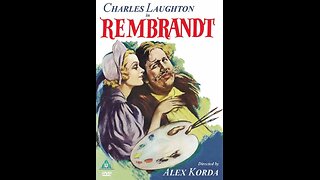 1:24:21
1:24:21
Classic Films & Movies Archive
8 days agoRembrandt (1936) | Directed by Alexander Korda
1371 -
 LIVE
LIVE
NeoX5
3 hours agoIndies for the Holidays | Holiday Rush | Ep 8 | Rumble Gaming
43 watching -
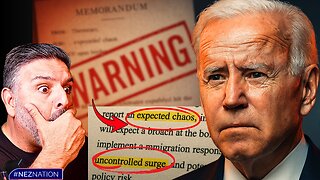 19:54
19:54
Professor Nez
3 hours ago🚨BIDEN MUST GO TO PRISON NOW! LEAKED Memo PROVES Immigration Plan
14.6K46 -
 LIVE
LIVE
Amish Zaku
1 hour agoArc Raiders - cash runs before reset week
35 watching -
 LIVE
LIVE
Biscotti-B23
3 hours ago🔴 LIVE $100+ TOURNAMENT! TSUGUKU TRIALS 🏆 DEMON SLAYER HINOKAMI CHRONICLES 2
54 watching -
 1:45:46
1:45:46
I_Came_With_Fire_Podcast
12 hours agoCatching Online Predators: Sting Operations & Saving Kids
117K6 -
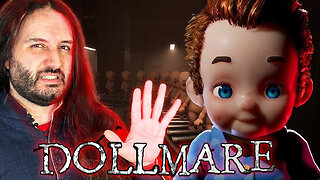 2:02:00
2:02:00
MetatronGaming
20 hours agoDollmare is a NIGHTMARE
15.7K -
 56:57
56:57
X22 Report
8 hours agoMr & Mrs X - Accusing People Of Murder Is Dangerous, Charlie Kirk's Message Was Unity - EP 19
82K74 -
 2:09:23
2:09:23
SOLTEKGG
4 hours ago🔴LIVE - ALL THE GOOP - !pc
17.9K -
 1:37:19
1:37:19
CodeBlueParadox
4 hours ago🔴LIVE - WALKING DEAD (SEASON 1) | 0/10 SUB GOAL | #LockNLoad BASH
24.4K
